InterLogix 1064107 G Truvision Navigator 5 0 Service Pack 3 User Manual En 5.0 Tru Vision
2015-08-27
User Manual: InterLogix 1064107 G Truvision Navigator 5 0 Service Pack 3 User Manual En
Open the PDF directly: View PDF ![]() .
.
Page Count: 191 [warning: Documents this large are best viewed by clicking the View PDF Link!]

TruVision Navigator 5.0
Service Pack 3 User
Manual
P/N 1064107 • REV G • ISS 09DEC14

Copyright © 2014 United Technologies Corporation
Interlogix is part of UTC Building & Industrial Systems, a unit of
United Technologies Corporation. All rights reserved.
Trademarks and
patents The TruVision Navigator 5.0 Service Pack 3 name and logo are
trademarks of United Technologies.
Other trade names used in this document may be trademarks or
registered trademarks of the manufacturers or vendors of the
respective products.
Manufacture
r
Interlogix
3211 Progress Drive, Lincolnton, NC 28092 USA
Authorized EU manufacturing representative:
UTC Climate Controls & Security B.V.,
Kelvinstraat 7, 6003 DH Weert, Netherlands
Contact Information For contact information, see www.interlogix.com or
www.utcfssecurityproducts.eu.
Version This document applies to TruVision Navigator 5.0 Service Pack 3.
Certification N0000
Software license
agreement Important: This end-user license agreement (“Agreement”) is a legal
agreement between UTC and You. By downloading, installing,
copying or otherwise using this software, you agree to be bound by
the terms of this Agreement. If you do not agree to the terms of this
Agreement, you may not download, install, copy or use the software,
and you may return the software within thirty days (30) days and
request a refund of the license fee.
1. Definitions. The following definitions apply to this document:
“UTC”, means UTC Fire & Security Inc., a Delaware corporation.
“You” means the natural person or the entity that is agreeing to be
bound by this Agreement, their employees and third party
contractors that provide services to you.
“Software” means the software products that are licensed to You
under this Agreement and any upgrades, modified versions, updates,
additions, and copies of the Software furnished to You during the
term of the license granted herein.
“Customer” means the person or organization, or parent or
subsidiary thereof, who uses the Software for its intended purposes,
and excludes distributors, authorized resellers, value added resellers
and original equipment manufacturers. Customer may be referred to
as You or Your, whether an individual or a business entity of any
kind.
“Machine” means the computer, workstation, terminal, or other
hardware product on which the Software is installed.
2. License. The Software is licensed, not sold. UTC shall retain all
rights to and in the Licensed Product, including, but not limited to, all
copyrights, patents, trademarks, and trade secrets incorporated in
the Licensed Products.
UTC hereby grants You a non-exclusive, non-transferable license,
without right to sublicense, to install and use the object code version
of the Software to the extent permitted by your payment of the
license fee (if applicable) and only in the country in which the
Software was acquired. Unless multiple copies are licensed, you
may not install more than one copy of the Software onto more than
one Machine.
UTC hereby grants You a non-exclusive, non-transferable license, to
make a single machine-readable copy of the Software solely for
backup or achival purposes.
You agree not to:
a. transfer or distribute the Software, in electronic format or
otherwise;
b. store the Software on a server for use by more than one terminal;
c. sell, rent, lease, or sublicense the Software;
d. copy or modify the Software for any purpose.
3. Term. This Agreement is effective until terminated. You may
terminate this Agreement by uninstalling all components of the
Software from all Machines and returning the Software to UTC. UTC
may terminate this Agreement if You breach any of these terms and
conditions. Upon termination of this Agreement for any reason, You
agree to immediately uninstall all components of the Software and
return the Software to UTC. All provisions of this Agreement relating
to (i) disclaimer of warranties; (ii) limitations on liability, remedies,
and damages; and (iii) UTC’s proprietary rights, shall survive
termination of this Agreement.
4. Reverse Engineer. The Software is delivered in object code only.
You may not alter, merge, modify, adapt, translate, decompile,
disassemble, reverse-engineer, or otherwise reduce the Software to
a human-perceivable form.
5. Limited warranty. UTC warrants that for one (1) year from the
date of delivery of the Licensed Product (Software Warranty Period),
the functions contained in the Software will be fit for their intended
purpose as described in the accompanying documentation, and will
conform in all material respects to the specifications stated in such
documentation. UTC does not warrant that the operation of the
Software will be uninterrupted or error-free. Your exclusive remedy
under this limited warranty for nonconforming Software shall be
repair or replacement of the Software, at the sole discretion of UTC.
To obtain a repair or replacement of nonconforming Software,
contact your Interlogix reseller directly or contact us online at
www.interlogix.com/customer-support during the Software Warranty.
EXCEPT FOR THE PRECEDING EXPRESS LIMITED WARRANTY,
TO THE MAXIMUM EXTENT PERMITTED BY APPLICABLE LAW,
UTC PROVIDES THE SOFTWARE WITHOUT ANY WARRANTIES
OF ANY KIN, EXPRESS, IMPLIED, OR STATUTORY. UTC
SPECIFICALLY DISCLAIMS ANY IMPLIED WARRANTIES OF
MERCHANTABILITY, FITNESS FOR A PARTICULAR PURPOSE,
AND NON-INFRINGEMENT.
6. Limitation of liability. UTC’s sole obligation or liability under this
agreement is the repair or replacement of nonconforming software
and/or defective media according to the limited warranty above. TO
THE MAXIMUM EXTENT PERMITTED BY APPLICABLE LAW, IN
NO EVENT WILL UTC BE LIABLE FOR ANY LOST PROFITS OR
BUSINESS OPPORTUNITIES, LOSS OF USE, BUSINESS
INTERRUPTION, LOSS OF DATA, OR ANY OTHER INDIRECT,
SPECIAL, INCIDENTAL, OR CONSEQUENTIAL DAMAGES
UNDER ANY THEORY OF LIABILITY, WHETHER BASED IN
CONTRACT, TORT, NEGLIGENCE, PRODUCT LIABILITY, OR
OTHERWISE. BECAUSE SOME JURISDICTIONS DO NOT
ALLOW THE EXCLUSION OR LIMITATION OF LIABILITY FOR
CONSEQUENTIAL OR INCIDENTAL DAMAGES THE PRECEDING
LIMITAITON MAY NOT APPLY TO YOU. IN ANY EVENT, UTC’S
LIABILITY WILL NOT EXCEED THE LICENSE FEE, IF ANY, PAID
BY YOU FOR THE SOFTWARE LICENSED HEREUNDER. THE
FORGOING LIMITATION WILL APPLY TO THE MAXIMUM
EXTENT PERMITTED BY APPLICABLE LAW, REGARDLESS OF
WHETHER UTC HAS BEEN ADVISED OF THE POSSIBILITY OF
SUCH DAMAGES AND REGARDLESS OF WHETHER ANY
REMEDY FAILS OF ITS ESSENTIAL PURPOSE.
7. General. The material provided to You, including the Software,
shall not be exported or reexported in violation of any export
provisions of the USA or any other applicable jurisdiction. Any
attempt to sublicense, assign, or transfer any of the rights, duties, or
obligations hereunder shall be void. This Agreement shall be
governed by and interpreted under the laws of the State of California,
United States of America, without regard to conflicts of law
provisions. You hereby consent to the exclusive jurisdiction of the
state and federal courts covering Costa Mesa, California to resolve
any disputes arising under or in connection with this Agreement.
8. Restricted rights legend. The Licensed Product is provided with
RESTRICTED RIGHTS. In the event the United States Government
or an agency thereof is granted a license, the following additional
terms apply: Restricted Computer Software, as defined in the
Commercial Computer Software– Restricted Rights clause at
Federal Acquisition Regulations 52.227-19, and the restrictions as
provided in subparagraphs (c)(1) and (c)(2) thereof; and as
applicable, the Government’s rights to use, modify, reproduce,
release, perform, display, or disclose the Software also are restricted
as provided by paragraphs (b)(2) and (b)(3) of the Rights in
Noncommercial Technical Data and Computer Software– Small
Business Innovative Research (SBIR) Program clause at DFARS
252.227-7018.
9. Acknowledgment. You acknowledge that You have read and
understand this agreement and agree to be bound by its terms. You
further agree that this agreement is the complete and exclusive
statement of the agreement between You and UTC, and supersedes
any proposal or prior agreement, oral or written, and any other
communication relating to the subject matter of this agreement.
Intended use Use this product only for the purpose it was designed
for; refer to the data sheet and user documentation. For the latest
product information, contact your local supplier or visit us online at
www.interlogix.com/customer-support .
TruVision Navigator 5.0 Service Pack 3 User Manual i
Content
Chapter 1 Overview 1
Client Software Requirements 6
Client Hardware Guidelines 6
Server Software Requirements 8
Server Hardware Guidelines 9
Chapter 2 Installation 12
Architecture 12
Installation Options 12
Languages 13
Installation – Standalone Model 13
Installation – Multi-Client Model 16
Upgrade 21
Initial Login 27
Uninstall 29
Network Time Protocol (NTP) Service 32
Windows 7 and Vista – Local Scheduling Service 33
Installing Navigator on Windows 8 platforms 35
Chapter 3 Operation 37
Adding a Single Device 37
Device Management Tool 40
Adding Cameras via Discovery Tool 42
Adding Cameras 44
Import an address book 44
Organize the Navigator 47
Find and export video 48
TruVision Navigator Player 52
Views 54
PTZ control 56
Digital Zoom 58
Tampering Monitor 58
Configure a device 59
Configure a camera 62
Device properties 64
Device disk analysis 65
Firmware upload 66
Camera search 67
ii TruVision Navigator 5.0 Service Pack 3 User Manual
Chapter 4 TruVision Navigator Settings 69
User Management & Client Software Delivery Overview 78
Fully Automated Client Software Delivery 79
Partially Automated Client Software Delivery 83
Inactivate a user 84
Restore an inactive user 85
Reset a user after lockout 88
Group management 88
Connection priority 89
Services 91
Notifications and Notifier 93
Health Diagnostics 96
Device Report 98
Database backup and restore 99
Help 100
Licensing 101
Appendix A Device Details 102
DVMRe / StoreSafe (DVR) 103
SymDec / SymSafe (DVR) 107
DVSRxU (DVR) 112
TruVision TVR10 (DVR) 116
TruVision TVR11 / TVR12 (DVR) 120
TruVision TVR20 (DVR) 124
TruVision TVR30 (DVR) 127
TruVision TVR31 (DVR) 130
TruVision TVR40 (DVR) 134
TruVision TVR41 / TVR42 (DVR) 138
TruVision Generic TVR / TVN 142
TruVision TVR60 (Hybrid DVR) 145
TruVision TVN10/20/21/50 (NVR) 150
TruVision TVN40 (NVR) 155
TruVision Software Video Recorder (SVR) 171
Platform Out of Box Experience (OOBE) 172
Appendix B Microsoft IIS Setup 178
Microsoft IIS Setup 178
TruVision Navigator 5.0 Service Pack 3 User Manual 1
Chapter 1
Overview
TruVision Navigator is video management software that enables security-related
personnel to easily and remotely gather video evidence, monitor live situations, and
configure and maintain a video surveillance system that consists of UTC digital video
recorders (devices), analog video cameras, network video recorders, and IP cameras.
TruVision Navigator provides a more intuitive way to find and provide relevant video
content. Figure 1 shows the TruVision Navigator main screen.

Chapter 1: Overview
2 TruVision Navigator 5.0 Service Pack 3 User Manual
Figure 1: TruVision Navigator Main Window
1 Navigator Panel
2 Viewer Panel
3 Collector Panel
4 Tasks Panel
5 Settings Dialog
6 Help Dialog
7 Notifier Dialog
8 Services Dialog
9 Controller Panel and Toolbar
TruVision Navigator consists of 5 panels and several major dialogs as listed above.
Panels are resizable by dragging the vertical left or right splitter bars. Arrow icons next
to panel names signify the ability to hide/unhide the panel. This provides custom
application layout styles depending on the activities that you want to perform. TruVision
Chapter 1: Overview
TruVision Navigator 5.0 Service Pack 3 User Manual 3
Navigator will remember your custom panel layout upon logout and restore you to that
same point when you log back in.
The Navigator panel is the central administration area in the software and allows you to
quickly search and access any device or camera in your system.
The Navigator features double-click or drag n’ drop capability to view cameras or
devices as a whole. By right-clicking on any object in the Navigator, you will be exposed
to a number of operations that can be performed on the object. These include health
diagnostics, device configuration, disk analysis, properties, search, firmware uploads,
and more.
This panel is permission-based, so if you do not have rights to perform certain actions,
you will not see the options.
The Viewer panel allows you to view both live and recorded video from any video source
in the system to verify and act on the content. It contains live or previous recorded
videos that can be launched from the Notifier, Navigator, or Collector.
Users have several tile layouts to choose from when arranging the video sources.
Standard tile layouts include 1×1, 2×2, 3×3, 4×4, and 5×5. We also support a Custom
Tile Layout with 1 large tile and 7 smaller surrounding tiles for additional flexibility.
Double-clicking in any single tile will bring that video to full screen. Double-clicking the
video again will restore the video to the previous tile layout. As well, Instant Replay is
available from the video tile itself by clicking on the Instant Replay icon.
If your system contains PTZ (pan/tilt/zoom) cameras, the Viewer panel has mouse
support for PTZ features from within the video tile. Left-click and move the mouse
left\right\up and down to adjust the pan and tilt of the camera. Right-click and move the
mouse up and down to allow the camera lens to zoom in and out.
The Controller panel allows you to manage video once it is loaded in the Viewer. The
Controller features a toolbar, a timeline, playback controls, and stream switching
capabilities. When a specific video tile is selected (blue outline around the video tile),
the Controller features will affect that video tile.
The Controller toolbar allows you to select all video tiles in the viewer, zoom in and out
on the timeline, center the timeline, open the PTZ control palette, perform a Go To
search, and put video in live or playback. The Snapshot button allows you to take a
snapshot of the current play time of a selected video tile and send it to the Collector for
export. The Video button allows you to send a desired video segment (of the time range
you specified with the green and red indicators) to the Collector for export.
The Controller timeline allows users to seek for video at specific points in time. Double-
clicking anywhere on the timeline will automatically playback the selected video at that
specific date and time. Use the current live/playback cursor (appears as a blue seek
triangle icon) to seek and play the video anywhere along the timeline. Use the green and
Chapter 1: Overview
4 TruVision Navigator 5.0 Service Pack 3 User Manual
red triangle icons to mark the beginning and end of a desired video segment. Use the
playback controls beneath the timeline to further manipulate playback video.
The Collector panel contains all relevant video segments, snapshots, and local
recordings ready for export. From here, you can select the desired content to export to
your hard drive on demand or via a schedule.
To re-open a video clip for further analysis, double-click the thumbnail and the video will
launch in the Viewer. You can then manipulate the timeline to refine the clip and send it
back to the Collector. To delete video clips from the Collector, click the delete icon next
to the thumbnail. Rename, print, or E-mail snapshots with a right-click of the mouse on
the thumbnail.
The Tasks panel affords the user one central place to monitor the tasks that have been
created and scheduled in the system. These tasks include video exports, firmware
upgrades, bulk configurations, database backups, and database restores. The Tasks
panel provides a real-time status of the tasks in the queue, and the reason if a task was
unsuccessful.
The Settings dialog allows the user to configure several options within the application.
These include settings for client, server, notifications, and health diagnostics.
Client settings apply to each client station. These settings include CPU threshold control,
POS activation, aspect ratio and bandwidth controls for video monitoring, and audio
activation. Enable the maximum CPU threshold here to prevent your CPU from reaching
100% during video rendering. As with all applications, you will experience lockups as
you reach 100% CPU.
Enable your alert sound when new device notifications are received in TruVision
Navigator's Notifier.
Enable the aspect ratio for live and playback video in the Viewer.
Server settings include the SMTP server settings, permission settings, custom help link
settings, and server/client URL information.
Notifications settings include the network settings necessary to receive events from each
device. Also, this menu includes the e-mail notification settings as well as a filter of
specific notification types.
Health diagnostics settings include a filter of diagnostics to be received, as well as e-mail
settings to receive notifications of diagnostics information. Also, automatic diagnostic
polling can be scheduled from this menu.
The Help dialog offers an easy to use Help function for more detailed system
instructions. You can also obtain TruVision Navigator version information, copyright, and
end user license agreement information here. Organizations have the ability to add their
own custom Help or training link here to facilitate the adoption of the product. This menu
Chapter 1: Overview
TruVision Navigator 5.0 Service Pack 3 User Manual 5
also includes the licensing screen for TruVision SVR recorder. Please see TruVision
SVR User Manual for more information on licensing.
The Notifier dialog allows you to collect and manage any notifications sent to you from
the devices. You can select an alert in the Notifier panel and view the video results in the
Viewer panel. You must configure your devices to send these notifications over the
network via TCP or SMTP to the IP address of the TruVision Navigator Server machine.
In addition, the firewall must be configured on the TruVision Navigator Server machine to
accept these network notifications.
These notifications may include Alarm, Video Loss, Motion, Fan Failed, Disk Failed,
User Locked at Device, Video Erased, Disk Full, Device Powered Up, and more
depending on the device model.
The Services dialog shows general information on all of the TruVision Navigator
services including Network Time Protocol, Diagnostic Polling, and Notification Service.
This includes the service name, location, status, and the ability to start, stop, or disable
the service. Standalone installations will only show the Network Time Protocol service in
this dialog since the other services are embedded in Settings menu.

Chapter 1: Overview
6 TruVision Navigator 5.0 Service Pack 3 User Manual
Client Software Requirements
TruVision Navigator supports all of the following Operating Systems and other software
components.
Table 1: Client Software Requirements
Component Version Notes
Operating
System Microsoft Windows XP Pro SP3 Prerequisite to loading
TruVision Navigator
Microsoft Windows Vista SP1 32-bit / 64-bit Prerequisite to loading
TruVision Navigator
Microsoft Windows 7 32-bit / 64-bit Prerequisite to loading
TruVision Navigator
Microsoft Windows 8 32-bit/ 64-bit Prerequisite to loading
TruVision Navigator
(WinPCAP needs to be
installed separately and ran
in compatibility mode for
operation on Windows 8
systems)
Microsoft Windows Server® 2003 R2 32-bit Prerequisite to loading
TruVision Navigator
Microsoft Windows Server® 2008 R2 32-bit /
64-bit Prerequisite to loading
TruVision Navigator
Other Microsoft .NET Framework 4.0 Packaged with the
installation
Client Hardware Guidelines
The PC industry is constantly improving on product performance / configurations while
reducing cost to the customer.
As a result, we have listed some Client PC specifications for TruVision Navigator as to
what is commercially available in August 2013.
These specifications are meant to serve as a GUIDELINE for the customer. TruVision
Navigator will perform to varying degrees on lesser or more robust machines.
Please review the Expected Performance metrics at the bottom of the table to determine
what will meet your needs. You can make your PC decision based upon that need.

Chapter 1: Overview
TruVision Navigator 5.0 Service Pack 3 User Manual 7
Table 2: Client PC Hardware Specifications
Component Minimum Recommended High Notes
Processor 3rd Gen Intel
Core i3-3220
Processor (Dual
Core, 3.30GHz,
3MB, w/
HD2500
Graphics)
3rd Gen Intel
Core i5-3470
Processor
(6MB, 3.2GHz)
w/HD2500
Graphics
3rd Gen Intel
Core i7-3770
Processor
(8MB, 3.4GHz)
w/HD4000
Graphics
CPU power is directly
related to the
performance of the
application when running
and rendering video. The
better the CPU, the more
responsive your
application will be.
Memory 4GB, NON-
ECC, 1600MHZ
DDR3,2DIMM
6GB, NON-
ECC, 1600MHZ
DDR3,2DIMM
8GB, NON-
ECC, 1600MHZ
DDR3,2DIMM
RAM is related to the
number of different
applications that can run
simultaneously as well as
the number of different
operations that TruVision
Navigator can perform at
once. The higher the
RAM, the better
performance you can
expect.
Hard Drive 500GB -
7200RPM,
SATA 3.0Gb/s,
16MB Cache
500GB5 -
7200RPM,
SATA 3.0Gb/s,
16MB Cache
500GB5 -
7200RPM,
SATA 3.0Gb/s,
16MB Cache
Optional - TruVision
Navigator requires
approximately 880 MB to
install. If you wish to
store exported video from
the devices on the
machine, you may want
to increase storage.
Graphics Card Intel Integrated
Graphic
w/Single
HDMI/VGA
Dual 1GB AMD
Radeon™HD
7470
Dual 1GB AMD
Radeon™HD
7470
Video Card capability is
directly related to the
video rendering
performance within
TruVision Navigator. The
better the video card, the
better video rendering
performance you can
expect.
Resolution 1024 x 768 1024 x 768 1024 x 768
Network Integrated PCIE
10/100/1000
Integrated PCIE
10/100/1000
Integrated PCIE
10/100/1000
The network interface card
can be a performance bottle
neck depending upon the
throughput of the card. If the
card’s throughput is less
than the amount of data
streaming to the machine,
you will experience
performance issues.

Chapter 1: Overview
8 TruVision Navigator 5.0 Service Pack 3 User Manual
Server Software Requirements
TruVision Navigator supports all of the following Operating Systems and other software
components.
Table 3: Server software requirements
Component Version Notes
Operating
System Microsoft Windows XP Pro SP3 Prerequisite to loading
TruVision Navigator
Microsoft Windows Vista SP1 32-bit / 64-bit Prerequisite to loading
TruVision Navigator
Microsoft Windows 7 32-bit / 64-bit Prerequisite to loading
TruVision Navigator
Microsoft Windows 8 32-bit/ 64-bit Prerequisite to loading
TruVision Navigator (WinPCAP
needs to be installed
separately and ran in
compatibility mode for
operation on Windows 8
systems)
(SQL drivers need to be
installed for Windows 8 before
Navigator installation)
Microsoft Windows Server® 2003 R2 32-bit Prerequisite to loading
TruVision Navigator
Microsoft Windows Server® 2008 R2 32-bit / 64-
bit Prerequisite to loading
TruVision Navigator
Web Service Microsoft Internet Information Services (IIS) 6.0
or higher Prerequisite to loading
TruVision Navigator
Cassini Packaged with the installation
Database Microsoft’s SQL 2008
Microsoft’s SQL Express 2008 R2
Microsoft’s SQL Express 2008
R2 is packaged with the
installation.
Microsoft SQL is not required
for Standalone installation

Chapter 1: Overview
TruVision Navigator 5.0 Service Pack 3 User Manual 9
Other Microsoft .NET Framework 4.0 Packaged with the installation
Other WinPCAP 4.1.2 Packaged with the installation
Server Hardware Guidelines
This specification is meant to serve as a GUIDELINE for the customer. TruVision
Navigator will perform to varying degree on a lesser or more robust machine. Table 5
lists the recommended server hardware specification.
Table 4: Server Hardware Specifications
Component Recommended Notes
Processor 3rd Gen Intel Core i5-3470
Processor (6MB, 3.2GHz)
w/HD2500 Graphics
Memory 6GB, NON-ECC, 1600MHZ
DDR3,2DIMM
Hard Drive 500GB5 - 7200RPM, SATA
3.0Gb/s, 16MB Cache Optional - this storage requirement will
vary widely depending on many factors
including whether or not the database is
being hosted on the server, the size of the
actual database, and whether or not you
want to store video on the server.
Graphics Card Dual 1GB AMD Radeon™HD
7470 Optional - depending on whether or not
you want to view video from a Client on
this machine.
Network 1024 x 768
Intergrated PCIE 10/100/1000
Supported Video Units
Table 6 shows the supported devices and related firmware versions.
Table 5: Supported Recording Devices
UTC Devices Supported Firmware
TruVision NVR20* 2.0h
TruVision NVR50* 1.0m
TruVision TVN10 1.1
TruVision TVR20* 1.0.36

Chapter 1: Overview
10 TruVision Navigator 5.0 Service Pack 3 User Manual
TruVision TVN21(P) 2.0
TruVision DVR12 1.0
TruVision DVR41* 1.0
TruVision DVR42 1.0
TruVision NVR40 (TVN40)* 4.2.1 Changelist 53820
TruVision DVR60 (TVR60) 4.0
TruVision DVR40 (TVR40)* V3.0 build 100416
TruVision DVR31* 8000
TruVision DVR30 (TVR30)* 0453-0329-0552-4723
TruVision DVR10 (TVR10)* 2.0 Build 090722 and 2.2 Build 091210
TruVision DVR11 (TVR11c)* 1.0m
TruVision DVR11 (TVR11)* 1.0k
TruVision SVR* 7.0.825
SymDec 16 plus 4* 1.46r, 1.47k, 1.51e, 1.52b, and 1.53
SymDec 4* 1.47e and 1.48a
SymDec 1* 1.47e and 1.48a
SymSafe Pro Series* 1.27b, 1.28i, 1.30b, 1.31.b, and 1.32
SymSafe Basic Series* 1.27b, 1.28i, 1.30b, 1.31.b, and 1.32
DVSRxU* V2.3 build 091110 (V2.31S)
DVMRE CT (Triplex) Series* 5.68a, 5.69, 5.71, and 5.72
DVMRE CT II Series* 6.28a, 6.29, 6.31, and 6.32
DVMRE PRO Series* 5.68a, 5.69, and 5.71
DVMRE ezT Series* 5.68a, 5.69, and 5.71
DVMRE CS Series* 5.21
DVMRE CD Series* 3.24
StoreSafe Series* 5.68a, 5.69, 5.71, and 5.72
StoreSafe Pro II Series* 6.28a, 6.29, 6.31, and 6.32
StoreSafe Advanced Series* 6.28a, 6.29, 6.31, and 6.32

Chapter 1: Overview
TruVision Navigator 5.0 Service Pack 3 User Manual 11
DSR* 2.23d and 2.24a
DVSE Series* 1.20g, 1.41w, and 3.04
* These models are in End of Life status and are not actively supported.
TruVision Navigator 5.0 Service Pack 3 User Manual 12
Chapter 2
Installation
Architecture
TruVision Navigator is made up of 3 components:
• Client
• Services
• Database
The TruVision Navigator architecture is flexible enough to allow all 3 of these
components to co-exist on the same PC (i.e. a single Windows 7 machine) in small-
scale environments.
As well, TruVision Navigator allows each of these 3 components to operate on separate
machines (i.e. a virtual server for Services, a dedicated database machine for Database,
and multiple PCs distributed on the network hosting Clients) for large- scale, distributed
environments.
Installation Options
There are 2 installation options for TruVision Navigator:
Standalone Model (or Direct Database Connection) - this installation option allows
the Client, the Database, and the Services to be located on the same machine. The one
limitation is that no other Clients on the network can connect to the database on this
machine. This installation option is ideal for small, standalone systems.
Multi-Client Model (or Traditional Client/Server) - This installation option allows the
Client, the Database, and the Services to be located on the same or separate machines.
This option requires a Web Service (either Microsoft’s Internet Information Services (IIS)
or Cassini) for communication between the multiple Clients and the shared Database.
This installation option is ideal for larger systems with many geographically dispersed
users, PCs, and recording devices.
Chapter 2: Installation
TruVision Navigator 5.0 Service Pack 3 User Manual 13
Whatever installation option you choose, the core features and functions of TruVision
Navigator remain the same.
You will need Administrator’s rights on the machine to install the application, but the
software will be available to all users who successfully log on to a Windows account on
that machine.
Languages
The following languages are supported in TruVision Navigator: Arabic, Chinese
(Simplified and Traditional), Czech, Danish, Dutch, English, Finnish, French, German,
Hungarian, Lithuanian, Italian, Polish, Portuguese, Russian, Slovak, Spanish, Swedish,
and Turkish.
After launching the TruVision Navigator Installation Setup.exe, the InstallShield Wizard
will auto-detect the language setting on the PC, and if it is supported, will translate to
that language. If the language detected is not supported, the InstallShield Wizard will
default to English.
Upon launching the Client, TruVision Navigator will always auto-detect the language
setting on the PC, and if it is supported, will translate to that language. If the language
detected is not supported, the Client will default to English.
Installation – Standalone Model
To install a new standalone instance of TruVision Navigator on your computer do the
following:
Place the TruVision Navigator setup.exe program on the desktop of the PC.
Launch the InstallShield Wizard from the auto-run page or double-click the TruVision
Navigator setup.exe to begin the installation.
The Welcome window displays.

Chapter 2: Installation
14 TruVision Navigator 5.0 Service Pack 3 User Manual
Figure 2: InstallationShield Wizard
Click Next.
The Choose Destination Folder window displays.
Figure 3: Choose Destination window
Browse for a destination folder for the TruVision Navigator payload or accept the default
location and click Next.
The Database Connection Model window displays.

Chapter 2: Installation
TruVision Navigator 5.0 Service Pack 3 User Manual 15
Figure 4: The Database Connection Model window
Select the Standalone Model (Direct Database Connection) option and click Next.
The Installation Confirmation window displays.
Figure 5: The Installation Confirmation window
Review the installation confirmation page and click Next to proceed with the installation.
If you want to make changes, use the Back button to go back and adjust your
selections.

Chapter 2: Installation
16 TruVision Navigator 5.0 Service Pack 3 User Manual
Once the installation is finished, The Installation Complete screen displays.
Figure 6: The Installation Complete window
Select the Yes, I want to restart my computer now option and click the Finish button.
A TruVision Navigator icon will be placed on your desktop and in your Start Menu to
access the application.
Installation is complete.
Installation – Multi-Client Model
To install a new traditional Client/Server instance of TruVision Navigator on your
computer do the following:
Place the TruVision Navigator setup.exe program on the desktop of the PC.
Launch the InstallShield Wizard from the auto-run page or double-click the TruVision
Navigator setup.exe to begin the installation.
The Welcome window displays.

Chapter 2: Installation
TruVision Navigator 5.0 Service Pack 3 User Manual 17
Figure 7: Installation Shield Wizard
Click Next.
The Choose Destination Folder window displays.
Figure 8: Choose Destination window
Browse for a destination folder for the TruVision Navigator payload or accept the default
location and click Next.
The Database Connection Model window displays.

Chapter 2: Installation
18 TruVision Navigator 5.0 Service Pack 3 User Manual
Figure 9: The Database Connection Model window
Select the Multi-client Model (using IIS or Cassini Web Server) option and click Next.
Note: Microsoft’s IIS is the preferred model for Multi-Client Model (i.e. Traditional
Client/Server) systems, assuming it is pre-loaded on your system. However, if you do
not have IIS pre-loaded, the installer will offer you the Cassini Web Server option as an
alternative. See Appendix B “Microsoft IIS Setup” on page 178 for setup instructions.
The Web Server Configuration window displays.
Figure 10: The Web Server Configuration Window
Select the Default Configuration option and click Next.

Chapter 2: Installation
TruVision Navigator 5.0 Service Pack 3 User Manual 19
Note: We do offer Advanced Web Server settings. To explore those settings, select the
Advanced option and proceed with the on- screen instructions.
The Database Server window displays.
Figure 11: The Database Server window
Select the Database Server from the drop-down list and click Next.
Note: We do offer Advanced Database Installation settings. To explore those settings,
select the Advanced option and proceed with the on-screen instructions.
The Installation Confirmation window displays.

Chapter 2: Installation
20 TruVision Navigator 5.0 Service Pack 3 User Manual
Figure 12: Installation Confirmation Dialog
Review the installation confirmation page and click Next to proceed with the installation.
If you want to make changes, use the Back button to go back and adjust your
selections.
The Installation Complete screen displays.
Figure 13: The Installation Complete window

Chapter 2: Installation
TruVision Navigator 5.0 Service Pack 3 User Manual 21
Select the Yes, I want to restart my computer now option and click the Finish button.
A TruVision Navigator icon will be placed on your desktop and in your Start Menu to
access the application.
Installation is complete.
Upgrade
TruVision Navigator offers upgrade paths from TruVision Navigator v4.0, TruVision
Navigator v4.0 SP1, SP2, SP3, SP4, SP5 and SP6 releases.
Note: You cannot use this upgrade procedure for earlier TruVision Navigator v4.0
releases.
Upgrade for Client Server Installations
To upgrade from a previous version of TruVision Navigator, do the following:
Place the TruVision Navigator setup.exe program on the desktop of the PC.
Launch the InstallShield Wizard from the auto-run page or double-click the TruVision
Navigator setup.exe to begin the installation.
The Welcome window displays.
Figure 14: Installation Shield Wizard
Click Next.

Chapter 2: Installation
22 TruVision Navigator 5.0 Service Pack 3 User Manual
The Choose Destination Folder for Upgrade window displays.
Figure 15: Setup Type window
Installer will proceed with a prerequisite component install. WinPcap is one of the
required components for upgrades from previous versions to v5.0. (except 4.0 SP6).
Figure 16: The Setup Status window
Proceed to the next steps and accept the license agreement of WinPcap and click next
to finish the WinPcap installation. Once the installation finishes, installer will continue to
install TruVision Navigator.

Chapter 2: Installation
TruVision Navigator 5.0 Service Pack 3 User Manual 23
Figure 17: The Previous Instance Install Directory window
Previous Server Components will be uninstalled automatically.
Figure 18: The New Instance Install Directory window
After the previous version of Navigator is removed, installer will continue with the
installation of new TruVision Navigator version.

Chapter 2: Installation
24 TruVision Navigator 5.0 Service Pack 3 User Manual
Figure 19: The Installation Confirmation window
a
Once all components of TruVision Navigator are installed, the Installation Complete
screen displays.
Figure 20: The Installation Complete window
Select the Yes, I want to restart my computer now option and click the Finish button.
Installation is complete.

Chapter 2: Installation
TruVision Navigator 5.0 Service Pack 3 User Manual 25
Upgrade for Standalone Installations
Figure 21: Database Selection window
After the database is selected, upgrade confirmation screen displays.
Figure 22: Upgrade Confirmation window
Click next on the upgrade confirmation screen to proceed with installation. Once the
installation is finished, the Installation Complete screen displays.

Chapter 2: Installation
26 TruVision Navigator 5.0 Service Pack 3 User Manual
Figure 23: Upgrade Confirmation window

Chapter 2: Installation
TruVision Navigator 5.0 Service Pack 3 User Manual 27
Initial Login
After successful installation, launch TruVision Navigator using one of the following
methods:
• Double-clicking on the TruVision Navigator icon on your desktop.
• Access the Start menu, All Programs, and TruVision Navigator.
When TruVision Navigator launches, a login window displays. Log in as the default
Administrator using the following default credentials:
Username - admin
Password - admin
Figure 24: Login window
After initial login, a window displays prompting you to change the default admin
password which protects its security.

Chapter 2: Installation
28 TruVision Navigator 5.0 Service Pack 3 User Manual
Figure 25: Change Password Dialog
To change the password, do the following:
Enter the new password in the Password field.
Re-enter the password in the Confirm Password field.
Select one of the following challenge questions from the drop-down list.
Enter the answer to your challenge question in the Challenge Answer field.
Press OK.
If you ever forget your password, simply click on the Forgot? button on the Login dialog.
This will allow you to answer your challenge question, and if successful, change your
password and re-enter the application without calling for any assistance. In case you
don’t remember the Challenge Answer to recover your password, click on Forgot? button
once again, and call UTC technical support team with the “tech support key”
automatically provided in the related field. Technical support team will recover your
password with this information.

Chapter 2: Installation
TruVision Navigator 5.0 Service Pack 3 User Manual 29
Figure 26: User Account Challenge Dialog
Uninstall
To uninstall TruVision Navigator do the following:
Launch the Add/Remove Programs application from Windows Control Panel.
Navigate to TruVision Navigator Server and click on the Remove or Uninstall button.
Figure 27: Add or Remove Programs window

Chapter 2: Installation
30 TruVision Navigator 5.0 Service Pack 3 User Manual
The InstallShield window appears and the application will prepare to remove your
selection.
Figure 28: InstallShield Wizard window
Click the Yes button when this window appears.
Figure 29: Confirmation window
The uninstall will begin and the status window will appear.

Chapter 2: Installation
TruVision Navigator 5.0 Service Pack 3 User Manual 31
Figure 30: Setup Status window
When complete, click on the Finish button and restart your computer.
Figure 31: Uninstall Complete window
Repeat these same uninstall steps for the TruVision Navigator Client application in the
Add or Remove Programs window.
Note: This process will remove all TruVision Navigator files and logs from your system.
No Registry edits are necessary to remove TruVision Navigator from the machine.

Chapter 2: Installation
32 TruVision Navigator 5.0 Service Pack 3 User Manual
Network Time Protocol (NTP) Service
The TruVision Navigator Server has the ability to act as an NTP Service for devices on
the network (you also have the flexibility to use other 3rd party NTP Services should you
choose).
Enable the NTP Service in TruVision Navigator by going to Start – All Programs –
TruVision Navigator – Enable NTP Service. This will enable the NTP Service on the
TruVision Navigator Server. You will need to configure the device’s NTP Server field
with the IP Address of the TruVision Navigator Server where this NTP Service is
running.
Figure 32: Enable NTP Service dialog
If your system is closed (meaning no Internet access), the devices configured to point to
the TruVision Navigator NTP Service will use that server machine’s CMOS clock. Please
ensure this clock is up to date. If your system is open (meaning it has Internet access),
you can still have the devices point to the TruVision Navigator NTP Service for time sync
AND have the TruVision Navigator NTP Service point externally to a time reference
server to maintain that system time. This alleviates the maintenance of manually
ensuring the time on the TruVision Navigator Server is up to date.

Chapter 2: Installation
TruVision Navigator 5.0 Service Pack 3 User Manual 33
Figure 33: NTP Diagram
Windows 7 and Vista – Local Scheduling
Service
If this is a Windows 7 or Vista installation, you may experience issues with your Local
Scheduling Service. The Local Scheduling Service on the Client machine is responsible
for executing all tasks on behalf of the Client. These tasks include video exports,
firmware upgrades, bulk configurations, and database backup/restores.
To be sure that you do not have issues, you can perform the following steps below:
If you have Admin privileges on the machine:
Open up Windows Explorer and locate the directory where the TruVision Navigator
application is installed. By default, TruVision Navigator is placed in C:\Program
Files\Interlogix\TruVision Navigator. If you changed that default pathway, navigate to the
revised location now.
Open the "ClientInstaller" folder and find the TruVision Navigator Client.exe.
Right-click on the executable and select "Properties".
Click on the Compatibility Tab and check the "Run the program as an administrator"
option.
Click OK.
Login to the application and begin using TruVision Navigator.

Chapter 2: Installation
34 TruVision Navigator 5.0 Service Pack 3 User Manual
Figure 34: TruVision Navigator Client Properties
If you do NOT have Admin privileges on the machine, contact your Administrator to
turn off the User Account Control (UAC) for the user who will be running the TruVision
Navigator Client.
To do so, have the Admin perform the following steps:
Click the Start button and under the "Start Search" section, enter MSCONFIG.
Click Enter.
On the System Configuration Window, select the Tools Tab.
Highlight the Disable UAC row and click the Launch button.
Restart the machine.
Upon restart, the user can login to the application and begin using TruVision Navigator.

Chapter 2: Installation
TruVision Navigator 5.0 Service Pack 3 User Manual 35
Figure 35: Disable UAC
Installing Navigator on Windows 8 platforms
TruVision Navigator can be installed on Windows 8 platforms with a couple of
prerequisites met before installation. Microsoft Windows 8 OS needs to support
Microsoft SQL database drivers fully before the TruVision Navigator installation starts.
Therefore, these prerequisites are needed to make your system ready for TruVision
Navigator installation.
Please follow below instructions before installing Navigator on Windows 8 platforms.
1. Client/Server type installations: There are two scenarios:
a. Windows 8 (without SQL installed)
i. Must install all the important updates from Microsoft.
ii. Install WinPcap 4.1.2 manually prior to, or, after installing Navigator.
iii. Enable IIS (Internet Information Services ) from Control panel \ Programs and
features\ Turn Windows Features on or Off\ IIS ( with all belonged its
components underneath).
iv. Navigator will install SQL 2008 express when detecting no SQL installed in
the machine.
b. Windows 8 (with SQL2008 Express R2 – SP1 or SP2 installed)
i. Must install all the important updates from Microsoft.
ii. Install WinPcap 4.1.2 manually prior to, or after installing Navigator.
iii. Enable IIS (Internet Information Services) from Control panel \ Programs and
features\ Turn Windows Features on or Off\ IIS (with all belonged its components
underneath).
Chapter 2: Installation
36 TruVision Navigator 5.0 Service Pack 3 User Manual
iv. Navigator will allow user to use existing SQL 2008 Express.
2. To make the WinPCAP compatible with Windows 8:
a. Right click on WinPcap.exe file
b. Select Properties
c. Compatibility
d. Check Run this program in compatibility mode for: Select Windows 7 and
click Apply.
e. Right click on WinPcap.exe and select Run as Administrator.
TruVision Navigator 5.0 Service Pack 3 User Manual 37
Chapter 3
Operation
Adding a Single Device
Add a single device to the Navigator by doing the following:
Click the Add Device button in the Navigator. Drop down menu displays with the
following options:
- Add Manually
- Add Via Discovery Tool
Adding Devices Manually
Once Add Manually option is selected, below screen will display for required input.

Chapter 3: Operation
38 TruVision Navigator 5.0 Service Pack 3 User Manual
Figure 36: Add Device window (Manually)
Note: After you click OK, fields highlighted with a red exclamation point indicate rejected
values. Place your mouse pointer over the exclamation points for tips on why your
values were invalid. All fields must be valid to successfully add a device.
• Enter a Device Title. Values are alphanumeric.
• Select the appropriate Device Type from the drop-down menu.
• Based on your device type, you may need to select a Streaming Type. For some
devices, there is only one option for the Streaming Type so it is selected by default.
The Streaming Types are defined as follows:
• TCP - TCP is a reliable stream delivery service that guarantees delivery of a data
stream sent from one host to another without duplication or losing data.
• Reverse TCP - the application connects to the device and the device streams
video back to the application over the existing connection. This option negates
firewall issues on a WAN and is primarily the best option.
• Reverse TCP I-Frame - this connection type is similar to the Reverse TCP
except the device only sends I-Frames. This option is useful in limited bandwidth
environments.
• UDP - the application connects to the device and asks the device to stream video
back to the application on a UDP address and port. For this option, the firewall
needs to be configured to allow the device to stream to the application on that
specific port.
Chapter 3: Operation
TruVision Navigator 5.0 Service Pack 3 User Manual 39
• Wavelet/Wavejet - This type is based upon Wavelet/Wavejet compression
methodologies. This streaming type cannot be changed and is the default
streaming type for the DVMRe and StoreSafe DVR lines.
• Enter the device's IP Address, or, the DynDNS or EzDDNS URL.
Note: You can add a device using a Domain Name System (DNS) name as well as a
static IP Address. Simply place the DNS name in the IP Address field on the form
.• Enter the device's listen Port. This field is pre-populated with a default value based
upon the type of device you selected. If you changed this port on the device, add that
specific port in this field.
Note: The port number must be added to the device address when using DynDns
with a HTTP port other than port 80 (i.e. mydvr.dyndns.org:2222 if the HTTP port
being used is 2222). When using No-IP instead of DYNDNS, you also need to add
the HTTP port number.
• Enter the Username and Password. This field is only required if the device being
added has been configured to require a username and password.
• Check the Add Device Offline checkbox if you wish to add the device to the
Navigator but you know the device is currently offline.
• Click OK.
Note: You may see an error message stating that your device was added but it has
unsupported firmware. However, you should still be able to view video. See the
supported devices and firmware versions section of this document.
Adding Devices via Discovery Tool
Once Add Via Discovery Tool option is selected, device discovery window will display.
Device discovery window provides a list of available devices in the network. To add
devices to the Navigator, select one or multiple devices from the list and click Add. Your
device should appear under the Device node in the Navigator panel.
Note: Discovery Tool will attempt to add devices by using their default credentials. If the
credentials of a device are previously changed from default values, device is still going
to be added to the device tree, but will be shown as offline. In this case, updated
credentials need to be applied manually by user from the device properties or
configuration menu with a right click on the device.
Once the recorder shows online, expand the device icon to view your cameras. If you
chose to add the device offline via the Add Device Offline checkbox, your device will
appear in the Navigator with a red X on it. You can bring the device online by right-

Chapter 3: Operation
40 TruVision Navigator 5.0 Service Pack 3 User Manual
clicking on the device and selecting Connect. Upon successful connection, the Navigator
will populate the respective cameras under the device.
Figure 37: Connect to off-line device
If you have channels on a DVR that will not be used, you can mark them as "unused" so
they do not appear in the Navigator under the DVR. To do this, go to the Camera Title
section under the DVR Configuration menus, mark the "Camera Not in Use" check box,
and click Save. This will hide the cameras in the Navigator. To show them again, simply
un-check the same box in the configuration and click Save.
Device Management Tool
Device Management tool provides various information and functions to ensure the ease
of system setup and maintenance. To access to the device management interface;
• Right Click [Devices] and select [Device Management]

Chapter 3: Operation
TruVision Navigator 5.0 Service Pack 3 User Manual 41
Figure 38: Device Management Window
The discovery tool window includes following areas and device management functions
• Device List
• Assigning IP Address to a device
• Pinging device(s)
• Rebooting device(s)
• Opening Web Page of a device
• Checking default credentials of device(s)
Device List
Provides a list of devices in the network. For convenience, devices can be grouped
together by their type (recorder, camera, or both), or brand. List can also be sorted by
one of the columns by keeping the selected groupings.
‘Connected To’ column provides the information on the recorder each camera is
recording to. Empty field indicates that the camera is discovered in the network, but is
not assigned to a recorder yet.
Device list also provides the following device information: Model Name, IP Address and
Port, Subnet Mask, Firmware Version, MAC ID and Serial Number.
Chapter 3: Operation
42 TruVision Navigator 5.0 Service Pack 3 User Manual
In addition, the Status column provides the results of the Ping, Assign IP Address, Get
Firmware Version and Reboot commands.
Assign IP Address
Allows the users to assign IP address to a camera.
1. Select a camera from the device discovery list
2. Click [Change IP Address] button located at the top menu of discovery tool.
3. Enter the [New IP Address] to the related field, and click [Ok]
Ping
Allows the users to ping device(s) to check the link activity. Status of the ping command
is given in the “Status” field.
Reboot
Allows the user to remotely reboot device(s) with one click. Status of the reboot
command is given in the “Status” field.
Opening Webpage of a Device
Allows the user to open the web browser menu of a device.
Checking default credentials of a device
Allows the user to check if device credentials are changed from the default values.
Adding Cameras via Discovery Tool
TruVision Navigator is equipped with an embedded device discovery tool that discovers
the devices in the network, and lets the user to add one or more of those devices to the
Navigator.

Chapter 3: Operation
TruVision Navigator 5.0 Service Pack 3 User Manual 43
Figure 39: Discovery Tool Window
Device discovery tool provides an easy way to discover the devices and make them
ready for recording in the system. Device discovery tool is available via various paths in
TruVision Navigator, and is used for discovering recorders, cameras, and encoders in
the network.
Following are the paths and functions device discovery tool can be located and used for:
• Right Click on a recorder in device tree,
• Click [Add IP Cameras], and select [Add via Discovery Tool]
• A list of discovered cameras in the network will be given. Select desired cameras
and click [Add].
• Selected cameras should be automatically added under the selected device in
Navigator.
Note: Discovery Tool will attempt to add cameras by using their default
credentials. If the credentials of a camera are previously changed from default
values, camera is still going to be added to the device tree, but will be shown as
offline. In this case, updated credentials need to be applied manually by user
from the camera configuration menu with a right click on the device/camera.
Chapter 3: Operation
44 TruVision Navigator 5.0 Service Pack 3 User Manual
Adding a TruVision 360 Camera
TruVision Navigator 5.0 SP3 supports the Interlogix 360 degree panoramic cameras.
These cameras can be added to TruVision NVRs as a regular IP camera, manually, or,
via discovery tool.
Each Panoramic camera provides five streams to the user.
- 1x Raw 360 degree image
- 1x Two 180 degree bands in one video stream
- 3x 120 degree streams with digital PTZ capability
When a panoramic camera is added to a device, the camera will show up in the device
tree, and have its own node with up to five channels listed under it. By default, the
panoramic camera will be added with only 360 degree mode enabled. To add the rest of
the views:
- Right click on the camera and select properties.
- In the properties menu, select the views desired, and click Ok.
Import an address book
Prior to importing an existing WaveReader or SymNav address book, you must first
export the address book from either of those applications.
For WaveReader, use export Option 1 to export to a comma-delimited file.
For SymNav, use the Comma Delimited File option.
Both these options will export to a text (.txt) file.
Save that file to a location where you will perform your import to TruVision Navigator.
Once that is complete, login to TruVision Navigator and perform the following steps:
Right-click on the Devices node in the Navigator and select Import Address Book.

Chapter 3: Operation
TruVision Navigator 5.0 Service Pack 3 User Manual 45
Figure 40: Import Address Book from Devices node
Select WaveReader or SymNav from the Files of Type drop-down menu.
Browse and locate the .txt export file that you have saved and click Open.
Figure 41: Address Book import
Your successfully imported devices are instantly placed by default in a newly created
import folder with a time/ date stamp. These devices have been imported as off-line
devices (signified by the red X on the device). To connect to an off-line device right-click
on the device and select Connect.

Chapter 3: Operation
46 TruVision Navigator 5.0 Service Pack 3 User Manual
Figure 42: Address Book import - Offline devices

Chapter 3: Operation
TruVision Navigator 5.0 Service Pack 3 User Manual 47
Organize the Navigator
The Navigator allows you to organize your devices in a logical manner. As systems get
a larger, this will enable you to find your devices and cameras more easily.
To organize your Navigator, do the following:
In the Navigator, click the Add Folder button. This creates a new folder.
Enter a name for the new folder and press Enter.
To add a sub-folder within the previously created folder, right-click on the parent folder
and select Add Folder from the context menu.
Figure 43: Navigator folders
Click and drag devices into folders or folders within folders until your organization is
complete. Remember that cameras will always stay attached to their respective devices.
Another easy way to find any object (user, group, folder, device, or camera) in the
Navigator is to use the Search at the top of the panel. Simply type any alphanumeric
string into the Search field and press Enter. Focus will go instantly to the object that
matches the string. Press Enter again to move to the next object that matches the
string, and so on, until you have been to each object. Enter a different alphanumeric
string to perform another search.

Chapter 3: Operation
48 TruVision Navigator 5.0 Service Pack 3 User Manual
Find and export video
There are three ways to load video from the Navigator into the Viewer:
Drag n’ drop a specific camera to the Viewer
Drag n’ drop a specific device to the Viewer which will load all of the cameras applicable
to the device
Double-click on a specific camera
Figure 44: Viewer and Controller
By default, video will be loaded in the Viewer in Live mode. Video status (Live or
Playback), camera type, and device name can be found in the video tile status bar (thick
bar at the bottom of the video tile) along with the Instant Replay and Close Video Tile
buttons.
To go from Live to Playback video, you must first select camera(s) in the Viewer by
clicking on that video tile - a blue frame should surround the selected video tile. If you
want to select multiple video tiles, use the Select All check box in the Controller.
Chapter 3: Operation
TruVision Navigator 5.0 Service Pack 3 User Manual 49
Once video tiles are selected, perform one of the following operations to retrieve
Playback video (assuming there is video on the device for the specified time):
• Go To Search – click on the Go To button in the Controller, enter a date and time,
and click OK. Playback will start at the desired date and time.
• Playback Button – click on the Playback button in the Controller to go back a user-
defined period of time (the same time you set for Instant Replay - i.e. 5 minutes).
• Instant Replay Button - click on the Instant Replay button in the video tile status bar
to go back a user-defined period of time (i.e. 5 minutes).
• Controller timeline - double-click on the Controller timeline for a point-in-time in the
past. Playback will start at the desired date and time.
• Playback Controls - use the playback controls (as devices permit) for Frame
Advance, Fast Forward, Frame Reverse, Rewind, Pause, and Play to pinpoint the
exact incident you want.
Once the video is in Playback, a blue seek triangle displays in the Controller timeline
indicating where the selected video is playing in time. Drag and drop the blue seek
triangle backwards or forwards along the timeline to locate video.
Place your cursor over the blue seek triangle and green / red markers will display
underneath. The green marker represents the beginning time and the red marker
represents the ending time of the video segment you want to export. Slide both markers
as appropriate to mark the video segment.
To move the video segment to the Collector for export, click the Video button in the
Controller. To move a snapshot to the Collector for export, click the Snapshot button in
the Controller.
Thumbnails for snapshots and video segments will be added to the Collector and
readied for export. Snapshots display a start time as it is a single point in time. Video
segments display a time range that corresponds to the time range you marked on the
timeline. Double-click a snapshot or video segment thumbnail to replay it in the Viewer
and refine your time/date ranges.

Chapter 3: Operation
50 TruVision Navigator 5.0 Service Pack 3 User Manual
Figure 45: Collector panel
Export all collected video and snapshots to a specific location using the Collector.
To export video or snapshots, do the following:
Access the Collector and select each thumbnail that you wish to export (you can use the
select all/unselect all button in the Collector header bar for quick selections).You can
also right- click on snapshots to print, email, or rename them.
Check the Include Standalone Player checkbox. This ensures that the TruVision
Navigator standalone player is included in your destination folder.
Click Browse and specify a destination location for your export.
Note: Make sure you have an appropriate amount of disk space at the destination
location for the export. Use the Total Size estimation in the Collector as a guideline.
To start the export process immediately, click the Export Now button. Your export task is
automatically added to the Tasks panel. You can mouse over the status column in Tasks
to get detailed progress of the export.
To schedule the export process, click the Schedule button and specify a date/time when
you want the export process to start. An export task is automatically added to Tasks.
Refer to it for status.
Note: Your Local Scheduling Service must be running to execute these export tasks.
Refer to the Services dialog for status and actions on all services.
Chapter 3: Operation
TruVision Navigator 5.0 Service Pack 3 User Manual 51
When export tasks are complete, you can find exported video and snapshots at the
location you specified. These files can now be reviewed, burned to media, or stored for
later use.
In addition, you can use the Local Record button to record live video to your machine. To
create a local record video clip, do the following:
Display and select a camera in the Viewer.
In the Controller, click on the red Local Record button (to the right of the playback
controls) to begin recording. A thumbnail will display with a start time along with a red
dot in the Collector.
Click on the red Local Record button again to stop the recording to the machine. An end
time for the thumbnail will automatically display in the Collector.
Follow export operations as necessary to retrieve the local recording from the machine.
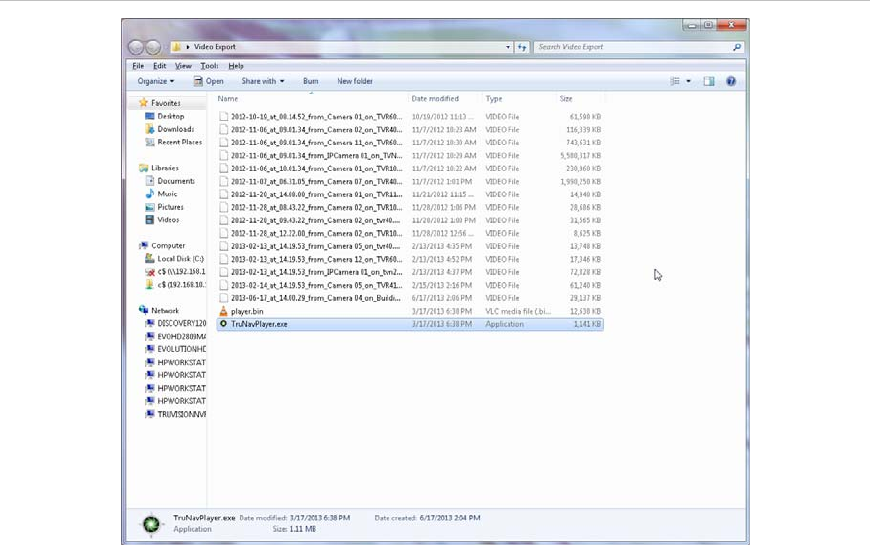
Chapter 3: Operation
52 TruVision Navigator 5.0 Service Pack 3 User Manual
TruVision Navigator Player
The TruVision Navigator Player is a standalone player that can be used to replay any
video clip that has been exported using TruVision Navigator (proprietary file formats
include .wvf, .mpc, .asf, .mp4, and .drv). This player should be copied to media along
with the video clips for authorities. It has a zero footprint – meaning it will launch from
the media itself and does not require installation to a machine.
After exporting video clip(s) from the Collector to the user-defined location, you can
launch the TruVision Navigator player by double-clicking the TruVision Navigator Player
icon in the file folder where the video clips are located. The player.bin file must be in
the same directory as the TruVision Navigator Player.exe or the TruVision
Navigator Player will not work.
Figure 46: Video Export window
Once launched, the TruVision Navigator Player will automatically sweep the directory
and load the associated video clips in the Play List from that directory. By clicking the
checkbox next to the clip in the Play List, the video will load in a tile (9-up maximum).
Highlight the video tile and click the Play button to play the video.

Chapter 3: Operation
TruVision Navigator 5.0 Service Pack 3 User Manual 53
Figure 47: TruVision Navigator Player window
The features of the TruVision Navigator Player are:
• Browse – allows the user to browse for a specific video clip in another directory and
load it into the Play List.
• Snapshot – allows the user to take a snapshot of the highlighted video tile.
• Print - allows the user to print a snapshot of the highlighted video tile.
• Maximize Screen – takes the TruVision Navigator Player full screen and hides the
Play List and Tool Bar at the top of the application.
• Playback Controls – allows for FFWD, RWD, Play, Pause, Frame Reverse, and
Frame Advance.
• Timeline – allows the user to jump ahead or back in time for a single selected video
tile.
• Audio – allows the user to hear audio (if present) for only the selected video tile. If all
video tiles are selected, no audio will play.
• Select All Videos – allows the user to select all video tiles. Once all video tiles are
selected (white outline around the video tiles), the Playback Controls will affect all
video tiles and not just a single one. However, each clip will begin at its own start
time and end at its own end time. This holds true for the snapshot and print capability
as well. The timeline will not appear when multiple video clips are selected.
• Sync Playback Start – allows the user to start all video clips at the same time.

Chapter 3: Operation
54 TruVision Navigator 5.0 Service Pack 3 User Manual
Note: As the video clips are played, there may be time gaps due to the different
video settings on each clip source (i.e. different fps). This function will ensure that
the initiation of the playback for all tiles happen at the same time to keep the time
gaps between the clips at a minimum.
• Time/Date Stamp – on playback, each video will have a time/date stamp on it for
evidentiary purposes.
Double-click on any video tile to go full screen or use the maximize button in the Tool
Bar.
Double-click to go back again to the normal state.
When in Full Screen, right-click to hide/show the Playback Controls to expose only the
video tiles and nothing else.
Views
The TruVision Navigator Viewer panel allows you to manage cameras and camera views
in different ways, as outlined below:
Figure 48: Viewer Panel
Chapter 3: Operation
TruVision Navigator 5.0 Service Pack 3 User Manual 55
Multi-site - The multi-site feature allows you to view video from multiple cameras from
different devices simultaneously in the Viewer. TruVision Navigator can render Wavelet,
Wavejet, MJPEG, MPEG4, and H.264 compression streams simultaneously, which
allows you to mix and match the cameras from your many devices seamlessly.
Standard video tile layouts include 1x1, 2x2, 3x3, 4x4, and 5x5. You can also use the 8-
up custom tile layout that features 1 large video tile surrounded by 7 smaller ones.
When in a multi-up view (i.e. 4x4), you can double-click in a video tile to bring the video
to full screen. Double-click in the video tile again to return to multi-up viewing.
Maximize Viewer - If you would like to close all panels instantly except for the Viewer,
use this option. Click it again to return to the previous layout.
Close All Video - Select this option to close all video.
Instant Replay - Click on the Instant Replay button on the video tile to go from Live to
Playback by a user-defined and pre-configured period of time (i.e. 5 minutes) for quick
viewing of an incident.
Custom View - Custom views allow you to define and save multi-site view templates for
future use. You can create as many custom views as you want. Custom views are
available by selecting the Custom View option in the Viewer header bar dropdown menu.
To define a custom view, do the following:
Load all the cameras you want to include in the custom view in the Viewer.
Organize your cameras by dragging and dropping the video tile’s status bar to other
video tiles.
Click Custom View from the Viewer panel header bar dropdown menu.
Select Save Custom View.
Enter a title in the Title field.
Click OK.
Close all videos.
From the Viewer panel header bar dropdown menu, highlight the Custom View title in
the menu and select.

Chapter 3: Operation
56 TruVision Navigator 5.0 Service Pack 3 User Manual
PTZ control
TruVision Navigator has the ability to control PTZ camera and motorized zoom cameras
with auto focus feature. Supported features include pan, tilt, and zoom moves, as well
as set and go to presets, and record and go to tours. The tours functionality is only
available for certain device types. See the device-specific chapters for the support for
this feature.
First, the camera must be marked as a PTZ camera in its configuration as the camera
does not identify itself as such to the device. To mark a camera as a PTZ, simply right-
click on the camera and select, Configure Camera. From the camera configuration
dialog, check the PTZ Enabled checkbox, select a PTZ protocol, assign an address, and
click Ok. Ensure the camera also has the appropriate address and protocol settings.
Upon completion, you’ll notice that the camera’s icon in the Navigator changes from a
fixed camera icon to a PTZ camera icon.
Once you have marked a camera as PTZ, you can now control it using the PTZ Controls
or with mouse commands in the video tile.
To control a PTZ camera using the PTZ Controls:
Load the PTZ Camera into the Viewer and select it.
Click the PTZ icon on the Controller toolbar and the PTZ dialog will open. Adjust the
dialog to optimize video viewing.
Figure 49: PTZ controls
Use the controls to move the PTZ Cameras as well as zoom, focus, auto focus and iris.
Set the speed to the appropriate level for your network and operations. You can also go

Chapter 3: Operation
TruVision Navigator 5.0 Service Pack 3 User Manual 57
to, name, and set presets and return cameras to tour (on certain devices). See the
device-specific chapters for applicable functionality.
Note: PTZ control responsiveness will vary depending upon the frame rate,
resolution, and quality of the video stream. D1/ 30FPS/Quality 9 will afford you the
most responsive PTZ control over the network. Weigh PTZ control responsiveness
with your storage requirements to find the best fit. You can also balance the PTZ
speed setting with the stream configuration to find the best fit.
To control a PTZ camera using mouse commands within the video tile:
Load the PTZ Camera into the Viewer and select it.
Place your cursor in the center of the Viewing tile.
Left-click and hold the mouse, then drag to the right-left-up-or down. Notice the further
from center the cursor gets, the faster the camera will move.
Right-click and hold the mouse, then drag up or down to zoom in and out with the
camera.
Note: Interlogix cameras with motorized lens can also be controlled as a PTZ
camera via the PTZ palette for iris and focus adjustments.
Users also have the ability to link a PTZ camera’s presets into a sequence based upon a
specific order and dwell time. These sequences can be managed and tested by right-
clicking on the PTZ camera in the Navigator and selecting Preset Sequences, Manage
Sequences.
Figure 50: PTZ preset window
These sequences can be activated by right-clicking on the PTZ camera in the Navigator
and selecting Preset Sequences, and then the name of the sequence that was created.

Chapter 3: Operation
58 TruVision Navigator 5.0 Service Pack 3 User Manual
Digital Zoom
TruVision Navigator allows you to perform digital zoom in/out functions to the live and
recorded view. To zoom in, scroll up with the mouse wheel, and to zoom out scroll down.
When in digital zoom mode, you can click and hold the mouse left button to Navigate in
the zoomed image.
Tampering Monitor
TruVision Navigator is equipped with a tampering monitor that compares the current
image with a reference image taken during the installation. Tampering monitor keeps a
record of each camera by taking a reference snapshot and restoring it in the database.
To open the tampering monitor, right click on a recorder and select Tampering Monitor,
and Tampering Monitor window will display.
Figure 51: Tampering Monitor

Chapter 3: Operation
TruVision Navigator 5.0 Service Pack 3 User Manual 59
On the left hand side, reference images will be listed with the date and time they were
taken. For the first time applications of this feature, the reference images will be empty;
therefore, user should click Update All to save the reference images. By comparing
reference images with live images located on the right hand side, user can easily
measure any tampering activity on each cameras.
Configure a device
TruVision Navigator allows you to configure devices in bulk or one at a time.
To configure a single device, right-click on the device in the Navigator and select
Configure Device. A configuration dialog will open. Navigate through the settings, make
changes as appropriate, and either click Ok or Cancel. Ok will save the settings to the
device and Cancel will abort the configurations you made.
Figure 52: Device Configuration Window
Some devices cannot be configured remotely via TruVision Navigator. See the device-
specific chapters for more detail on this functionality.
Audio can be heard from devices in TruVision Navigator for both Live and Playback
streams assuming several setup steps are completed. At a high-level, the device needs
to be configured for audio and a microphone needs to be added to the device to capture

Chapter 3: Operation
60 TruVision Navigator 5.0 Service Pack 3 User Manual
that audio. At the TruVision Navigator Client PC, speakers need to be attached and the
volume control needs to be turned up. Specific video tiles need to be selected to hear
the audio. If multiple video tiles are selected, no audio will play. See the device-specific
chapters for more detail on this functionality.
Motion detection notifications are available in TruVision Navigator assuming several
setup steps are completed. At a high-level, the device needs to be configured to trigger
notifications on motion and each camera's field of view needs to be configured for the
active zones. TruVision Navigator must also be configured to accept those motion
notifications on a specific port. See the device-specific chapters and Notification Section
for more detail on this functionality.
The bulk device configuration feature offers you an easy way to remotely update and
maintain the configurations of devices in the system. This powerful capability allows you
to push a single configuration parameter across all like-devices or as many configuration
parameters as necessary across all like-devices. As with a single device configuration,
this action can be performed immediately or on a schedule.
To configure like-devices in bulk, right-click on the Devices node in the Navigator and
select Bulk Configuration. The Bulk Configuration dialog will appear.
Figure 53: Bulk Configuration
There are 3 sections in the Bulk Configuration dialog: Source, Settings, and Destination.
Chapter 3: Operation
TruVision Navigator 5.0 Service Pack 3 User Manual 61
• Source - this is where you select the device type of the devices you want to
configure. As you select different device types, the destination list will toggle
in real-time to show the applicable like-devices in the system.
• Settings - initially, a configuration template will appear for that device type
selected in the source. This generic template will show all of the necessary
configurations for that device type but won't have any values populated in the
fields. This allows users to simply pick and choose the exact configuration
fields they want to update and push only those to the destination devices.
To start with a blank configuration template, select a device type from the
dropdown list on the left of the screen.
To use a specific device as a reference configuration, select that device from the
Source tree. You can use the Clear button at any time to remove all
configuration values and go back to a blank configuration template.
• Destination - if there is a source device that mirrors the exact configuration
you want to copy, you can select that device in the source and it will load in
settings. You can push this entire configuration to destination devices or
change some configurations and then push it all to destination devices.
Upon initiation (now or on a schedule), a task will be created in the Tasks panel for each
device that will have configurations made. Monitor progress of the configurations there.
Chapter 3: Operation
62 TruVision Navigator 5.0 Service Pack 3 User Manual
Configure a camera
The steps required to modify a camera’s configuration is similar to that of configuring a
device. To change a specific camera’s configuration do the following:
Right-click on a camera in the Navigator and select Configure Camera. A configuration
dialog will open.
Navigate through the settings, make changes as appropriate, and either click Ok or
Cancel.
Ok will save the settings to the device and Cancel will abort the configurations you
made.
Note: The trusted source for camera titles is the device itself. When adding a device for
the first time, TruVision Navigator will not pull the device’s configuration information at
the time of connection. Therefore, the cameras under the device in the Navigator panel
may display generic camera titles (Camera 1, Camera 2, Camera 3, etc.). Camera titles
are updated in TruVision Navigator after you pull the device configuration for the first
time. Afterwards, any changes to camera titles through TruVision Navigator will update
both the Navigator and the device.
Note: For protocol configuration of analog PTZ cameras attached to an embedded NVR
via an encoder, please use encoder web administration rather than the embedded
recorder configuration menu.

Chapter 3: Operation
TruVision Navigator 5.0 Service Pack 3 User Manual 63
Figure 54: Camera configuration

Chapter 3: Operation
64 TruVision Navigator 5.0 Service Pack 3 User Manual
Device properties
Device properties consist of connection, detail, and capability information. To obtain
device properties, simply right-click on the device and select Properties.
Figure 55: Device Properties Window
The Connection tab shows all of the information previously entered when adding the
device. Make changes as appropriate and click OK to save changes.
The Details tab provides an area for you to enter any data you would like around a
device to help facilitate management of the system. If the device was imported and data
existed in the original WaveReader or SymNav address book, this data will appear in
these fields. If the device was added manually, the fields will remain blank until you add
data and click OK.
The Capabilities tab shows you exactly what features the device supports.

Chapter 3: Operation
TruVision Navigator 5.0 Service Pack 3 User Manual 65
Device disk analysis
TruVision Navigator features the ability to run a disk analysis on a device in order to get
a broader sense of the different types of video data recorded to disk. This video data can
include alarms, events, video loss, motion, and more.
To run a disk analysis for a device, right-click on the device in the Navigator and select
Run Disk Analysis. The disk analysis dialog will appear.
Figure 56: Disk Analysis dialog
From this dialog, you can zoom in and out on the timeline to view different levels of time
granularity for the video. The legend outlines the types of video by color (i.e. alarm is
red).
For periods marked as “Unknown”, the device may/may not have recorded video
available. It was just not tagged with a specific type per its device configuration
parameters.
Double-click on colored areas in disk analysis, and the video will begin to play in the
Viewer. By multi-selecting the checkboxes to the left of each camera name, you can
achieve synchronous playback across those selected cameras.
Once video is playing in the Viewer, you can manage and export it as normal. See the
device-specific chapters for more detail on what types of video tagging is available per
device.
Chapter 3: Operation
66 TruVision Navigator 5.0 Service Pack 3 User Manual
Firmware upload
TruVision Navigator offers the ability to upload firmware to devices remotely. You can
do this per device or in bulk-fashion across many like-devices.
To upload firmware to device(s), either right-click on the device in the Navigator and
select Upload Firmware or right-click on the Devices node in the Navigator and select
Bulk Firmware Upload. The Firmware Upload dialog will appear.
Select your source device type, browse for the applicable firmware, and select the
destination device(s) for the firmware upload.
Remember, TruVision Navigator does not do a file format check on the firmware file, so
ensure it is the proper file for that device type. In addition, the firmware file must reside
on the local machine. It cannot be accessed across network paths.
Click on the Upload Now button or schedule the firmware upload for a future date/time
via the Schedule button.
Upon initiation of the upload, a task will be created for each individual device firmware
upload in the Tasks panel. The status on each of those uploads can be tracked from
there. The Status column will include values of Pending, In Progress, and Success or
Failed. Place your mouse pointer over the status of each task to obtain more detailed
information about progress. You can also watch the status of the firmware upgrade via
the device’s On-Screen-Display. Firmware uploads may take several minutes to
complete.
For any scheduled task that will take place in the future, you must ensure that the
machine where the task was created is powered up and the Local Scheduling Service is
running on that machine. The TruVision Navigator application itself can be closed but the
machine and Local Scheduling Service must be running for the task to be initiated and
completed.
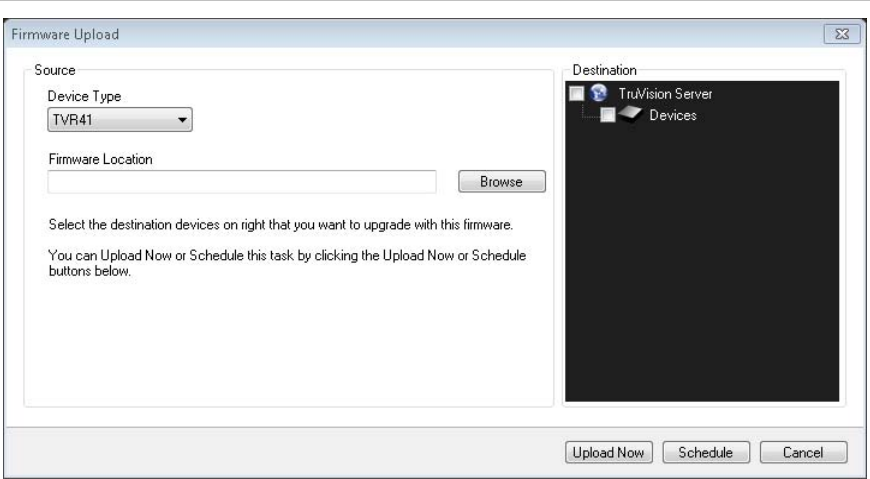
Chapter 3: Operation
TruVision Navigator 5.0 Service Pack 3 User Manual 67
Figure 57: Firmware Upload Window
Camera search
TruVision Navigator allows you to search cameras for alarms, alarms plus events,
motion, and point-of-sale text-related video.
For those searches, the device must first be configured to tag the camera’s video based
upon those parameters (which must be available in the device). For instance, to be able
to search a camera for motion in TruVision Navigator, the motion grid must be setup for
that camera in the device and tagged for motion. This device setup can be done
remotely via the configuration capability within TruVision Navigator or from the device
itself.
To search for video tagged with text, enter the text string you want to search for and click
Search. Toggle the Overlay Text on Video checkbox to overlay the text on the video or
place it beside the video. This checkbox is dynamic so if you toggle it during playback,
the text will switch from overlay to side-by-side and vice-versa (it will take a few seconds
to switch).
Remember that for text searches, the device must be working in conjunction with a
ProBridge. The ProBridge acts as a bridge between the recording device and the Point-
of-Sale (POS) device (i.e. a cash register or ATM). It essentially feeds the POS text
data into the recording device where it is tagged to the applicable video.
Different devices support varying levels of camera search. See the device-specific
chapters for more detail on what types of video data is available per device.
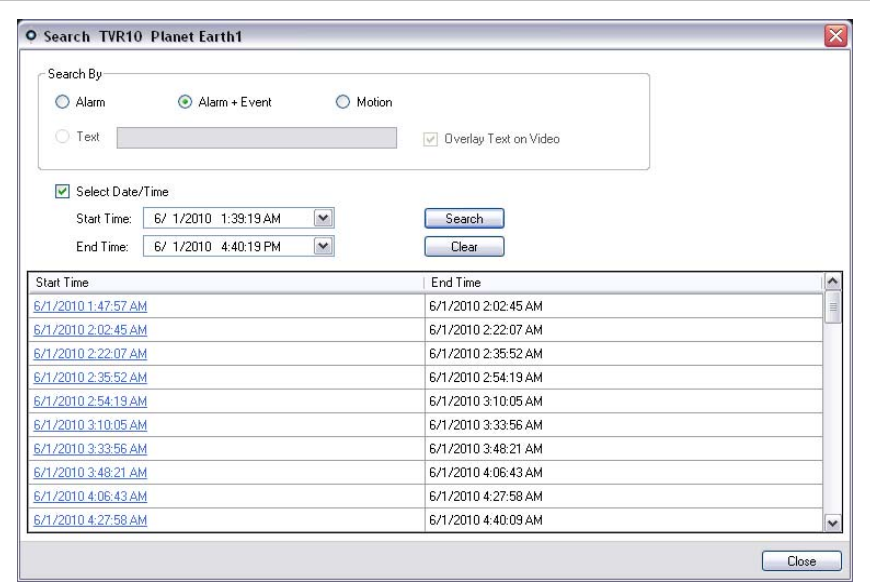
Chapter 3: Operation
68 TruVision Navigator 5.0 Service Pack 3 User Manual
To perform a camera search, right-click on the camera in the Navigator and select
Search. The search dialog will appear. From the search dialog, you can specify the
video type and time/date range, and upon clicking Search, the results will appear in the
table. Click the hyperlinked start times to review the video in the Viewer.
Figure 58: Search dialog
TruVision Navigator 5.0 Service Pack 3 User Manual 69
Chapter 4
TruVision Navigator
Settings
For both the standalone and multi-client installation models, you have the ability to
configure the TruVision Navigator Client and Server for specific features. To configure
the TruVision Navigator Client and Server, right-click on TruVision Navigator Server in
the Navigator and select Settings. The Settings dialog will appear.

Chapter 4: TruVision Navigator Settings
70 TruVision Navigator 5.0 Service Pack 3 User Manual
Figure 59: Settings Window
Client Settings
Client tab of Settings Window provides following client settings:
Preserve Video Aspect Ratio: Helps keeping the video aspect ratio if selected.
Use of Video Card Hardware Acceleration: Enables use of hardware video
acceleration if the system is equipped with such an hardware.
Enable Audio From Devices: Enables the use of audio from remote devices.
Show Me if My Navigator Needs To Be Synced: Notifies user to sync the
Navigator Client if there are changes applied to the server.
Auto Switch to Alternate Stream: Helps reducing the CPU and network usage
when user is in a specific layout mode. When the tile is maximized for full screen
view, it will show primary stream and will convert back to alternate stream when the
view is converted back to the selected layout. The selected number of tiles and
above will use alternate stream automatically.
Chapter 4: TruVision Navigator Settings
TruVision Navigator 5.0 Service Pack 3 User Manual 71
Server Settings
Server tab of Settings Window provides following server settings:
• SMTP Setup
• Permissions Model
• Authentication Complexity
• Instant Replay
• Custom Help Link
• Server URL
• Client Download URL
SMTP Setup
Simple Mail Transfer Protocol (SMTP) is a de facto standard for email transmissions
across the Internet. TruVision Navigator Server can be configured to use an SMTP
server to send automated email messages (with Client Download URL, Username,
Password) to users when they are created in TruVision Navigator and when their login
credentials (Username, Password) need to be reset in the system by an Administrator. If
SMTP is not setup, this information will need to be delivered via an alternative method
(i.e. phone or personal email).
Enter the SMTP Server IP Address, the port, any username/password credentials that
may be mandated by the SMTP server you are using, and SSL, if necessary. Test this
setup by clicking Test and entering the email address of where you want the test
message sent. Check the application status bar for feedback on the test. As well, check
your email to ensure there is a test message from the TruVision Navigator Server
confirming proper setup of the SMTP server.
You should see an email like the one below. After several minutes, if you still have not
received the message, check your Junk Mail folder to see if the email was classified and
stored there.

Chapter 4: TruVision Navigator Settings
72 TruVision Navigator 5.0 Service Pack 3 User Manual
Figure 60: Test Email Window
Permission Model
TruVision Navigator has two permission models – Simple or Advanced. The default for a
new installation is the Simple model.
Simple model - Administrators only have the ability to create, edit, and delete users and
their corresponding permissions.
Advanced model - Administrators have the ability to create, edit, and delete both users
AND groups. Groups allow you to scale user permissions in your system across many
users. For instance, many users can be placed into a single group, and that single group
can be assigned permissions against the folders/ devices in the system. Without groups,
the Administrator would have to permission each user against those same devices.
To change your permission model from Simple to Advanced, select it from the
Permission Model drop-down and click OK. Groups should now appear as a node in the
Navigator panel. The table below outlines the actual permissions that can be granted to

Chapter 4: TruVision Navigator Settings
TruVision Navigator 5.0 Service Pack 3 User Manual 73
users or groups within TruVision Navigator, the user interface impact of that permission,
and the dependencies of specific permissions.
Table 6: Permission Matrix
Permission User Interface Impact Dependent Permissions
Configure Server Enable/disable right-click options on
TruVision Navigator Server node (i.e.
Properties and Database Backup and
Restore)
Manage User
Permissions Show/Hide Users and/or Groups nodes in
Navigator
Manage Device Folders Show/Hide Add Folder button and context
menus in Navigator
Show/Hide Folder (folder may also be
visible due to other permissions or
parent/child permissions)
Show/Hide Address Book Import context
menu for Devices node.
Manage Devices Show/Hide Add Device button and context
menus (rename and delete) in Navigator
Show/Hide Folder (folder may also be
visible due to other permissions or
parent/child permissions)
Show/Hide Device (device may also be
visible due to other permissions or
parent/child permissions)
Show/Hide Camera (camera may also be
visible due to other permissions)
Show/Hide Bulk Tasks (Firmware Upload
and Configuration) context menus for
Devices node.
Enable/Disable Device Properties
(Connection, Details, Capabilities) dialog
on device
Show/Hide Camera Search and
Configuration context menus
Show/Hide Firmware Upload context menu
for device
Show/Hide Tasks Panel (panel may also
be visible due to other permissions)
View Device Diagnostics Show/Hide Run Health Diagnostics in
Device node and specific device context
menus in Navigator.

Chapter 4: TruVision Navigator Settings
74 TruVision Navigator 5.0 Service Pack 3 User Manual
Show/Hide Folder (folder may also be
visible due to other permissions or child
permissions)
Show/Hide Device (device may also be
visible due to other permissions or child
permissions)
View Notifications Show/Hide Folder (folder may also be
visible due to other permissions or child
permissions)
Show/Hide Device (device may also be
visible due to other permissions or child
permissions)
Enable/Disable Notifier icon in application
status bar.
Show/Hide Device Notification in Notifier
dialog
Show/Hide Camera Notification in Notifier
dialog for permissioned device
Acknowledge
Notifications Show/Hide Acknowledge All button in
Notifier dialog
Watch Live Video Show/Hide Folder (folder may also be
visible due to other permissions or child
permissions).
Show/Hide Device (device may also be
visible due to other permissions or child
permissions).
Show/Hide Camera (camera may also be
visible due to other permissions).
Allow/Disallow Open Video from Camera
(all methods: double-click and drag-n-drop
in Navigator).
Show/Hide PTZ and in-tile mouse controls.
Watch Playback Video Show/Hide Folder (folder may also be
visible due to other permissions or child
permissions).
If you have Watch Playback
Video, you will automatically
receive Watch Live Video.
Show/Hide Device (device may also be
visible due to other permissions or child
permissions).
Show/Hide Camera (camera may also be
visible due to other permissions).

Chapter 4: TruVision Navigator Settings
TruVision Navigator 5.0 Service Pack 3 User Manual 75
Enable/Disable Controller Playback
controls including Go To, Playback, Live,
double-click on timeline)
Enable/Disable notifications in Notifier
dialog.
Watch Video HBW Enable/Disable Stream and Bandwidth
menus in the Controller. Requires at least one of the
Watch Video permissions
(Live or Playback).
Export Video Enable/Disable Local record button in
Controller. Requires both of the Watch
Video permissions (Live and
Playback).
Enable/Disable Snapshot and Video
buttons in the Controller.
Show/Hide Collector Panel.
Show/Hide Tasks Panel (panel may also
be visible due to other permissions).
View Disk Analysis Show/Hide Disk Analysis context menu for
device.
Show/Hide camera row in Disk Analysis
dialog. Requires both of the Watch
Video permissions (Live and
Playback).
Authentication Complexity
TruVision Navigator has three Authentication Complexity standards - Low, Medium, and
High. The default for a new installation is Low. To change the Authentication
Complexity, select a choice from the drop-down and click OK.
All new users to the application will be required to meet the new Authentication
Complexity standard. However, existing users of the application will not be prompted to
change their credentials to meet the new standard once it is changed. Therefore, the
Administrator must reset each of the existing user accounts for the standard to take
effect. This reset will only affect the password for that user – not the username. It is
recommended to set the Authentication Complexity early before any users are created in
the system to avoid having to do resets.
The table below outlines the components of each of these standards.

Chapter 4: TruVision Navigator Settings
76 TruVision Navigator 5.0 Service Pack 3 User Manual
Table 7: Authentication complexity
Authentication
complexity Maximum
login failure
attempts
Username
complexity Password
complexity Password
reuse Password
expiration
Low n/a At least 6
characters At least 6
characters n/a n/a
Medium 3 At least 6
characters At least 8
alphanumeric
characters
n/a n/a
High 3 At least 12
characters At least 8
characters with
at least:
1 Upper- case
letter
1 lower-case
letter
1 numeric
1 special
character (~, !,
@, #, $, %, ^,
&, +, =)
Cannot use the
last password User must
change
password every
60 days
Instant Replay
TruVision Navigator supports Instant Replay from the video tile itself via the Instant
Replay icon. This affords an operator the ability, with one mouse click, to rewind
selected video by a user-defined, pre-configured amount of time (99 minutes and 59
seconds maximum).To set your Instant Replay time, enter the minutes and seconds and
click OK. This setting can be found at the Server Settings screen in the Settings menu
located in the bottom toolbar
Load video into the Viewer and mouse over the Instant Replay icon (white back-arrow to
the left of the close video icon) on the far right of the video tile status bar. Notice your
pre-configured amount of time in the Tool Tip. Click on the icon to go back that amount
of time with the selected video. See the specific device chapters for limitations on
instant replay per device.
Custom Help
TruVision Navigator has Custom Help access that allows individual organizations to
provide their own additional content to facilitate adoption of the software. This content is
Chapter 4: TruVision Navigator Settings
TruVision Navigator 5.0 Service Pack 3 User Manual 77
completely user-defined. TruVision Navigator simply provides a pathway for users to
access it.
To add a Custom Help link, enter the Custom Help title of the content that you want to
expose to users. Next, enter the Custom Help link, which is the actual path to the
content (users will not see what you enter in this field). Click OK.
Open the Help dialog (Question Mark icon) from the application status bar and notice the
Custom Help title there. Click on the link to access the content.
Server URL
For Multi-client installations (client/server), the Server URL is the network location of the
TruVision Navigator Server. This is the URL that TruVision Navigator Clients use to
communicate with the TruVision Navigator Server.
For Standalone installations (Direct Database Connection), this field will be disabled, as
no other networked TruVision Navigator clients can connect to this instance of the
TruVision Navigator Server.
Client Download URL
For Multi-client installations (client/server), the Client Download URL is the network
location of the TruVision Navigator Client software package. Administrators can deliver
this URL to new users in order to download the Client software remotely from the
TruVision Navigator Server. If SMTP (see below) is in use, this is done automatically for
the Administrator during user setup.
For Standalone installations (Direct Database Connection), this field will be disabled, as
no other networked TruVision Navigator clients can connect to this instance of the
TruVision Navigator Server.
Default Language
TruVision Navigator will automatically read your PC's language setting and display that
language in the application if it is supported. If the language is not supported, TruVision
Navigator will default to English. Changing the language setting on your PC will take
effect the next time you log into TruVision Navigator.
After changing the default language, the device names and folders will remain in the
language that they were first named. They are not translated dynamically. You can
rename the devices and folders after the default language change has taken place.
Due to the different lengths of words in different languages, the buttons in the application
may show abbreviations for a word. Simply position the mouse over the abbreviation on
the button to see the full translation of the word.
Chapter 4: TruVision Navigator Settings
78 TruVision Navigator 5.0 Service Pack 3 User Manual
User Management & Client Software Delivery
Overview
With Multi-client (client/server) installations of TruVision Navigator, PCs on the same
network with the TruVision Navigator Server have the ability to download the TruVision
Navigator Client. This alleviates the need for an Administrator to physically ship media or
visit the PC’s site to install the client software.
Remember:
Remote distribution of client software is NOT available for the Standalone (Direct
Database Connection) installation option.
The person installing the client software must have administrative rights on the machine
to perform the client installation.
The mechanism for delivering the client software is slightly different if you use the SMTP
capability within TruVision Navigator . If you use the SMTP capability, the entire process
of adding a user and distributing the client software is automated. If you do not use the
SMTP capability, there are several manual steps required to deliver the client software
as described below.
Chapter 4: TruVision Navigator Settings
TruVision Navigator 5.0 Service Pack 3 User Manual 79
Fully Automated Client Software Delivery
TruVision Navigator can be configured to use an SMTP server to send automated email
messages (with Client Download URL, username, and password) to new users or when
an existing user’s login credentials (username and password) need to be reset in the
system by an Administrator.
To distribute the client software remotely to a new user, you must first configure
TruVision Navigator with an SMTP Server, add the new user, and permission the new
user.
To add a user, right-click on the Users node in the Navigator and select Add User. The
Add User dialog will appear. Enter the user’s First Name, Last Name, and Email
Address (these fields are required while the Username, Password, and Confirm
Password fields are disabled due to SMTP configuration) and click OK. The new user
will be added under the Users node in the Navigator.
Add User
At this time, TruVision Navigator generates the new user with a temporary username
and password in the system and delivers an automated email to the SMTP server for the
user, as shown below.
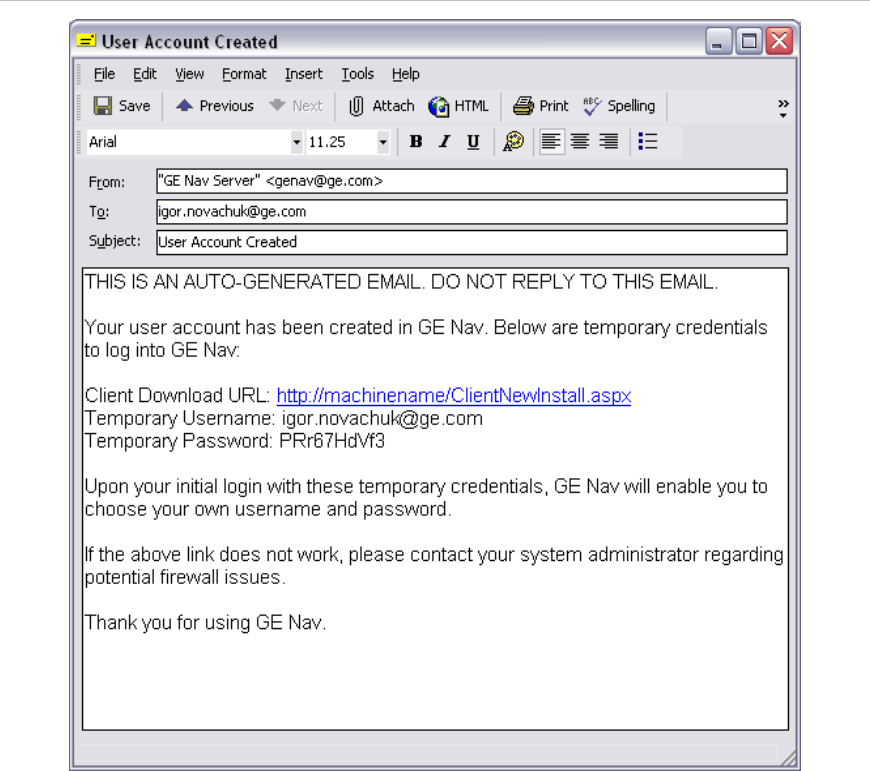
Chapter 4: TruVision Navigator Settings
80 TruVision Navigator 5.0 Service Pack 3 User Manual
Figure 61: User Account Created Email
The user can now click the download URL or cut/paste the string into a web browser.
From the Client Installation page, follow the instructions to install the client software.
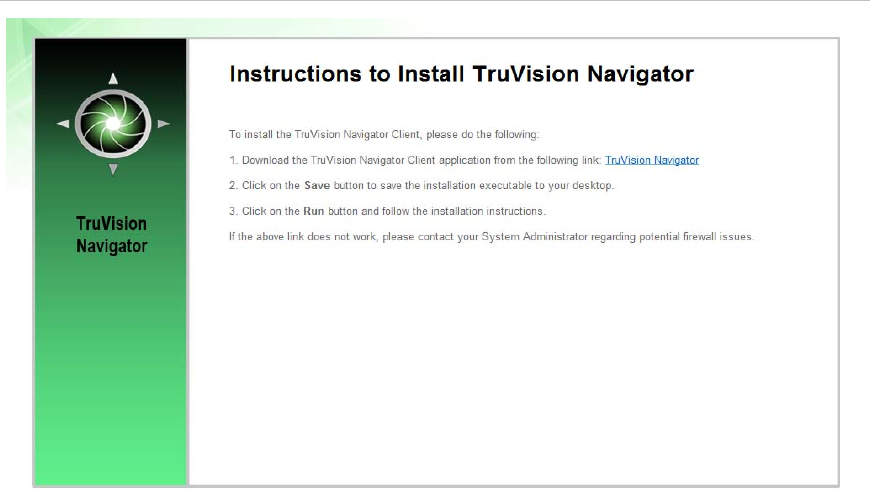
Chapter 4: TruVision Navigator Settings
TruVision Navigator 5.0 Service Pack 3 User Manual 81
Client Installation
Figure 62: Client Installation Window
When installation is complete and you have rebooted your machine, click on the
TruVision Navigator icon on your desktop.
Login to the application using the credentials from the email. You will be prompted to
change those credentials upon initial successful login. You will also be prompted to
provide a challenge question and response that, in the future, will allow you to reset your
own password without Administrator assistance.
Once inside the application, you should see all of the devices in the Navigator – per the
permissions granted by the Administrator.
Remember, when a new user is added to the system, that user does not have any
permissions assigned, and therefore, will not be able to login to the application. You
must assign user permissions before the user can login.
To assign permissions to a user, right-click on the user in the Navigator and select
Properties. The User Properties dialog will appear. Click on the Permissions Tab.
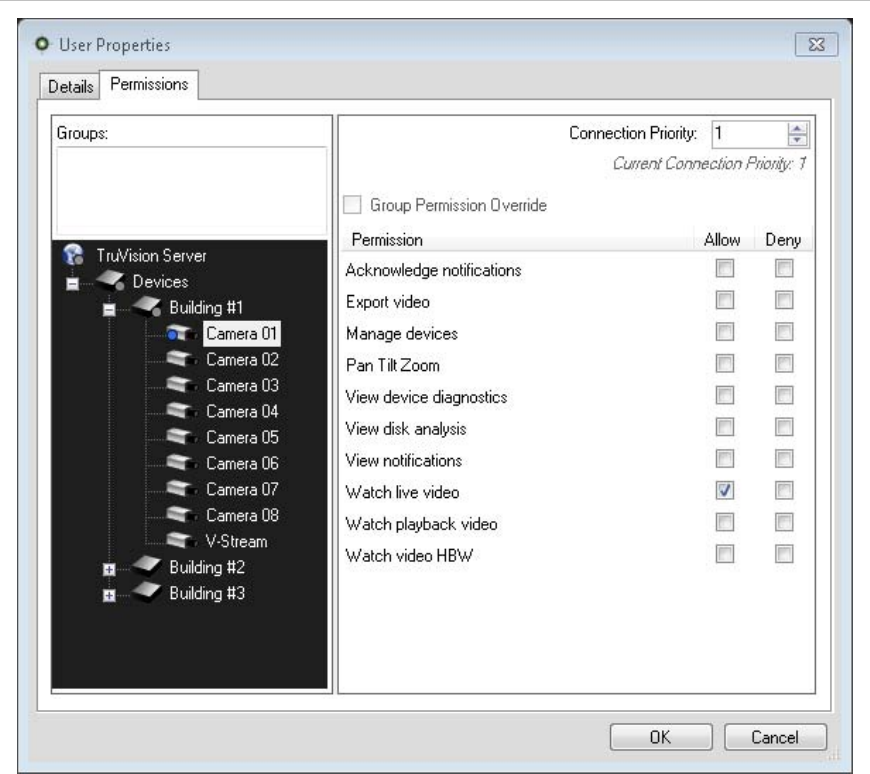
Chapter 4: TruVision Navigator Settings
82 TruVision Navigator 5.0 Service Pack 3 User Manual
Figure 63: User Properties Window
Highlight the TruVision Navigator Server node in the device tree and allow/deny the
permissions for this user in the Permission section. If your Permission Model is set to
Simple (only users), you will only see the Allow column. If your Permission Model is set
to Advanced (both users and groups), you will see both the Allow and Deny columns.
As you do this, the permissions you are granting will cascade down to all of the devices
that you have listed under the TruVision Navigator Server. A blue breadcrumb will
appear on all of the folders, devices, and cameras that the user has permissions.
When assigning permissions, you have the ability to specify whether the permission is
applied at the parent or child node. Granting permissions at a parent node will cascade
those permissions down to the child nodes. For example, granting permissions at the
TruVision Navigator Server level will cascade down over all folders, devices, and
cameras beneath it. These are indicated with a blue breadcrumb. Conversely, granting
permissions at the child node will not change permissions up at the parent node. In this

Chapter 4: TruVision Navigator Settings
TruVision Navigator 5.0 Service Pack 3 User Manual 83
case, the child node will show a blue breadcrumb and the parent will show a grey
breadcrumb. The table below describes this feature in detail.
Table 8: Permission breadcrumbs
Permission
Breadcrumb Description
Blue A blue breadcrumb indicates that there are express permissions granted
on that node. These permissions are inherited by the children nodes
underneath the parent node.
Grey
A
grey breadcrumb indicates that there are express permissions assigned
to a child of the parent node, but not at the parent node itself.
This serves as a quick visual cue for the Administrator to find express
permissions granted to a user on devices buried in the Permission Tree.
If you continue to expand all of the grey breadcrumb nodes, you will
eventually arrive at the camera or device with one or more express
permissions, denoted by the blue breadcrumb.
Remember, permissions within TruVision Navigator can be as simple or as complex as
you like. Very simply, an Administrator can grant permission to users across all devices
in the system by applying those permissions at the TruVision Navigator Server node
(parent) and let them cascade across all child nodes in the system.
On the other hand, an Administrator can grant permission from the child nodes up for
granularity and control within the system. Groups will also come into play to ease the
task of permissions in the system.
Partially Automated Client Software Delivery
Remember that the process for delivering the client software is slightly different whether
you choose to use SMTP or not. If you do NOT have access to SMTP, you can still
deliver the client software remotely. However, there are a few additional steps you must
engage in around delivering the Client Download URL and login credentials to the user.
First, validate that there is no SMTP configuration in TruVision Navigator by right-clicking
on the TruVision Navigator Server node and select Properties. Ensure that the SMTP
Server IP Address is empty.
Second, when adding a user, the Administrator will have to generate a username and
password for the user, himself.

Chapter 4: TruVision Navigator Settings
84 TruVision Navigator 5.0 Service Pack 3 User Manual
Figure 64: Add User Window
Third, the Administrator has to deliver the user’s login credentials and Client Download
URL to the user via phone or through private email. An example of this information is
listed below. You can cut and paste the Client Download URL from the TruVision
Navigator Server Properties dialog - general Tab. Remember to assign the user’s
permissions or he/she will not be able to login.
Finally, if you do not want to use the remote software distribution feature, you can
physically load the client software on PCs by doing the following:
Download the ClientInstall.exe from the Client Installation web page and place it on a
thumb drive or other media.
Physically deliver the .exe file to the specific PC.
Run the ClientInstall.exe and follow the installation prompts (the ClientInstall.exe file is
preconfigured to point to the server that it was obtained from).
Login with the credentials for that user.
Inactivate a user
For whatever reason, an Administrator may want to inactivate a user from the system.
TruVision Navigator does not delete users from the database. The user is simply placed
in an Inactive status and all rights to the system are revoked.
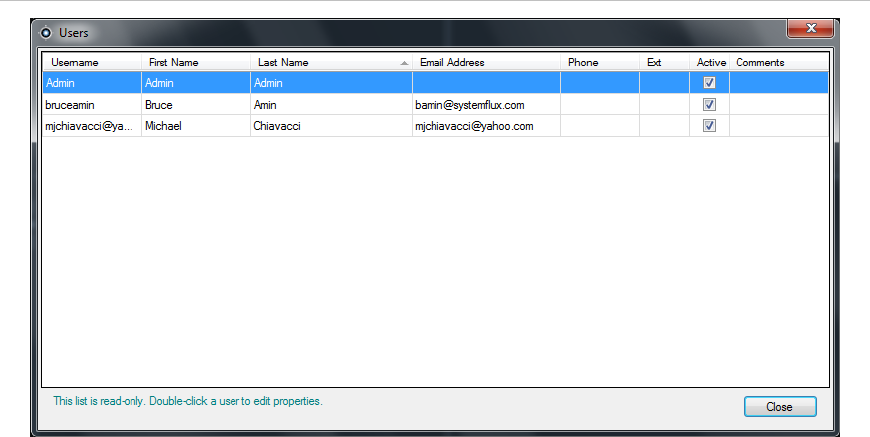
Chapter 4: TruVision Navigator Settings
TruVision Navigator 5.0 Service Pack 3 User Manual 85
To make a user inactive, right-click on the user under the Users node in the Navigator
and select Inactivate User. Click Yes when prompted with “Are you sure you want to
inactivate this user?”
Inactive users will be removed from the Users node in the Navigator unless you right-
click on the Users node and select Include Inactive Users. The Inactive User icon is
shaded grey while the Active User icon is shaded blue.
To view all users in the database (active or inactive) in a list, right-click on the Users
node and select Show User List. The Users dialog will appear. All of the columns in this
dialog are sortable so you can find users quickly. Double-click on any user row to view
that user’s properties dialog.
Figure 65: Users Window
Restore an inactive user
When an Administrator needs to restore an inactive user in the system, right-click on the
inactive user under the Users node in the Navigator and select Activate User. You can
also right-click on the inactive user under the Users node in the Navigator and select
Properties and use the Reset Account button on the Details Tab. Finally, you can
launch the user list and double-click on the user for the Properties dialog to appear, and
again use the Reset Account button.
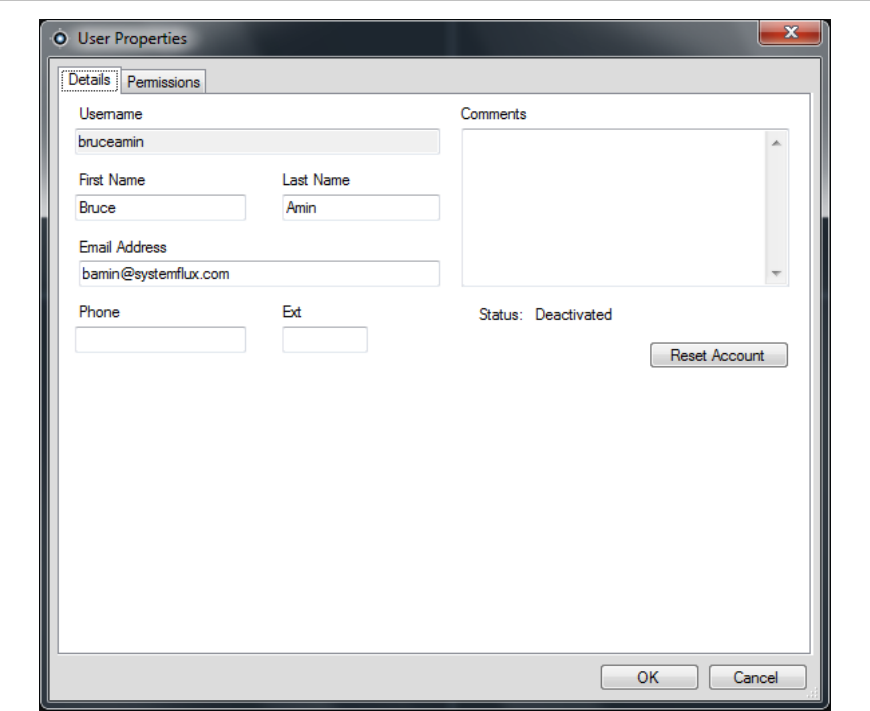
Chapter 4: TruVision Navigator Settings
86 TruVision Navigator 5.0 Service Pack 3 User Manual
Figure 66: User Properties Window
If SMTP is in use, the user will get an email automatically sent to him with his temporary
password for login. The user will be prompted to change this password upon initial login.
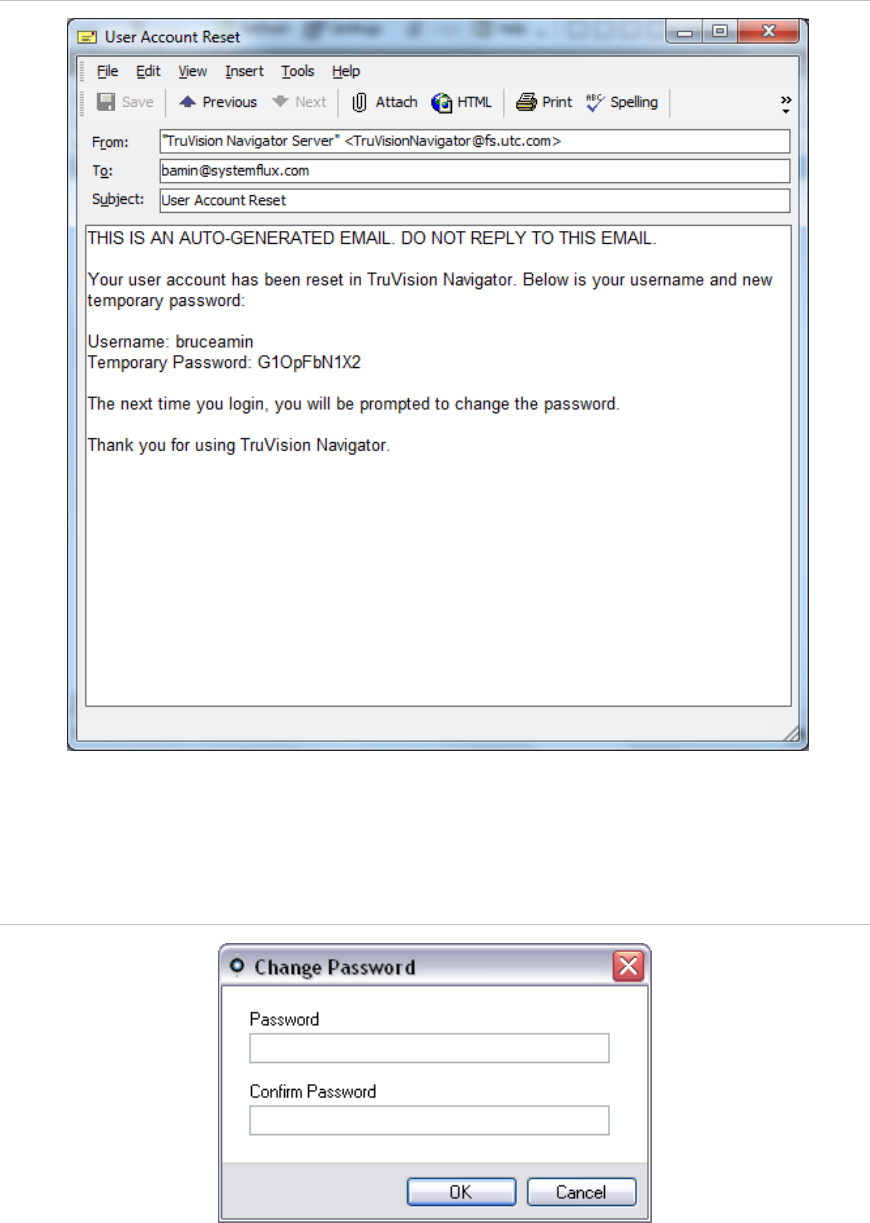
Chapter 4: TruVision Navigator Settings
TruVision Navigator 5.0 Service Pack 3 User Manual 87
Figure 67: User Account Reset Window
If SMTP is not in use, the Administrator will have to provide the user a new temporary
password at the Change Password dialog. These temporary credentials will need to be
delivered to the user via phone or the Administrator’s personally generated email.
Figure 68: Change Password Window
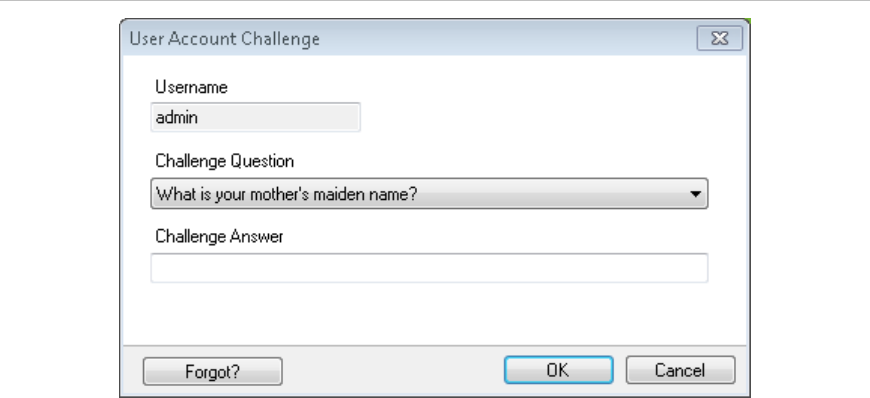
Chapter 4: TruVision Navigator Settings
88 TruVision Navigator 5.0 Service Pack 3 User Manual
Reset a user after lockout
If a user forgets his or her username or password and challenge question, that user can
be locked out of the system. If a user has been locked out for login failures, they can
unlock themselves by answering their challenge question via the Login form’s Challenge
Dialog window
Figure 69: User Account Challenge Dialog Window
If a user cannot remember his/her challenge question, a call to the Administrator is
necessary to reset the account. Follow the instructions in Initial Login section.
Group management
The Advanced Permission Model (on the TruVision Navigator Server Properties dialog)
allows you to utilize groups within TruVision Navigator. Groups allow you to scale user
permissions in your system across many users. For instance, many users can be placed
into a single group, and that single group can be assigned permissions against the
folders/ devices in the system. Without groups, the Administrator would have to
permission each user against those same devices.
Before you create a group, right-click on the TruVision Navigator Server node in the
Navigator and select Properties. The Properties dialog will appear. Ensure the
Permission Model is set to Advanced.
Now, right-click on the Groups node in the Navigator and select Add Group. Provide a
name for the group on the Add Group dialog and click OK.

Chapter 4: TruVision Navigator Settings
TruVision Navigator 5.0 Service Pack 3 User Manual 89
Right-click on the name of the group under the Groups node in the Navigator and select
Properties. The Group Properties dialog will appear.
Figure 70: Group Properties Window
On the Details Tab, you can change the group name, add users to the group, and set
the group’s Connection Priority. On the Permission Tab, you can permission the group
as appropriate.
Connection priority
When it comes to connection levels, there are only a limited number of Live and
Playback connections available depending on the device. TruVision Navigator
automatically connects and disconnects to devices and manages those connection
levels for you depending on the tasks that you wish to accomplish.
To do this, TruVision Navigator has a Connection Manager that manages connection
levels to devices as well as the Connection Priority of the user requesting such
connections. The Connection Priority range that you can set is from 1 to 1,000, with 1
being the top priority and 1,000 being the lowest priority.
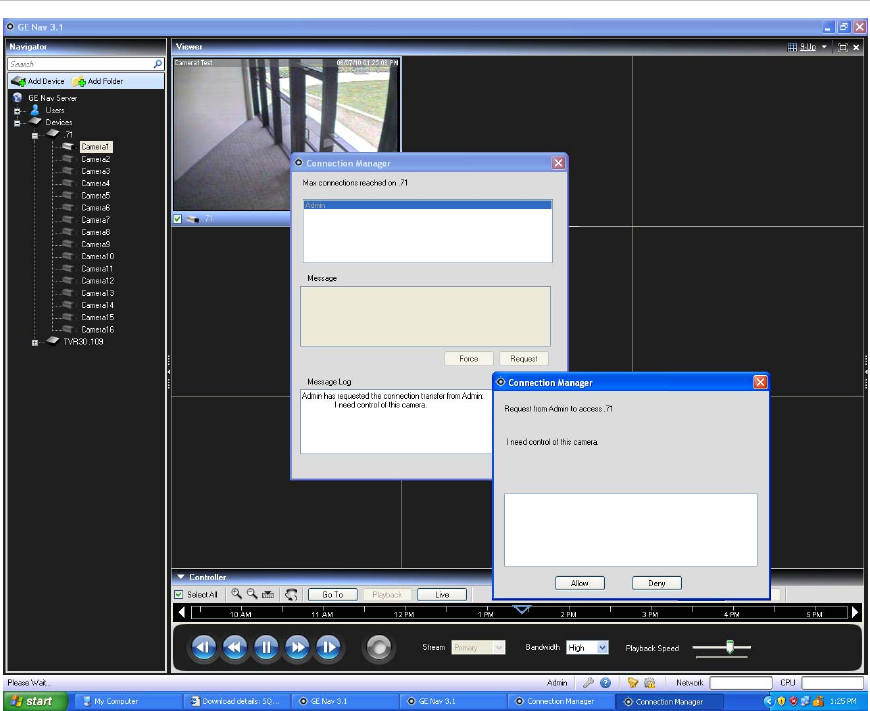
Chapter 4: TruVision Navigator Settings
90 TruVision Navigator 5.0 Service Pack 3 User Manual
When two users are in conflict for the same connection to the device, the user who
requests it first will get that connection. Once the device has reached its connection
limits, the Connection Manager will begin to broker the connection pool based upon the
Connection Priority. Now when the next user requests a connection from the device, the
Connection Manager will allow the higher priority user the chance to either request or
force the lower priority user off of the connection. This is done via the Connection
Manager window which automatically displays when conflicts occur.
Figure 71: Connection Manager Window
On the Permissions Tab, you can assign permissions to the group across the devices in
your system. Remember, these group permissions will affect all of the specific users
that are members of the group.

Chapter 4: TruVision Navigator Settings
TruVision Navigator 5.0 Service Pack 3 User Manual 91
Services
Figure 72: Service Status Window
There are 3 TruVision Navigator services that can be enabled to perform tasks for users.
Standalone installations will only show the Network Time Protocol service in this dialog
since the other services are embedded in Server Settings menu. After services are
configured, they allow activities to take place without the user being present. As long as
the service is running on the machine, the tasks will be executed. TruVision Navigator
does not need to be open.
Users can manage their services from this dialog which is launched from the gear icon in
the application status bar. If an exclamation point appears over this icon, it means that
at least one of the services is not running.
Network Time Protocol – this server-side service can be used to distribute time to
devices on the network. You must configure the device’s NTP to point to the IP Address
of where this NTP service is running (i.e. its location).
Diagnostic Polling - this server-side service can be used to periodically pull health
diagnostics from devices in the system for reporting / issue resolution. The polling
frequency (i.e. nightly at 3am) can be configured from the Health Diagnostics Tab on the
TruVision Navigator Server Properties dialog.
Notification Service - this server-side services can be used to capture notifications that
are pushed from devices. Pushed notifications (via TCP or SMTP) typically include
alarm, video loss, motion, etc... Devices need to be configured to push the notifications
to the location (IP Address and Port) of these 2 services. The matching notification ports
must be configured in TruVision Navigator from the Notifications Tab on the TruVision
Navigator Server Properties dialog.
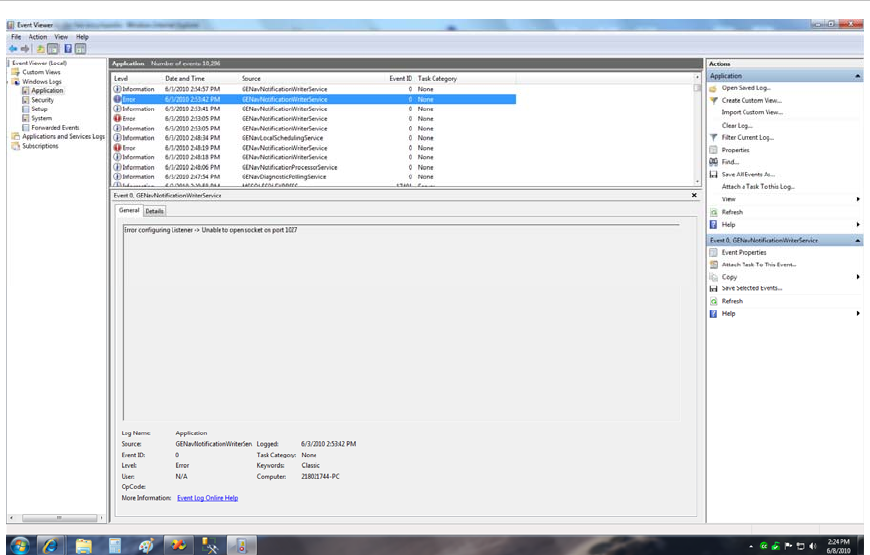
Chapter 4: TruVision Navigator Settings
92 TruVision Navigator 5.0 Service Pack 3 User Manual
Figure 73: Event Viewer Window
Should there be problems with services starting, stopping, or port conflicts, please check
the Windows Event Viewer (right-click on My Computer and select Manage). TruVision
Navigator will log informational and error reports there with respect to issues with the
services. View the reason codes by clicking on the reports.
Chapter 4: TruVision Navigator Settings
TruVision Navigator 5.0 Service Pack 3 User Manual 93
Notifications and Notifier
Devices have the ability to push notifications out to an IP Address and port for proactive
issue resolution. These notifications typically include alarm, video loss, motion, etc...
See the device-specific chapters for what notifications are supported per device.
In order to receive notifications from devices in TruVision Navigator, there are
configurations that need to be made at both the device and TruVision Navigator service-
level.
Device configuration - each device must be set up to push its available notifications to
the IP Address and port of where the Notification Services are located. See the device-
specific chapters for detailed instructions per device.
TruVision Navigator Service configuration - the Notification Service settings must be
configured to listen on that same port for those notifications.
Note: Routers and firewalls may have to be configured accordingly to allow for this
traffic. Ensure that either the TCP Listener Port or the Email Listener Port (SMTP) on
the Notifications Tab of the TruVision Navigator Server Properties dialog matches
the port setup on the device itself.

Chapter 4: TruVision Navigator Settings
94 TruVision Navigator 5.0 Service Pack 3 User Manual
Figure 74: Server Properties Window
TruVision Navigator offers you the ability to prune the notification data out of your
database to keep the size down. Set the retention period for this data as such.
If any of these values are changed, please restart the Notification Writer and Notification
Processor services via the Services dialog for the changes to take affect.
The central repository for notifications is the Notifier dialog. You can launch this dialog
from the notification icon in the application status bar.
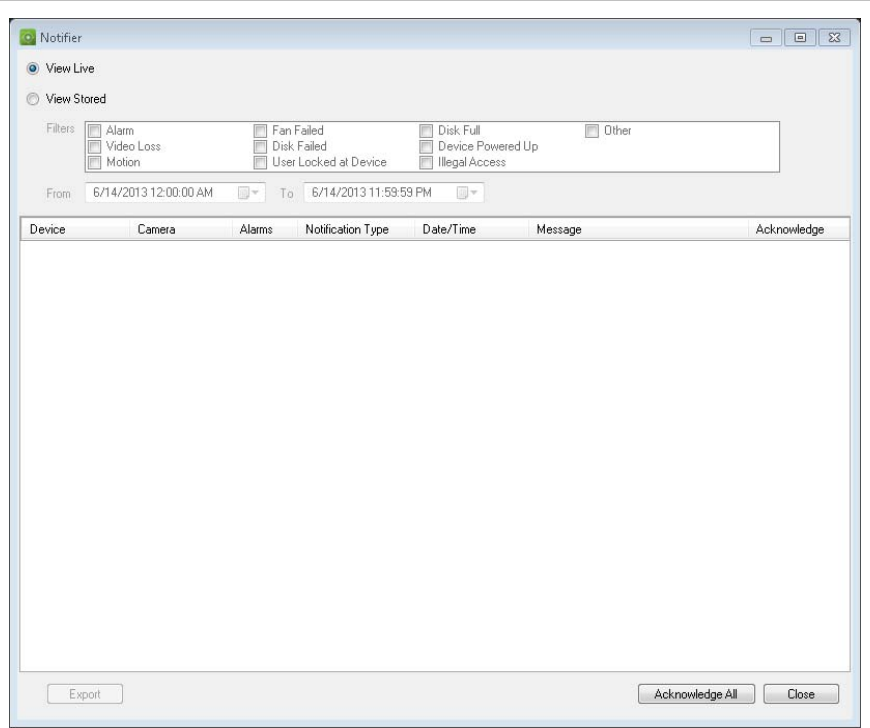
Chapter 4: TruVision Navigator Settings
TruVision Navigator 5.0 Service Pack 3 User Manual 95
Figure 75: Notifier Window
From the Notifier, you can view video for live notifications as they are received by
double-clicking on the camera name link in the dialog. This will launch the video in the
Viewer. New, unacknowledged notifications are signified with a red alert icon over the
Notifier icon in the application status bar. You can also tie these live notifications to an
audible sound. See the Settings section for more information on this feature.
Once a live notification is acknowledged, it is considered a stored or historic notification
that can be searched. You can use the filters and time/date ranges to further define your
notification search. While in search mode (View Stored), a red alert icon will appear
over the Notifier icon in the application status bar if new live notifications are received.
To view the new notifications, select View Live in the Notifier and then sort and filter on
the columns as needed to find the latest notification. Double-click to access the video.
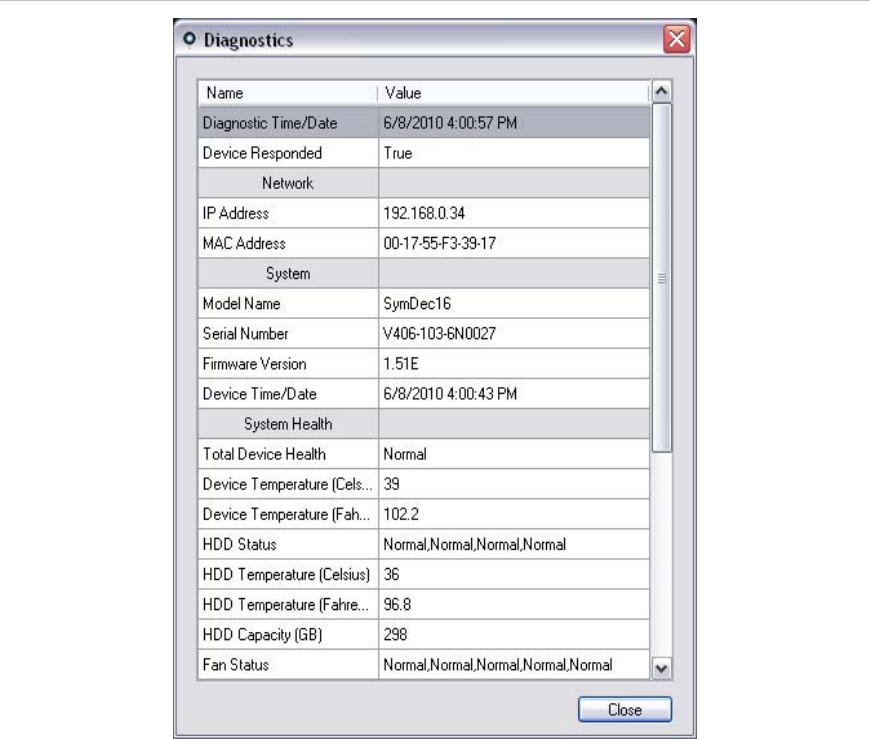
Chapter 4: TruVision Navigator Settings
96 TruVision Navigator 5.0 Service Pack 3 User Manual
Health Diagnostics
TruVision Navigator offers the ability to run a health diagnostic snapshot on a single
device or aggregate health diagnostic reporting across all of the devices in the system.
To run a manual health diagnostic snapshot on a single device, right-click on the device
in the Navigator and select Run Health Diagnostics.
The Diagnostics dialog will appear and show the full set of health diagnostic data for that
particular device. See the device-specific chapters for more details on the different
health diagnostics that are available per device.
Figure 76: Diagnostics Window
To run automated health diagnostic polling on an interval across all of the devices in the
system, the Diagnostic Polling service must first be configured. To configure the
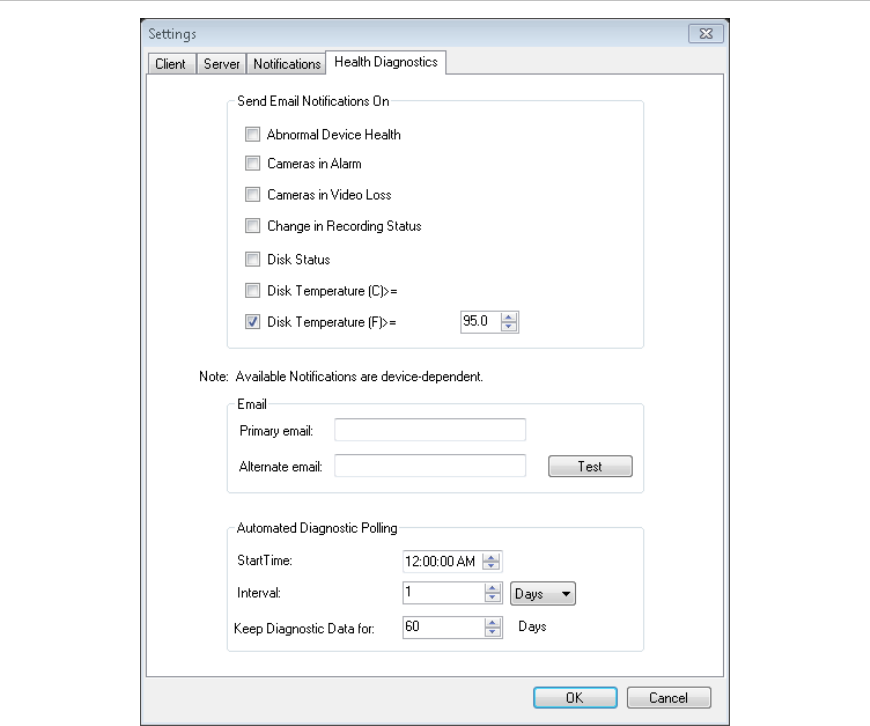
Chapter 4: TruVision Navigator Settings
TruVision Navigator 5.0 Service Pack 3 User Manual 97
Diagnostic Polling service, right-click on the TruVision Navigator Server node and select
Properties. The Settings dialog will appear with the Server tab selected.
Figure 77: Server Properties Window
From the Health Diagnostics Tab, enter the Diagnostic Polling Start Time and Interval.
Enter the retention period for the length of time to keep the health diagnostic polling data
in the database and click OK. Finally, restart the Diagnostic Polling service from the
Services dialog for the automated polling to begin. Remember, if any of these values
are changed, please restart the Diagnostic Polling service via the Services dialog for the
changes to take affect. (restarting the service in services dialog is only required on
client/server type installations.)
Once manual snapshots or automated health diagnostic data has been captured, that
data is stored in the TruVision Navigator database. That data is now searchable by
users to aid in maintaining up-time of the system.
Remember if you are searching in the Navigator for health diagnostic information and no
results can be found, you most likely have not setup your automated polling or run a
manual diagnostic against a single device.
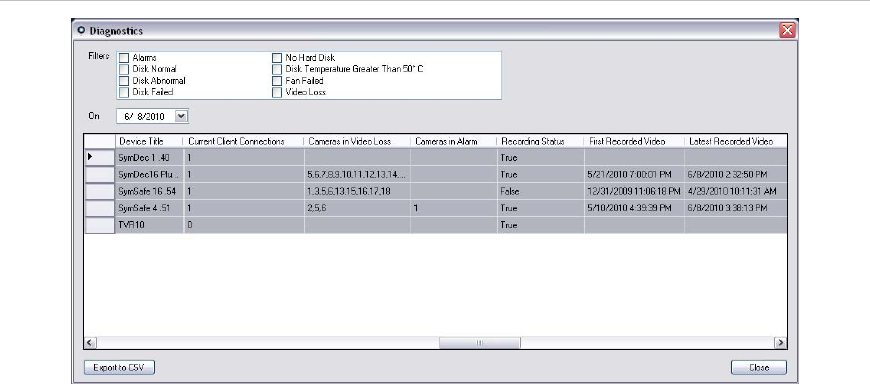
Chapter 4: TruVision Navigator Settings
98 TruVision Navigator 5.0 Service Pack 3 User Manual
To review health diagnostic data for all devices, right-click on the Devices node in the
Navigator and select Run Health Diagnostics. The Diagnostics dialog will appear. Use
the filters and date parameter to pinpoint your search. You can export the contents of
the dialog to .csv via the Export to CSV button for case management, work orders, or
issue resolution documentation.
Figure 78: Diagnostics Window
Device Report
TruVision Navigator lets the health diagnostics information to be exported by generating
a device report. To generate the device report;
• Right click on a recorder
• Select Device Report
After selecting device report option, a new window will display.
Note: It may take up to a minute to complete the device report, based on the number of
cameras recording to the device, and the network connection.
As a part of the report, tampering monitor images are also provided at the end. For more
information on tampering monitor, please see "Tampering Monitor" section.
Device report can be saved as .pdf or printed from the options given in the window
toolbar.

Chapter 4: TruVision Navigator Settings
TruVision Navigator 5.0 Service Pack 3 User Manual 99
Database backup and restore
TruVision Navigator offers users the ability to backup the TruVision Navigator database.
This backup should be moved off-machine by an Administrator for safekeeping. Should
something happen to the machine where the TruVision Navigator database resides, the
Administrator can install that same version of TruVision Navigator and restore the
database with the backup file. This will bring the system back into operation quickly
without manual re-entry of device, user, group, permission, or other system configuration
data.
To backup the TruVision Navigator database, right-click on the TruVision Navigator
Server node and select Database Backup. The Backup Database dialog will appear.
Provide a database backup name (no file extension is necessary) and take note of the
path where the database backup file will reside. The Administrator should copy or move
this file to a safe location. Upon initiation of the backup, refer to the Tasks panel for
status. After successful completion, your database backup file will reside at the
designated location.
Figure 79: Backup Database Dialog Window
To restore the TruVision Navigator database, right-click on the TruVision Navigator
Server node and select Database Restore. The Restore Database dialog will appear.
Ensure that a copy of the backup database file has been placed in the directory listed on
the form. Enter the exact name of the file in the text field provided. If you are restoring
the database to a SQL instance that requires SQL authentication credentials, enter
them. Otherwise, use the default setting. Upon initiation of the restore, refer to the
Tasks panel for status. Once you see the Restore Task in the Task panel, logout of the
application. Log back in and your database should be restored.
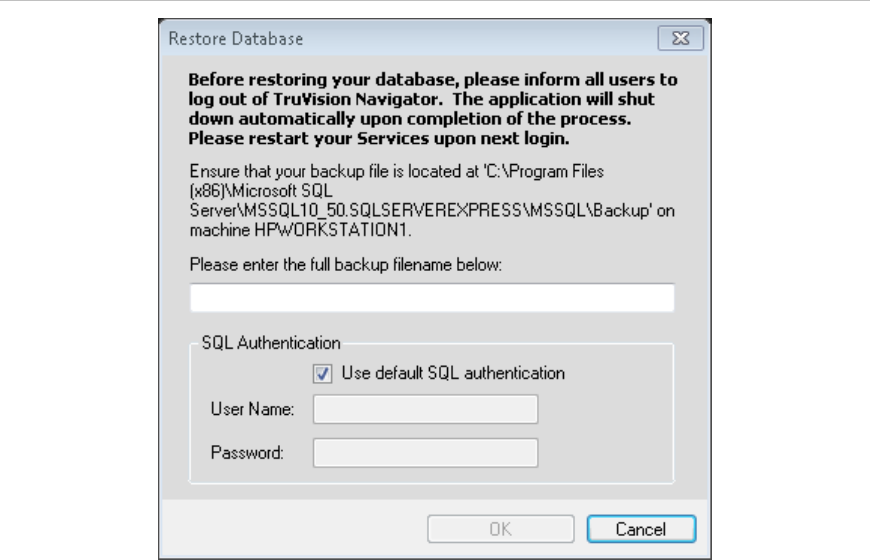
Chapter 4: TruVision Navigator Settings
100 TruVision Navigator 5.0 Service Pack 3 User Manual
Figure 80: Restore Database Window
Help
TruVision Navigator offers an easy to use Help function for more detailed system
instructions. You can also obtain TruVision Navigator version, copyright, and End-user
License Agreement information here. Organizations have the ability to add their own
custom Help or training link here to facilitate the adoption of the product.
Click on the question mark icon in the application status bar to launch the Help dialog.
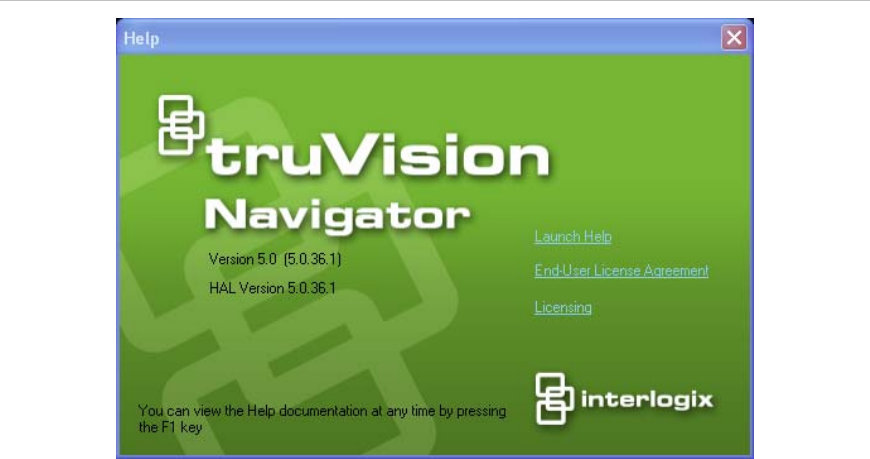
Chapter 4: TruVision Navigator Settings
TruVision Navigator 5.0 Service Pack 3 User Manual 101
Figure 81: Help Dialog Window
Licensing
TruVision Navigator has a licensing interface embedded to the Help screen. The
Licensing link will display the Licensed Features window for managing the TruVision
SVR recorder base and camera licenses. The Update license button will provide the
license management screen where user can change the required licenses, and add
more licenses via a new license key purchased from Interlogix.
Interlogix cameras, third party cameras and SVR physical servers can be swapped by a
comparable product as long as the number of licensed devices in TruVision Navigator
Server is not exceeded. Applied licenses create a pool of device groups (SVR recorders,
Interlogix cameras, third party cameras) that are supported by that TruVision Navigator
Server. Licenses can only be entered and applied on TruVision Navigator Server
machine. TruVision Navigator Clients pull the available licensed device information from
the TruVision Navigator Server.
See the TruVision SVR user manual for more information on licensing process.
Appendix A: Device Settings
102 TruVision Navigator 5.0 Service Pack 3 User Manual
Appendix A
Device Details
Summary
This Appendix contains important device information.
Content
DVMRe / StoreSafe (DVR) 103
SymDec / SymSafe (DVR) 107
DVSRxU (DVR) 112
TruVision TVR10 (DVR) 116
TruVision TVR30 (DVR) 120
TruVision TVR40 (DVR) 130
TruVision TVR60 (Hybrid DVR) 142
TruVision TVN40 (NVR) 150
Platform Out of Box Experience (OOBE) 171

Appendix A: Device Details
TruVision Navigator 5.0 Service Pack 3 User Manual 103
DVMRe / StoreSafe (DVR)
Feature Support Notes
Default Ports Video = 1024 (editable)
Command and Control = 1024
(editable)
Configuration = 1024 (editable)
Notifications = 1027 (editable)
Firmware Upload = 1024 (editable)
Default Username /
Password N/A
Compression Wavelet / Wavejet
Connection Types Wavelet
Streaming Limits 16 Live and 1 Playback streams
simultaneously See Connection Priority and Connection
Manager.
Stream Overlay Camera Name
Date and Time
Alarm Detection
High / Low Bandwidth Yes High bandwidth is color video and Low
Bandwidth is black and white video.
Dual Streaming No
Stream Nomenclature N/A
Playback Controls Switch to Live
Switch to Playback
Play
Pause
Frame Advance
Fast Forward (2x,32x,48x,64x)
Frame Reverse
Rewind (2x,16x,32x,48x,64x)
Adjustable Playback Speed
When fast forwarding video and it catches up to
present time (or Live video), the video in the
viewing tile will begin to play at the beginning of
the recorded video.
Snapshot Yes
Local Record Yes
Instant Replay Yes

Appendix A: Device Settings
104 TruVision Navigator 5.0 Service Pack 3 User Manual
Feature Support Notes
Disk Analysis Alarm
Motion
Video Loss
Recorded
Unknown (video data may or may
not be tagged with a type, and
therefore is marked as unknown)
Video Export Yes
TruVision Navigator
Player Yes .wvf proprietary file format.
PTZ Control Yes
Focus, Iris Control Yes
Presets Yes
Tours No Go To and Record is not supported.
Camera Search Alarm
Event
Motion
Text
However, Text Search is not available on the
DVMRe CS, DVMRe CD, DSR, or DVSE
models.
Motion Yes get the configuration for these devices via
TruVision Navigator and set the active zones on
a per camera basis via the Motion Detection
Tabs associated with each camera.
Audio Yes An audio module is required in these units.
There is 1 audio input per device. That input
can be mapped to any camera on the device
simply by where the microphone is located.
Enabling audio on the device is a global setting.
Access the setting by going to the device
configuration, and enabling the "G711" audio
option on the Audio Setup Tab. If enabled, as
soon as any camera from the device is added in
the TruVision Navigator Viewer, the audio will
play.

Appendix A: Device Details
TruVision Navigator 5.0 Service Pack 3 User Manual 105
Feature Support Notes
Notifications Alarm
Video Loss
Disk Full
Disk Failed
Authentication Lock Up
Device Powered Up
Fan Failed
Abnormal Temperature
DVMRe Pro, DVMRe CT or DVMRe CTII - to
setup these devices to send TCP notifications,
get the configuration of the device. Under the
Alarm menu, go to Notification and make sure
the notification method on the page is set to
TCP. Enable each of the notifications using the
radio buttons. Set the Primary host to the IP
address of where the TruVision Navigator
Server services are located (NotificationWriter
and NotificationProcessor). Set the port as the
same port as you set on Notifications Tab of the
TruVision Navigator Server Properties dialog.
Click Save for the device configuration changes
to be sent to the device. Restart the TruVision
Navigator Notification Writer and Notification
Processor Services via the Services dialog in
TruVision Navigator.
DVMRe ezT, StoreSafe, StoreSafe Pro, and
StoreSafe Pro II - to setup these devices to
send SMTP notifications, get the Configuration
of the device. Under the Alarm menu, go to
Notification and select the kind of notification
you want to receive by enabling the check box
“Send Email” for that selected value. Set the
one local email address of your SMTP server to
send the emails (Like FROM:) to Email
Address#1 and Email Address2. Set your
SMTP Server IP Address and Port number.
Click Save to push the configuration to the
device.
No Notifications Available in the device - DSR,
DVSE, DVMRe CS, and DVMRe CD.
Health Diagnostics IP Address
MAC Address
Model Name
Serial Number
Firmware Version
Device Time/Date
HDD Capacity (Gb)
Cameras in Video Loss
Cameras in Alarm
Current Client Connections
Record Status
Record Time Left
Video Stored (Hours)
Power on Duration
Device Export Time Left

Appendix A: Device Settings
106 TruVision Navigator 5.0 Service Pack 3 User Manual
Feature Support Notes
Firmware Upload No Remote firmware uploads must be done from
the device’s web browser and not via TruVision
Navigator. This includes all DVMRe models, all
StoreSafe models, the DSR, and the DVSE.
Bulk Firmware Upload No
Device Configuration Yes For certain models - DVMRe CS, DVMRe CD,
DVSE, and DSR, configuration must be done
via the device’s web browser and not via
TruVision Navigator.
Bulk Configuration No
Remote Reboot No

Appendix A: Device Details
TruVision Navigator 5.0 Service Pack 3 User Manual 107
SymDec / SymSafe (DVR)
Feature Support Notes
Default Ports Video = 5858 for TCP or 8100 to 8115 for
UDP (editable)
Command and Control = 1024 (editable)
Configuration = 1024 (editable)
Notifications = 1027 (editable)
Firmware Upload = 1024 (editable)
Default Username /
Password N/A
Compression MPEG4
Connection Types Reverse TCP
Reverse TCP I-frame
UDP
Streaming Limits 32 Live and 16 Playback streams
simultaneously This is however further restricted by the
bandwidth maximum of 32 * 3MB/sec.
Example: When all cameras are full D1
30FPS/ High quality (3MBs), you can
only have 32 streams (i.e. 16 Live, 16
Playback). When you change the frame
rate/resolution/quality to low (1MB/s), 32
Live+16 Playback can be achieved.
See Connection Manager and
Connection Priority.
Stream Overlay Camera Name
Date and Time
Bit rate
Alarm Detection
High / Low Bandwidth Yes Low bandwidth is only I-frames.
High bandwidth is I and P-frames.
Dual Streaming No
Stream Nomenclature N/A

Appendix A: Device Settings
108 TruVision Navigator 5.0 Service Pack 3 User Manual
Feature Support Notes
Playback Controls Switch to Live
Switch to Playback
Play
Pause
Frame Advance
Fast Forward
(2x,4x,8x,16x,32x,100x,300x)
Frame Reverse
Rewind (2x,4x,8x,16x,32x,,64x,100x)
When fast forwarding video and it
catches up to present time (or Live
video), the video in the viewing tile
pauses and will resume fast forward as
video becomes available.
Snapshot Yes
Local Record Yes Only available in High Bandwidth mode.
Instant Replay Yes
Disk Analysis Alarm
Motion
Video Loss
Recorded
Unknown (video data may or may not be
tagged with a type, and therefore is
marked as unknown)
Video Export Yes
TruVision Navigator
Player Yes .mpc proprietary file format.
PTZ Control Yes
Focus, Iris Control Yes
Presets Yes
Tours Go To
Record
16 tours are supported.
Camera Search Alarm
Event
Motion
Text
Text Search is not available on the
SymDec 1.
Motion Yes get the configuration for these devices
via TruVision Navigator and set the
active zones on a per camera basis via
the Motion Detection Tabs associated
with each camera.

Appendix A: Device Details
TruVision Navigator 5.0 Service Pack 3 User Manual 109
Feature Support Notes
Audio Yes There are 2 (SymSafe) or 4 (SymDec)
audio inputs per device that are mapped
to Cameras 1 to 2 or 1 to 4 respectively.
Microphones would need to be in the
locations with those cameras. Enabling
audio on the device is a per channel
setting. Access the setting by going to
the camera configuration, and enabling
the audio option on the Recording Tab.
If enabled, you can hear audio by adding
that camera in the Viewer and selecting
it. Audio will only play for the selected
camera.

Appendix A: Device Settings
110 TruVision Navigator 5.0 Service Pack 3 User Manual
Feature Support Notes
Notifications Alarm
Video Loss
Disk Full
Disk Failed
Authentication Lock Up
Device Powered Up
Fan Failed
Abnormal Temperature
To setup a SymSafe or SymDec16 to
send TCP notifications, get the
configuration of the device. Under the
Network menu, go to Network
Notification and make sure each
notification on the page is set to TCP.
Under Notification Setup, make sure the
Alarm Server 1 is set to the IP address
of where the TruVision Navigator Server
services are located (Notification Writer
and Notification Processor). Set the
Alarm port as the same port (TCP
Listener Port) you set on the
Notifications Tab of the TruVision
Navigator Server Properties dialog.
Click Save for the device configuration
changes to be sent to the device.
Restart the TruVision Navigator
Notification Writer and Notification
Processor Services via the Services
dialog in TruVision Navigator.
To setup a SymDec 1 or 4 to send
SMTP notifications, get the configuration
of the device. Under the Alarm menu,
go to Email. Enable each of the
notifications using the radio buttons. Set
the SMTP Server to the IP address of
where the TruVision Navigator Server
services are located (Notification Writer
and Notification Processor). Set the
SMTP port as the same port (Email
Listener Port) you set on the
Notifications Tab of the TruVision
Navigator Server Properties dialog.
Click Save for the device configuration
changes to be sent to the device.
Restart the TruVision Navigator
Notification Writer and Notification
Processor Services via the Services
dialog in TruVision Navigator.

Appendix A: Device Details
TruVision Navigator 5.0 Service Pack 3 User Manual 111
Feature Support Notes
Health Diagnostics IP Address
MAC Address
Model Name
Serial Number
Firmware Version
Device Date/Time
Total Device Health
Device Temperature (C)
Device Temperature (F)
HDD Status
HDD Temperature (C)
HDD Temperature (F)
HDD Capacity (Gb)
Fan Status
Cameras in Video Loss
Cameras in Alarm
Current Client Connections
Record Status
First Recorded Video
Latest Recorded Video
Record Time Left (hours)
Video Stored (days)
Video Stored (hours)
Power on Duration
Device Export Time Left
Firmware Upload Yes
Bulk Firmware Upload Yes
Device Configuration Yes
Bulk Configuration Yes
Remote Reboot Yes

Appendix A: Device Settings
112 TruVision Navigator 5.0 Service Pack 3 User Manual
DVSRxU (DVR)
Feature Support Notes
Default Ports Video = 8000 (editable)
Command and Control = 8000
(editable)
Configuration = 8000 (editable)
Notifications = 5001 (editable)
Firmware Upload = 8000 (editable)
Default Username /
Password Administrator / 3477 We recommend changing this default password
at time of installation.
Compression H.264
Connection Types TCP
UDP
Streaming Limits 24 Live or Playback streams
simultaneously with a maximum of
6 streams per channel.
If connection lease is transferred among users
when connection limit is reached, the user
whose connection is taken will be disconnected
from the device and all videos closed - see
Connection Manager.
Stream Overlay Camera Name
Date and Time
High / Low Bandwidth No
Dual Streaming Yes

Appendix A: Device Details
TruVision Navigator 5.0 Service Pack 3 User Manual 113
Feature Support Notes
Stream
Nomenclature The Main stream is referred to as:
On-Screen-Display = Schedule
Web Browser = Main stream
TruVision Navigator = Main stream
The Sub stream is referred to as:
On-Screen-Display = N/A
Web Browser = Sub stream
TruVision Navigator = Sub stream
The Event stream is referred to as:
On-Screen-Display = Event
Web Browser = Event
TruVision Navigator = Event
The Time Lapse stream is referred
to as:
On-Screen-Display = Time Lapse
Web Browser = Time Lapse
TruVision Navigator = Time Lapse
The Sub stream, Event, and Time Lapse
streams are derivative configurations of the Main
stream.
Typically, the Main stream is recorded on a
schedule, the Event stream is recorded on
Event, the Time Lapse stream is recorded
continuously, and the Sub stream can be viewed
Live
Playback Controls Switch to Live
Switch to Playback
Play
Pause
Frame Advance
Fast Forward (2x,4x)
Frame Reverse, Rewind, and Playback Speeds
are not supported.
Video jumps back 4 seconds after resume
playback from Fast Forward and Frame
Advance.
When fast forwarding video and it catches up to
present time (or Live video), the video in the
viewing tile will remain paused until the user
clicks the Live button in the Controller. No other
playback controls will work until the Live button is
selected.
Snapshot Yes
Local Record Yes Pause during local record is not supported.

Appendix A: Device Settings
114 TruVision Navigator 5.0 Service Pack 3 User Manual
Feature Support Notes
Instant Replay Yes There is a 2 to 5 minute video buffer in the
device. While video is in the buffer, it cannot be
viewed. Once the buffer fills, the video is written
to the hard drive and is available for playback.
This affects Instant Replay and the Playback
button in TruVision Navigator. Those 2 features
get their time increment from the user-defined
Instant Replay configuration on the TruVision
Navigator Server Properties Tab. As a result,
set this time increment to greater than 5 minutes
to be safe. If you try to search for video that is
still in the buffer, you will be taken to Live video.
Disk Analysis Alarm
Motion
Recorded
Unknown
Video Loss is not supported in disk analysis.
Disk analysis takes approximately 45 to 90
seconds depending on the amount of recorded
data on the device.
Video Export Yes There will be approximately 4 seconds of
additional video exported prior to the specified
start time.
TruVision Navigator
Player Yes .mp4 proprietary file format.
PTZ Control Yes
Focus, Iris Control Yes PTZ protocol ge RS-485 does not support Focus
and Iris commands in this release.
Presets Yes
Tours Go To
Record
Only 1 tour is supported (which is hard coded to
Tour 1 on the PTZ camera).
Camera Search Alarm
Event
Motion
Text Search is not supported on the device.
Motion Yes
get the configuration for this device via TruVision
Navigator and set the active zones on a per
camera basis via the Motion Configuration option
associated with each camera.
Audio Yes There are 16 audio inputs per device (1 per
channel). Enabling audio on the device is a per
channel setting. Access the settings by going to
the device configuration, and enabling the audio
option on the Recording Tab for each camera. If
enabled, as soon as any camera from the device
is added in the TruVision Navigator Viewer and
selected, the audio will play.

Appendix A: Device Details
TruVision Navigator 5.0 Service Pack 3 User Manual 115
Feature Support Notes
Notifications Alarm
Video Loss
Motion
Disk Full
Disk Failure
To setup the device to send TCP notifications for
cameras, right-click on the device in the
Navigator and select Configure Device. On the
Camera Tab’s Event Section, select the events
you would like to receive and set the schedules
as appropriate. On the Camera Tab’s Rules
Section, for each event type, ensure that “notify
me” is selected. Repeat for each event type. On
the Notifications Tab, the Notify IP Address
should be the IP address of where the TruVision
Navigator Server services are located
(Notification Writer and Notification Processor).
The Notify Port is defaulted to 5001 and is
editable. Ensure this port matches the one listed
on the TruVision Navigator Server Properties
dialog, Notifications Tab.
To setup the device to send TCP notifications for
the device itself (i.e. Disk Full and Disk Failure),
right-click on the device in the Navigator and
select Configure Device. On the Notification
Tab, for each notification type, ensure that “notify
me” is selected. Repeat for each notification type
and click Save. Ensure the notification port on
the device matches that of TruVision Navigator
Server as described above.
Restart both the Notification Writer and
Notification Processor for TruVision Navigator to
process the notifications.
Health Diagnostics IP Address
MAC Address
Model Name
Serial Number
Firmware Version
Device Date/Time
Total Device Health
HDD Status
HDD Capacity
Cameras in Video Loss
Cameras in Alarm
Current Client Connections
Record Status
Firmware Upload Yes
Bulk Firmware
Upload Yes
Device Configuration Yes

Appendix A: Device Settings
116 TruVision Navigator 5.0 Service Pack 3 User Manual
Feature Support Notes
Bulk Configuration Yes
Remote Reboot Yes
TruVision TVR10 (DVR)
Feature Support Notes
Default Ports Video = 8000 (editable)
Command and Control = 8000
(editable)
Configuration = 8000 (editable)
Notifications = 5001 (editable)
Firmware Upload = 8000 (editable)
Default
Username /
Password
admin / 1234 We recommend changing this default password at
time of installation.
Compression H.264
Connection
Types TCP
UDP
Streaming Limits 24 Live or Playback streams
simultaneously with a maximum of 6
streams per channel.
If connection lease is transferred among users
when connection limit is reached, the user whose
connection is taken will be disconnected from the
device and all videos closed - see Connection
Manager.
Stream Overlay Camera Name
Date and Time
High / Low
Bandwidth No
Dual Streaming Yes

Appendix A: Device Details
TruVision Navigator 5.0 Service Pack 3 User Manual 117
Feature Support Notes
Stream
Nomenclature The Mainstream is referred to as:
On-Screen-Display = Time Lapse
Web Browser = Mainstream
TruVision Navigator = Mainstream
The Sub stream is referred to as:
On-Screen-Display = N/A
Web Browser = Sub stream
TruVision Navigator = Sub stream
Event Stream is not supported on the device.
Playback
Controls Switch to Live
Switch to Playback
Play
Pause
Frame Advance
Fast Forward (2x,4x)
Frame Reverse, Rewind, and Playback Speeds are
not supported.
Video jumps back 4 seconds after resume playback
from Fast Forward and Frame Advance.
When fast forwarding video and it catches up to
present time (or Live video), the video in the
viewing tile will remain paused until the user clicks
the Live button in the Controller. No other playback
controls will work until the Live button is selected.
Snapshot Yes
Local Record Yes Pause during local record is not supported.
Instant Replay Yes There is a 2 to 5 minute video buffer in the device.
While video is in the buffer, it cannot be viewed.
Once the buffer fills, the video is written to the hard
drive and is available for playback. This affects
Instant Replay and the Playback button in
TruVision Navigator. Those 2 features get their
time increment from the user-defined Instant
Replay configuration on the TruVision Navigator
Server Properties Tab. As a result, set this time
increment to greater than 5 minutes to be safe. If
you try to search for video that is still in the buffer,
you will be taken to Live video.
Disk Analysis Alarm
Motion
Recorded
Unknown
Video Loss is not supported in disk analysis.
Disk analysis takes approximately 15-45 seconds
depending on the amount of recorded data on the
device.
Video Export Yes There will be approximately 4 seconds of additional
video exported prior to the specified start time.
TruVision
Navigator Player Yes .mp4 proprietary file format.
PTZ Control Yes

Appendix A: Device Settings
118 TruVision Navigator 5.0 Service Pack 3 User Manual
Feature Support Notes
Focus, Iris
Control Yes
Presets Yes
Tours Go To
Record
Only 1 tour is supported (which is hard coded to
Tour 1 on the PTZ camera).
Camera Search Alarm
Event
Motion
Text Search is not supported on the device.
Motion Yes
get the configuration for this device via TruVision
Navigator and set the active zones on a per camera
basis via the Motion Configuration option
associated with each camera.
Audio Yes There is 1 audio input per device. That input can be
mapped to any camera on the device simply by
enabling audio on that camera. Access the setting
by going to the device configuration, and enabling
the audio option on the Recording Tab for each
camera. If enabled, as soon as any camera from
the device is added in the TruVision Navigator
Viewer and selected, the audio will play.

Appendix A: Device Details
TruVision Navigator 5.0 Service Pack 3 User Manual 119
Feature Support Notes
Notifications Alarm
Video Loss
Motion
Disk Full
Disk Failure
To setup the device to send TCP notifications for
cameras, right-click on the device in the Navigator
and select Configure Device. On the Camera Tab’s
Event Section, select the events you would like to
receive and set the schedules as appropriate. On
the Camera Tab’s Rules Section, for each event
type, ensure that “notify me” is selected. Repeat for
each event type. On the Notifications Tab, the
Notify IP Address should be the IP address of
where the TruVision Navigator Server services are
located (Notification Writer and Notification
Processor). The Notify Port is defaulted to 5001
and is editable. Ensure this port matches the one
listed on the TruVision Navigator Server Properties
dialog, Notifications Tab.
To setup the device to send TCP notifications for
the device itself (i.e. Disk Full and Disk Failure),
right-click on the device in the Navigator and select
Configure Device. On the Notification Tab, for each
notification type, ensure that “notify me” is selected.
Repeat for each notification type and click Save.
Ensure the notification port on the device matches
that of TruVision Navigator Server as described
above.
Restart both the Notification Writer and Notification
Processor for TruVision Navigator to process the
notifications.
Email notification is not supported at the device-
level.
Health
Diagnostics IP Address
MAC Address
Model Name
Serial Number
Firmware Version
Device Date/Time
Total Device Health
HDD Status
HDD Capacity
Cameras in Video Loss
Cameras in Alarm
Current Client Connections
Record Status
Firmware Upload Yes
Bulk Firmware
Upload Yes

Appendix A: Device Settings
120 TruVision Navigator 5.0 Service Pack 3 User Manual
Feature Support Notes
Device
Configuration Yes
Bulk
Configuration Yes
Remote Reboot Yes
Deivce log
support Yes
TruVision TVR11 / TVR12 (DVR)
Feature Support Notes
Default Ports Video = 8000 (editable)
Command and Control = 8000
(editable)
Configuration = 8000 (editable)
Notifications = 5001 (editable)
Firmware Upload = 8000 (editable)
Default
Username /
Password
admin / 1234 We recommend changing this default password at
time of installation.
Compression H.264
Connection
Types TCP
UDP
Streaming Limits 64 Live or Playback streams
simultaneously including those
viewed via web alarm.
If connection lease is transferred among users
when connection limit is reached, the user whose
connection is taken will be disconnected from the
device and all videos closed - see Connection
Manager.
Stream Overlay Camera Name
Date and Time
High / Low
Bandwidth No
Dual Streaming Yes

Appendix A: Device Details
TruVision Navigator 5.0 Service Pack 3 User Manual 121
Feature Support Notes
Stream
Nomenclature The Mainstream is referred to as:
On-Screen-Display = Time Lapse
Web Browser = Mainstream
TruVision Navigator = Mainstream
The Sub stream is referred to as:
On-Screen-Display = N/A
Web Browser = Sub stream
TruVision Navigator = Sub stream
Event Stream is not supported on the device.
Playback
Controls Switch to Live
Switch to Playback
Play
Pause
Frame Advance
Fast Forward (2x,4x, 8x 16x)
Slow motion (1.0x, 0.5x, 0.25x,
0.125x, 0.0625x)
Frame Reverse, Rewind, and Playback Speeds are
not supported.
Video jumps back 4 seconds after resume playback
from Fast Forward and Frame Advance.
When fast forwarding video and it catches up to
present time (or Live video), the video in the
viewing tile will remain paused until the user clicks
the Live button in the Controller. No other playback
controls will work until the Live button is selected.
Snapshot Yes
Local Record Yes Pause during local record is not supported.
Instant Replay Yes There is a 2 to 5 minute video buffer in the device.
While video is in the buffer, it cannot be viewed.
Once the buffer fills, the video is written to the hard
drive and is available for playback. This affects
Instant Replay and the Playback button in
TruVision Navigator. Those 2 features get their
time increment from the user-defined Instant
Replay configuration on the TruVision Navigator
Server Properties Tab. As a result, set this time
increment to greater than 5 minutes to be safe. If
you try to search for video that is still in the buffer,
you will be taken to Live video.
Disk Analysis Alarm
Motion
Recorded
Unknown
Video Loss is not supported in disk analysis.
Disk analysis takes approximately 15-45 seconds
depending on the amount of recorded data on the
device.
Video Export Yes There will be approximately 4 seconds of additional
video exported prior to the specified start time.
TruVision
Navigator Player Yes .mp4 proprietary file format.
PTZ Control Yes

Appendix A: Device Settings
122 TruVision Navigator 5.0 Service Pack 3 User Manual
Feature Support Notes
Focus, Iris
Control Yes
Presets Yes
Tours Go To
Record
Only 1 tour is supported (which is hard coded to
Tour 1 on the PTZ camera).
Camera Search Alarm
Event
Motion
Text
POS Text Yes
Motion Yes
Get the configuration for this device via TruVision
Navigator and set the active zones on a per camera
basis via the Motion Configuration option
associated with each camera.
Audio Yes There are 4 audio input per device. That input can
be mapped to any camera on the device simply by
enabling audio on that camera. Access the setting
by going to the device configuration, and enabling
the audio option on the Recording Tab for each
camera. If enabled, as soon as any camera from
the device is added in the TruVision Navigator
Viewer and selected, the audio will play.
Bi-directional
Audio Yes

Appendix A: Device Details
TruVision Navigator 5.0 Service Pack 3 User Manual 123
Feature Support Notes
Notifications Alarm
Video Loss
Motion
Disk Full
Disk Failure
To setup the device to send TCP notifications for
cameras, right-click on the device in the Navigator
and select Configure Device. On the Camera Tab’s
Event Section, select the events you would like to
receive and set the schedules as appropriate. On
the Camera Tab’s Rules Section, for each event
type, ensure that “notify me” is selected. Repeat for
each event type. On the Notifications Tab, the
Notify IP Address should be the IP address of
where the TruVision Navigator Server services are
located (Notification Writer and Notification
Processor). The Notify Port is defaulted to 5001
and is editable. Ensure this port matches the one
listed on the TruVision Navigator Server Properties
dialog, Notifications Tab.
To setup the device to send TCP notifications for
the device itself (i.e. Disk Full and Disk Failure),
right-click on the device in the Navigator and select
Configure Device. On the Notification Tab, for each
notification type, ensure that “notify me” is selected.
Repeat for each notification type and click Save.
Ensure the notification port on the device matches
that of TruVision Navigator Server as described
above.
Restart the Notification Processor service for
TruVision Navigator to process the notifications.
Email notification is not supported at the device-
level.
Health
Diagnostics IP Address
MAC Address
Model Name
Serial Number
Firmware Version
Device Date/Time
Total Device Health
HDD Status
HDD Capacity
Cameras in Video Loss
Cameras in Alarm
Current Client Connections
Record Status
Firmware Upload Yes
Bulk Firmware
Upload Yes
Device
Configuration Yes

Appendix A: Device Settings
124 TruVision Navigator 5.0 Service Pack 3 User Manual
Feature Support Notes
Bulk
Configuration Yes
Device Log
Support Yes
Remote Reboot Yes
TruVision TVR20 (DVR)
Feature TVR20
Default Ports Video = 80 (editable)
Command and Control = 80 (editable)
Configuration = 80 (editable)
Notifications = 1600 (editable)
Firmware Upload = 80 (editable)
Default Username /
Password admin
1234
We recommend changing this default password at time of installation.
Default IP Address 192.168.1.82
Compression H.264
Connection Types TCP
UDP
Streaming Limits 16 live and 4 playback streams simultaneously
Stream Overlay Camera Name
Date and Time
High / Low Bandwidth No
Dual Streaming Primary and alternate streams are available on both live and
playback. Dual straming can be set on each camera rather than
globally for the entire device.
Stream Nomenclature N/A
Playback Controls Play
Pause
Frame Advance
Fast Forward (1x,2x,4x,8x)
Frame Reverse
Rewind (1x,2x,4x,8x)
Digital Zoom No
Snapshot Yes
Local Record Yes

Appendix A: Device Details
TruVision Navigator 5.0 Service Pack 3 User Manual 125
Feature TVR20
Instant Replay Yes
Disk Analysis Alarm
Motion
Video Loss
Untagged
Video Export Yes
TruVision Navigator
Player Yes
.avr proprietary file format.
PTZ Control Yes
Focus, Iris, Zoom Yes
Presets Yes
Tours No
Camera Search Alarm
Motion
Text
Smart Search Yes
Point-of-Sale Text Yes
Overlay on video only (via the Settings Dialog - In Band setting)
Motion Yes
Get the configuration for this device via TruVision Navigator and set
the active zones on a per camera basis via the Motion Configuration
option associated with each camera on the Cameras Tab.
Audio Yes
4 channel and 8 channel devices have 2 audio input ports.
16 channel has 4 audio input ports.
A
udio channels corresponds to cameras. (i.e. port 1 to camera 1, port
2 to camera 2.)
Bi-directional Audio Yes

Appendix A: Device Settings
126 TruVision Navigator 5.0 Service Pack 3 User Manual
Feature TVR20
Notifications Alarm
Motion
Video Loss
Disk failed
Disk full
Fan failed
Abnormal temperature
Device powered up
Recording stopped
Recording started
Authentication lockup
Network disconnected
Health Diagnostics IP address
Subnet mask
Gateway
MAC Address
Model name
Serial number
Firmware version
Date/time
Cameras in video loss
Current client connections
Disk capacity
Logical disk count
Physical disk count
Disk temperature celcius
Disk temperature farenheit
Recording status
First recorded video
Last recorded video
Video format
Firmware Upload Yes
Bulk Firmware Upload Yes
Device Configuration Yes
Bulk Configuration Yes
Remote Reboot Yes
UTCFS - IP Camera
Support N/A
3rd Party - IP Camera
Support N/A
3rd Party - IP Camera
Support N/A

Appendix A: Device Details
TruVision Navigator 5.0 Service Pack 3 User Manual 127
TruVision TVR30 (DVR)
Feature Support Notes
Default Ports Video = 80 (editable)
Command and Control = 80
(editable)
Configuration = 80 (editable)
Notifications = 5000 (editable)
Firmware Upload = 80 (editable)
Video and control port changes must be done from
the front panel of the device.
Default Username
/ Password admin / 1234 We recommend changing this default password at
time of installation.
Compression H.264
Connection Types TCP
TCP I-frame
Streaming Limits 16 live or 16 playback streams per
connection on 16 channel (maximum
of 8 connections). 8 live or 8
playback streams per connection on
8 channel units (maximum of 8
connections).
If Connection lease is transferred among users
when connection limit is reached, the user whose
connection is taken will be disconnected from
device and all videos closed.
Stream Overlay Camera Name
Date and Time
High / Low
Bandwidth Yes High/Low bandwidth stream switching is global
and affects all cameras of a device.
Dual Streaming Yes Primary/Alternate stream switching is global and
affects all cameras of a device.
Alternate stream switching during Playback is not
supported.
Stream
Nomenclature N/A
Playback Controls Switch to Live
Switch to Playback
Play
Pause
Frame Advance
Fast Forward (2x,4x,8x,16x,32x,64x)
Frame Reverse
Rewind (2x,4x,8x,16x,32x,,64x)
When fast forwarding video and it catches up to
present time (or Live video), the video in the
viewing tile will remain paused until the user clicks
the Live button in the Controller. No other
playback controls will work until the Live button is
selected.
Live and Playback video will drop frames and slow
down if there is substantial network traffic.
When executing a seek operation for playback,
video will temporarily switch to live, and then
switch to the new seek time.
Snapshot Yes

Appendix A: Device Settings
128 TruVision Navigator 5.0 Service Pack 3 User Manual
Feature Support Notes
Local Record Yes The device only supports local record for one
camera at a time. If user has a local recording
going and tries to initiate another camera from the
same device, the original local recording will be
stopped and a then the new local recording will
begin.
Instant Replay Yes
Disk Analysis Alarm
Motion
Video Loss
Unknown
Disk analysis takes approximately 30-60 seconds
depending on the amount of recorded data on the
device.
Video Export Yes The file size approximation in the Collector for
video export is not accurate for this device.
TruVision
Navigator Player Yes .video proprietary file format.
PTZ Control Yes
Focus, Iris Control Yes
Presets Yes
Tours No Go To and Record is not supported.
Camera Search Alarm
Event
Motion
Text search is not supported.
Motion Yes get the configuration for this device via TruVision
Navigator and set the active zones on a per
camera basis via the Motion Configuration option
associated with each camera on the Cameras
Tab.
Audio Yes There is 1 audio input per channel. Enabling audio
on the device is a per channel setting. Access the
settings by going to the device configuration, and
enabling the audio option on the Cameras Tab for
each camera. If enabled, as soon as any camera
from the device is added in the TruVision
Navigator Viewer and selected, the audio will play.
Audio is not supported when switching to the
Alternate stream.

Appendix A: Device Details
TruVision Navigator 5.0 Service Pack 3 User Manual 129
Feature Support Notes
Notifications Alarm
Motion
Video Loss
Disk Full
Hard Disk Error
To setup the device to send TCP notifications for
cameras, right-click on the device in the Navigator
and select Configure Device. On the Camera
Tab’s Event Section, select the events you would
like to receive per camera. On the Alarms Tab,
Remote Alert section, the Notify IP Address should
be the IP address of where the TruVision
Navigator Server services are located (Notification
Writer and Notification Processor). The Notify Port
is defaulted to 5000 and is editable. Ensure this
port matches the one listed on the TruVision
Navigator Server Properties dialog, Notifications
Tab.
Restart both the Notification Writer and Notification
Processor for TruVision Navigator to process the
notifications.
Health
Diagnostics Host Name
IP Address
MAC Address
Equipment Name
Model Name
Hardware Revision
Firmware Version
Device Time/Date
Current Client Connections
Record Status
First Recorded Video
Latest Recorded Video
Video Stored (Days)
Video Stored (Hours)
Physical Disk Model Name
Physical Disk Count
HDD Status
HDD Capacity (Gb)
HDD Temperature (C)
HDD Temperature (F)

Appendix A: Device Settings
130 TruVision Navigator 5.0 Service Pack 3 User Manual
Feature Support Notes
Firmware Upload Yes To upload firmware to this device via TruVision
Navigator, download the firmware file with file
extension .tgz. Extract the .tar file to your desktop
from the .tgz. Right-click on the device in the
Navigator and select Upload Firmware. Browse
for the .tar file when prompted. Execute the
upload. Remember the Local Scheduling Service
needs to be running
After TruVision Navigator reports firmware upload
success in the Task Panel, the device will require
1-2 minute wait before the user can reconnect to
the device.
Bulk Firmware
Upload Yes
Device
Configuration Yes Does not currently support remote configuration of
resolution for recording.
DDNS when enabled usually causes the box to
slow down when getting / setting configuration.
Bulk Configuration Yes
Remote Reboot Yes Closing video tiles while the device is rebooting
will cause TruVision Navigator to freeze and
require the user to log back into the application.
TruVision TVR31 (DVR)
Feature Support Notes
Default Ports Video = 80 (editable)
Command and Control = 80
(editable)
Configuration = 80 (editable)
Notifications = 5000 (editable)
Firmware Upload = 80 (editable)
Video and control port changes must be done from
the front panel of the device.
Default Username
/ Password admin / 1234 We recommend changing this default password at
time of installation.
Compression H.264
Connection Types TCP
TCP I-frame

Appendix A: Device Details
TruVision Navigator 5.0 Service Pack 3 User Manual 131
Feature Support Notes
Streaming Limits 16 channel: 16 live or 16 playback
streams per connection on 16
channel (maximum of 8
connections).
8 channel: 8 live or 8 playback
streams per connection on 8 channel
units (maximum of 8 connections).
If Connection lease is transferred among users
when connection limit is reached, the user whose
connection is taken will be disconnected from
device and all videos closed.
Stream Overlay Camera Name
Date and Time
High / Low
Bandwidth Yes High/Low bandwidth stream switching is global
and affects all cameras of a device.
Dual Streaming Yes Primary/Alternate stream switching is global and
affects all cameras of a device.
Alternate stream switching during Playback is not
supported.
Stream
Nomenclature N/A
Playback Controls Switch to Live
Switch to Playback
Play
Pause
Frame Advance
Fast Forward (2x, 4x, 8x, 16x, 32x)
Frame Reverse
Rewind (2x, 4x, 8x, 16x, 32x)
When fast forwarding video and it catches up to
present time (or Live video), the video in the
viewing tile will remain paused until the user clicks
the Live button in the Controller. No other
playback controls will work until the Live button is
selected.
Live and Playback video will drop frames and slow
down if there is substantial network traffic.
When executing a seek operation for playback,
video will temporarily switch to live, and then
switch to the new seek time.
Snapshot Yes
Local Record Yes The device only supports local record for one
camera at a time. If user has a local recording
going and tries to initiate another camera from the
same device, the original local recording will be
stopped and a then the new local recording will
begin.
Instant Replay Yes
Disk Analysis Alarm
Motion
Video Loss
Unknown
Disk analysis takes approximately 30-60 seconds
depending on the amount of recorded data on the
device.
Video Export Yes The file size approximation in the Collector for
video export is not accurate for this device.

Appendix A: Device Settings
132 TruVision Navigator 5.0 Service Pack 3 User Manual
Feature Support Notes
TruVision
Navigator Player Yes .video proprietary file format.
PTZ Control Yes
Focus, Iris Control Yes
Presets Yes
Tours No Go To and Record is not supported.
Camera Search Alarm
Event
Motion
Text
Point of Sale Yes Overlay on video or placed next to the video (via
the Settings Dialog - In Band or Out of Band
setting)
Motion Yes Get the configuration for this device via TruVision
Navigator and set the active zones on a per
camera basis via the Motion Configuration option
associated with each camera on the Cameras
Tab.
Audio Yes There is 1 audio input per channel. Enabling audio
on the device is a per channel setting. Access the
settings by going to the device configuration, and
enabling the audio option on the Cameras Tab for
each camera. If enabled, as soon as any camera
from the device is added in the TruVision
Navigator Viewer and selected, the audio will play.
Audio is not supported when switching to the
Alternate stream.
Bi-directional
Audio Yes
Notifications Alarm
Motion
Video Loss
Disk Full
Hard Disk Error
To setup the device to send TCP notifications for
cameras, right-click on the device in the Navigator
and select Configure Device. On the Camera
Tab’s Event Section, select the events you would
like to receive per camera. On the Alarms Tab,
Remote Alert section, the Notify IP Address should
be the IP address of where the TruVision
Navigator Server services are located (Notification
Writer and Notification Processor). The Notify Port
is defaulted to 5000 and is editable. Ensure this
port matches the one listed on the TruVision
Navigator Server Properties dialog, Notifications
Tab.
Restart both the Notification Writer and Notification
Processor for TruVision Navigator to process the
notifications.

Appendix A: Device Details
TruVision Navigator 5.0 Service Pack 3 User Manual 133
Feature Support Notes
Health
Diagnostics Host Name
IP Address
MAC Address
Equipment Name
Model Name
Hardware Revision
Firmware Version
Device Time/Date
Current Client Connections
Record Status
First Recorded Video
Latest Recorded Video
Video Stored (Days)
Video Stored (Hours)
Physical Disk Model Name
Physical Disk Count
HDD Status
HDD Capacity (Gb)
HDD Temperature (C)
HDD Temperature (F)
Firmware Upload Yes To upload firmware to this device via TruVision
Navigator, download the firmware file with file
extension .tgz. Extract the .tar file to your desktop
from the .tgz. Right-click on the device in the
Navigator and select Upload Firmware. Browse
for the .tar file when prompted. Execute the
upload. Remember the Local Scheduling Service
needs to be running
After TruVision Navigator reports firmware upload
success in the Task Panel, the device will require
1-2 minute wait before the user can reconnect to
the device.
Bulk Firmware
Upload Yes
Device
Configuration Yes Does not currently support remote configuration of
resolution for recording.
DDNS when enabled usually causes the box to
slow down when getting / setting configuration.
Bulk Configuration Yes
Remote Reboot Yes Closing video tiles while the device is rebooting
will cause TruVision Navigator to freeze and
require the user to log back into the application.

Appendix A: Device Settings
134 TruVision Navigator 5.0 Service Pack 3 User Manual
TruVision TVR40 (DVR)
Feature Support Notes
Default Ports Video = 8000 (editable)
Command and Control = 8000
(editable)
Configuration = 8000 (editable)
Notifications = 5001 (editable)
Firmware Upload = 8000 (editable)
Default
Username /
Password
Administrator / 3477 We recommend changing this default password at
time of installation.
Compression H.264
Connection
Types TCP
UDP
Streaming
Limits 24 Live or Playback streams
simultaneously with a maximum of 6
streams per channel.
If connection lease is transferred among users when
connection limit is reached, the user whose
connection is taken will be disconnected from the
device and all videos closed - see Connection
Manager.
Stream Overlay Camera Name
Date and Time
High / Low
Bandwidth No
Dual Streaming Yes

Appendix A: Device Details
TruVision Navigator 5.0 Service Pack 3 User Manual 135
Feature Support Notes
Stream
Nomenclature The Main stream is referred to as:
On-Screen-Display = Schedule
Web Browser = Main stream
TruVision Navigator = Main stream
The Sub stream is referred to as:
On-Screen-Display = N/A
Web Browser = Sub stream
TruVision Navigator = Sub stream
The Event stream is referred to as:
On-Screen-Display = Event
Web Browser = Event
TruVision Navigator = Event
The Time Lapse stream is referred to
as:
On-Screen-Display = Time Lapse
Web Browser = Time Lapse
TruVision Navigator = Time Lapse
The Sub stream, Event, and Time Lapse streams are
derivative configurations of the Main stream.
Typically, the Main stream is recorded on a
schedule, the Event stream is recorded on Event, the
Time Lapse stream is recorded continuously, and the
Sub stream can be viewed Live
Playback
Controls Switch to Live
Switch to Playback
Play
Pause
Frame Advance
Fast Forward (2x,4x)
Frame Reverse, Rewind, and Playback Speeds are
not supported.
Video jumps back 4 seconds after resume playback
from Fast Forward and Frame Advance.
When fast forwarding video and it catches up to
present time (or Live video), the video in the viewing
tile will remain paused until the user clicks the Live
button in the Controller. No other playback controls
will work until the Live button is selected.
Snapshot Yes
Local Record Yes Pause during local record is not supported.
Instant Replay Yes There is a 2 to 5 minute video buffer in the device.
While video is in the buffer, it cannot be viewed.
Once the buffer fills, the video is written to the hard
drive and is available for playback. This affects
Instant Replay and the Playback button in TruVision
Navigator. Those 2 features get their time increment
from the user-defined Instant Replay configuration
on the TruVision Navigator Server Properties Tab.
As a result, set this time increment to greater than 5
minutes to be safe. If you try to search for video that
is still in the buffer, you will be taken to Live video.

Appendix A: Device Settings
136 TruVision Navigator 5.0 Service Pack 3 User Manual
Feature Support Notes
Disk Analysis Alarm
Motion
Recorded
Unknown
Video Loss is not supported in disk analysis.
Disk analysis takes approximately 45 to 90 seconds
depending on the amount of recorded data on the
device.
Video Export Yes There will be approximately 4 seconds of additional
video exported prior to the specified start time.
TruVision
Navigator
Player
Yes .mp4 proprietary file format.
PTZ Control Yes
Focus, Iris
Control Yes PTZ protocol ge RS-485 does not support Focus and
Iris commands in this release.
Presets Yes
Tours Go To
Record
Only 1 tour is supported (which is hard coded to Tour
1 on the PTZ camera).
Camera Search Alarm
Event
Motion
Text Search is not supported on the device.
Motion Yes get the configuration for this device via TruVision
Navigator and set the active zones on a per camera
basis via the Motion Configuration option associated
with each camera.
Audio Yes There are 16 audio inputs per device (1 per
channel). Enabling audio on the device is a per
channel setting. Access the settings by going to the
device configuration, and enabling the audio option
on the Recording Tab for each camera. If enabled,
as soon as any camera from the device is added in
the TruVision Navigator Viewer and selected, the
audio will play.

Appendix A: Device Details
TruVision Navigator 5.0 Service Pack 3 User Manual 137
Feature Support Notes
Notifications Alarm
Video Loss
Motion
Disk Full
Disk Failure
To setup the device to send TCP notifications for
cameras, right-click on the device in the Navigator
and select Configure Device. On the Camera Tab’s
Event Section, select the events you would like to
receive and set the schedules as appropriate. On
the Camera Tab’s Rules Section, for each event
type, ensure that “notify me” is selected. Repeat for
each event type. On the Notifications Tab, the Notify
IP Address should be the IP address of where the
TruVision Navigator Server services are located
(Notification Writer and Notification Processor). The
Notify Port is defaulted to 5001 and is editable.
Ensure this port matches the one listed on the
TruVision Navigator Server Properties dialog,
Notifications Tab.
To setup the device to send TCP notifications for the
device itself (i.e. Disk Full and Disk Failure), right-
click on the device in the Navigator and select
Configure Device. On the Notification Tab, for each
notification type, ensure that “notify me” is selected.
Repeat for each notification type and click Save.
Ensure the notification port on the device matches
that of TruVision Navigator Server as described
above.
Restart both the Notification Writer and Notification
Processor for TruVision Navigator to process the
notifications.
Health
Diagnostics IP Address
MAC Address
Model Name
Serial Number
Firmware Version
Device Date/Time
Total Device Health
HDD Status
HDD Capacity
Cameras in Video Loss
Cameras in Alarm
Current Client Connections
Record Status
Firmware
Upload Yes
Bulk Firmware
Upload Yes
Device
Configuration Yes

Appendix A: Device Settings
138 TruVision Navigator 5.0 Service Pack 3 User Manual
Feature Support Notes
Bulk
Configuration Yes
Remote Reboot Yes
TruVision TVR41 / TVR42 (DVR)
Feature Support Notes
Default Ports Video = 8000 (editable)
Command and Control = 8000
(editable)
Configuration = 8000 (editable)
Notifications = 5001 (editable)
Firmware Upload = 8000 (editable)
Default
Username /
Password
admin / 1234 We recommend changing this default password at
time of installation.
Compression H.264
Connection
Types TCP
UDP
Streaming Limits 64 Live or Playback streams
simultaneously including those used
by the web alarm.
If connection lease is transferred among users
when connection limit is reached, the user whose
connection is taken will be disconnected from the
device and all videos closed - see Connection
Manager.
Stream Overlay Camera Name
Date and Time
High / Low
Bandwidth No
Dual Streaming Yes

Appendix A: Device Details
TruVision Navigator 5.0 Service Pack 3 User Manual 139
Feature Support Notes
Stream
Nomenclature The Mainstream is referred to as:
On-Screen-Display = Time Lapse
Web Browser = Mainstream
TruVision Navigator = Mainstream
The Sub stream is referred to as:
On-Screen-Display = N/A
Web Browser = Sub stream
TruVision Navigator = Sub stream
Event Stream is not supported on the device.
Playback
Controls Play
Pause
Frame Advance
Fast Forward (1x, 2x, 4x, 8x,16x)
Slow motion (1.0x, 0.5x, 0.25x,
0.125x, 0.0625x)
Rewind (1x, 2x, 4x) -8
simultaneously
Video jumps back 4 seconds after resume playback
from Fast Forward and Frame Advance.
When fast forwarding video and it catches up to
present time (or Live video), the video in the
viewing tile will remain paused until the user clicks
the Live button in the Controller. No other playback
controls will work until the Live button is selected.
Digital Zoom Yes
Snapshot Yes
Local Record Yes
Instant Replay Yes
Disk Analysis Alarm
Motion
Recorded
Unknown
Video Loss is not supported in disk analysis.
Disk analysis takes approximately 15-45 seconds
depending on the amount of recorded data on the
device.
Video Export Yes There will be approximately 4 seconds of additional
video exported prior to the specified start time.
TruVision
Navigator Player Yes .mp4 proprietary file format.
PTZ Control Yes
Focus, Iris
Control Yes
Presets Yes
Tours Go To
Record
Only 1 tour is supported (which is hard coded to
Tour 1 on the PTZ camera).

Appendix A: Device Settings
140 TruVision Navigator 5.0 Service Pack 3 User Manual
Feature Support Notes
Camera Search Alarm
Event
Motion
Text
Smart Search Yes Browser only
Point-of-Sale Text Yes
Motion Yes
Get the configuration for this device via TruVision
Navigator and set the active zones on a per camera
basis via the Motion Configuration option
associated with each camera.
Audio Yes There are 4 audio input per device. That input can
be mapped to any camera on the device simply by
enabling audio on that camera. Access the setting
by going to the device configuration, and enabling
the audio option on the Recording Tab for each
camera. If enabled, as soon as any camera from
the device is added in the TruVision Navigator
Viewer and selected, the audio will play.
Bi-directional
Audio Yes

Appendix A: Device Details
TruVision Navigator 5.0 Service Pack 3 User Manual 141
Feature Support Notes
Notifications Alarm
Video Loss
Motion
Disk Full
Disk Failure
To setup the device to send TCP notifications for
cameras, right-click on the device in the Navigator
and select Configure Device. On the Camera Tab’s
Event Section, select the events you would like to
receive and set the schedules as appropriate. On
the Camera Tab’s Rules Section, for each event
type, ensure that “notify me” is selected. Repeat for
each event type. On the Notifications Tab, the
Notify IP Address should be the IP address of
where the TruVision Navigator Server services are
located (Notification Writer and Notification
Processor). The Notify Port is defaulted to 5001
and is editable. Ensure this port matches the one
listed on the TruVision Navigator Server Properties
dialog, Notifications Tab.
To setup the device to send TCP notifications for
the device itself (i.e. Disk Full and Disk Failure),
right-click on the device in the Navigator and select
Configure Device. On the Notification Tab, for each
notification type, ensure that “notify me” is selected.
Repeat for each notification type and click Save.
Ensure the notification port on the device matches
that of TruVision Navigator Server as described
above.
Restart the Notification Processor service for
TruVision Navigator to process the notifications.
Email notification is not supported at the device-
level.
Health
Diagnostics IP Address
MAC Address
Model Name
Serial Number
Firmware Version
Device Date/Time
Total Device Health
HDD Status
HDD Capacity
Cameras in Video Loss
Cameras in Alarm
Current Client Connections
Record Status
Firmware Upload Yes
Bulk Firmware
Upload Yes
Device
Configuration Yes

Appendix A: Device Settings
142 TruVision Navigator 5.0 Service Pack 3 User Manual
Feature Support Notes
Bulk
Configuration Yes
Device Log
Support Yes
Remote Reboot Yes
TruVision Generic TVR / TVN
Feature Support Notes
Default Ports Video = 8000 (editable)
Command and Control = 8000
(editable)
Configuration = 8000 (editable)
Notifications = 5001 (editable)
Firmware Upload = 8000 (editable)
Default
Username /
Password
admin / 1234 We recommend changing this default password at
time of installation.
Compression H.264
Connection
Types TCP
UDP
Streaming Limits 16 Live and 4 Playback streams
Stream Overlay No
High / Low
Bandwidth No
Dual Streaming Yes
Stream
Nomenclature The Mainstream is referred to as:
On-Screen-Display = Time Lapse
Web Browser = Mainstream
TruVision Navigator = Mainstream
The Sub stream is referred to as:
On-Screen-Display = N/A
Web Browser = Sub stream
TruVision Navigator = Sub stream
Event Stream is not supported on the device.

Appendix A: Device Details
TruVision Navigator 5.0 Service Pack 3 User Manual 143
Feature Support Notes
Playback
Controls Play
Pause
Frame Advance
Fast Forward (1x, 2x, 4x, 8x)
Slow motion (1.0x, 0.5x, 0.25x,
0.125x, 0.0625x)
Frame Reverse and Rewind Speeds
are directly dependant on the actual
device capabilities.
Video jumps back 4 seconds after resume playback
from Fast Forward and Frame Advance.
When fast forwarding video and it catches up to
present time (or Live video), the video in the
viewing tile will remain paused until the user clicks
the Live button in the Controller. No other playback
controls will work until the Live button is selected.
Digital Zoom Yes
Snapshot Yes
Local Record Yes
Instant Replay Yes
Disk Analysis Alarm
Motion
Recorded
Unknown
Video Loss is not supported in disk analysis.
Disk analysis takes approximately 15-45 seconds
depending on the amount of recorded data on the
device.
Video Export Yes There will be approximately 4 seconds of additional
video exported prior to the specified start time.
TruVision
Navigator Player Yes .mp4 proprietary file format.
PTZ Control Yes
Focus, Iris
Control Yes
Presets Yes
Tours Go To
Record
Only 1 tour is supported (which is hard coded to
Tour 1 on the PTZ camera).
Camera Search Alarm
Event
Motion
Text
Smart Search No
Point-of-Sale Text Yes
Motion No

Appendix A: Device Settings
144 TruVision Navigator 5.0 Service Pack 3 User Manual
Feature Support Notes
Audio Yes There are 4 audio input per device. That input can
be mapped to any camera on the device simply by
enabling audio on that camera. Access the setting
by going to the device configuration, and enabling
the audio option on the Recording Tab for each
camera. If enabled, as soon as any camera from
the device is added in the TruVision Navigator
Viewer and selected, the audio will play.
Bi-directional
Audio No
Notifications No
Health
Diagnostics IP Address
MAC Address
Model Name
Serial Number
Firmware Version
Device Date/Time
Total Device Health
HDD Status
HDD Capacity
Cameras in Video Loss
Cameras in Alarm
Current Client Connections
Record Status
Firmware Upload Yes
Bulk Firmware
Upload No
Device
Configuration No
Bulk
Configuration No
Device Log
Support No
Remote Reboot Yes

Appendix A: Device Details
TruVision Navigator 5.0 Service Pack 3 User Manual 145
TruVision TVR60 (Hybrid DVR)
Feature Support Notes
Default Ports Video = 8000 (editable)
Command and Control = 8000
(editable)
Configuration = 8000 (editable)
Notifications = 5001 (editable)
Firmware Upload = 8000 (editable)
Default Username
/ Password admin / 1234 We recommend changing this default password at
time of installation.
Compression H.264
Connection Types TCP
UDP
Streaming Limits 48 Live or Playback streams
simultaneously with a maximum of 6
streams per channel.
If connection lease is transferred among users
when connection limit is reached, the user whose
connection is taken will be disconnected from the
device and all videos closed - see Connection
Manager.
Stream Overlay Camera Name
Date and Time
High / Low
Bandwidth No
Dual Streaming Yes

Appendix A: Device Settings
146 TruVision Navigator 5.0 Service Pack 3 User Manual
Feature Support Notes
Stream
Nomenclature The Main stream is referred to as:
On-Screen-Display = Time Lapse
Web Browser = Time Lapse
TruVision Navigator = Main stream
The Sub stream is referred to as:
On-Screen-Display = Alarm
Web Browser = Alarm
TruVision Navigator = Sub stream
The Event stream is referred to as:
On-Screen-Display = N/A
Web Browser = Event
TruVision Navigator = Event
The Schedule stream is referred to
as:
On-Screen-Display = Schedule
Web Browser = Schedule
TruVision Navigator = Schedule
Playback Controls Switch to Live
Switch to Playback
Play
Pause
Frame Advance
Fast Forward (2x,4x,8x,16x)
Frame Reverse, Rewind, and Playback Speeds
are not supported.
Video jumps back 4 seconds after resume
playback from Fast Forward and Frame Advance.
When fast forwarding video and it catches up to
present time (or Live video), the video in the
viewing tile will remain paused until the user clicks
the Live button in the Controller. No other
playback controls will work until the Live button is
selected.
Snapshot Yes
Local Record Yes Pause during local record is not supported.

Appendix A: Device Details
TruVision Navigator 5.0 Service Pack 3 User Manual 147
Feature Support Notes
Instant Replay Yes There is a 2 to 5 minute video buffer in the device.
While video is in the buffer, it cannot be viewed.
Once the buffer fills, the video is written to the
hard drive and is available for playback. This
affects Instant Replay and the Playback button in
TruVision Navigator. Those 2 features get their
time increment from the user-defined Instant
Replay configuration on the TruVision Navigator
Server Properties Tab. As a result, set this time
increment to greater than 5 minutes to be safe. If
you try to search for video that is still in the buffer,
you will be taken to Live video.
Disk Analysis Alarm
Motion
Recorded
Unknown
Video Loss is not supported in disk analysis.
Disk analysis takes approximately 45 to 90
seconds depending on the amount of recorded
data on the device.
Video Export Yes There will be approximately 4 seconds of
additional video exported prior to the specified
start time.
TruVision
Navigator Player Yes .mp4 proprietary file format.
PTZ Control Yes
Focus, Iris Control Yes PTZ protocol ge RS-485 does not support Focus
and Iris commands in this release.
Presets Yes
Tours Go To
Record
Only 1 tour is supported (which is hard coded to
Tour 1 on the PTZ camera).
Camera Search Alarm
Event
Motion
Text Search is not supported on the device.
Motion Yes
Get the configuration for this device via TruVision
Navigator and set the active zones on a per
camera basis via the Motion Configuration option
associated with each camera.
Audio Yes There are 16 audio inputs per device (1 per
channel). Enabling audio on the device is a per
channel setting. Access the settings by going to
the device configuration, and enabling the audio
option on the Recording Tab for each camera. If
enabled, as soon as any camera from the device
is added in the TruVision Navigator Viewer and
selected, the audio will play.

Appendix A: Device Settings
148 TruVision Navigator 5.0 Service Pack 3 User Manual
Feature Support Notes
Notifications Alarm
Video Loss
Motion
Disk Full
Disk Failure
To setup the device to send TCP notifications for
cameras, right-click on the device in the Navigator
and select Configure Device. On the Camera
Tab’s Event Section, select the events you would
like to receive and set the schedules as
appropriate. On the Camera Tab’s Rules Section,
for each event type, ensure that “notify me” is
selected. Repeat for each event type. On the
Notifications Tab, the Notify IP Address should be
the IP address of where the TruVision Navigator
Server services are located (Notification Writer
and Notification Processor). The Notify Port is
defaulted to 5001 and is editable. Ensure this port
matches the one listed on the TruVision Navigator
Server Properties dialog, Notifications Tab.
To setup the device to send TCP notifications for
the device itself (i.e. Disk Full and Disk Failure),
right-click on the device in the Navigator and
select Configure Device. On the Notification Tab,
for each notification type, ensure that “notify me” is
selected. Repeat for each notification type and
click Save. Ensure the notification port on the
device matches that of TruVision Navigator Server
as described above.
Restart both the Notification Writer and Notification
Processor for TruVision Navigator to process the
notifications.
Health Diagnostics IP Address
MAC Address
Model Name
Serial Number
Firmware Version
Device Date/Time
Total Device Health
HDD Status
HDD Capacity
Cameras in Video Loss
Cameras in Alarm
Current Client Connections
Record Status
Firmware Upload Yes
Bulk Firmware
Upload Yes
Device
Configuration Yes

Appendix A: Device Details
TruVision Navigator 5.0 Service Pack 3 User Manual 149
Feature Support Notes
Bulk Configuration Yes
Remote Reboot Yes
IP Cameras UTC CamPlus2 IP Models -
Firmware:
UTCC-IP2VD-DN - V1.00E3
UTCC-IP2VD-DNP - V1.00E3
UTCC-IP2D - V1.00E2
UTCC-IP2D-P - V1.00E2)
UTCC-IP2B - V1.00E2)
UTCC-IP2B-P - V1.00E2)
UTC UltraView IP - Firmware:
UVC-IP-EVRDN-HR - 4.2.1, 53820
UVD-IP-EVRDNR - 4.2.1, 53820
UVC-IP-EVRDN-HR-P - 4.2.1,
53820
UVD-IP-EVRDNR-P - 4.2.1, 53820
UVC-IP-XP3DN-HR - 4.2.1, 53820
UVD-IP-XP3DNR - 4.2.1, 53820
UVC-IP-XP3DN-HR-P - 4.2.1,
53820
UVD-IP-XP3DNR-P - 4.2.1, 53820
UTC UltraView Encoder - Firmware:
UVE-101/DC105 (NTSC) - 4.2.1,
53820
UVE-101/DC105 (PAL) - 4.2.1,
53820
UTC TruVision H.264
Models TBD
Panasonic I-Pro Network Cameras -
Firmware:
NW484S - 1.50E2
NF284 - 1.50E2
NP-244 - 1.80E4
Adding the UltraView IP or Encoder to the device
via TruVision Navigator can take 10-20 seconds.
The UltraView IP or Encoder can take 10-20
seconds to stream video once its configuration has
been changed.
Motion JPEG is not supported on the CamPlus2.
If IP cameras are added through the device’s OSD
or Web Browser, they MUST be added in
sequential order in the 16 available slots on the
device (i.e. 1, 2, 3, and 4).
The device supports up to 8 IP cameras.
For the TruVision H.264 IP Camera, turn off
Display Name and Display OSD via the camera’s
Web Browser or you will see duplicate time/date
stamps overlaid on the video – 1 from the camera
and 1 from TruVision Navigator.

Appendix A: Device Settings
150 TruVision Navigator 5.0 Service Pack 3 User Manual
TruVision TVN10/20/21/50 (NVR)
Feature Support Notes
Default Ports Video = 8000 (editable)
Command and Control = 8000
(editable)
Configuration = 8000 (editable)
Notifications = 5001 (editable)
Firmware Upload = 8000 (editable)
Default Username
/ Password admin / 1234 We recommend changing this default password at
time of installation.
Compression H.264
Connection Types TCP
UDP
Streaming Limits TVN20: 48 Live or Playback
streams simultaneously with a
maximum of 6 streams per channel.
TVN21/50: 128 Live or Playback
streams simultaneously with a
maximum of 6 streams per channel.
If connection lease is transferred among users
when connection limit is reached, the user whose
connection is taken will be disconnected from the
device and all videos closed - see Connection
Manager.
Stream Overlay Camera Name
Date and Time
High / Low
Bandwidth No
Dual Streaming Yes

Appendix A: Device Details
TruVision Navigator 5.0 Service Pack 3 User Manual 151
Feature Support Notes
Stream
Nomenclature The Main stream is referred to as:
On-Screen-Display = Time Lapse
Web Browser = Time Lapse
TruVision Navigator = Main stream
The Sub stream is referred to as:
On-Screen-Display = Alarm
Web Browser = Alarm
TruVision Navigator = Sub stream
The Event stream is referred to as:
On-Screen-Display = N/A
Web Browser = Event
TruVision Navigator = Event
The Schedule stream is referred to
as:
On-Screen-Display = Schedule
Web Browser = Schedule
TruVision Navigator = Schedule
Playback Controls Switch to Live
Switch to Playback
Play
Pause
Frame Advance
Fast Forward (2x,4x,8x,16x)
Slow motion (1.0x, 0.5x, 0.25x,
0.125x, 0.0625x)
Frame Reverse and Rewind Speeds are not
supported.
Video jumps back 4 seconds after resume
playback from Fast Forward and Frame Advance.
When fast forwarding video and it catches up to
present time (or Live video), the video in the
viewing tile will remain paused until the user clicks
the Live button in the Controller. No other
playback controls will work until the Live button is
selected.
Digital Zoom Yes Live & Playback
Snapshot Yes
Local Record Yes Pause during local record is not supported.

Appendix A: Device Settings
152 TruVision Navigator 5.0 Service Pack 3 User Manual
Feature Support Notes
Instant Replay Yes There is a 2 to 5 minute video buffer in the device.
While video is in the buffer, it cannot be viewed.
Once the buffer fills, the video is written to the hard
drive and is available for playback. This affects
Instant Replay and the Playback button in
TruVision Navigator. Those 2 features get their
time increment from the user-defined Instant
Replay configuration on the TruVision Navigator
Server Properties Tab. As a result, set this time
increment to greater than 5 minutes to be safe. If
you try to search for video that is still in the buffer,
you will be taken to Live video.
Disk Analysis Alarm
Motion
Recorded
Unknown
Video Loss is not supported in disk analysis.
Disk analysis takes approximately 45 to 90
seconds depending on the amount of recorded
data on the device.
Video Export Yes There will be approximately 4 seconds of
additional video exported prior to the specified
start time.
TruVision
Navigator Player Yes .mp4 proprietary file format.
PTZ Control Yes
Focus, Iris Control Yes PTZ protocol ge RS-485 does not support Focus
and Iris commands in this release.
Presets Yes
Tours Go To
Record
Only 1 tour is supported (which is hard coded to
Tour 1 on the PTZ camera).
Camera Search Alarm
Event
Motion
Text Search is not supported on the device.
Motion Yes
Get the configuration for this device via TruVision
Navigator and set the active zones on a per
camera basis via the Motion Configuration option
associated with each camera.
Audio Yes There are 16 audio inputs per device (1 per
channel). Enabling audio on the device is a per
channel setting. Access the settings by going to
the device configuration, and enabling the audio
option on the Recording Tab for each camera. If
enabled, as soon as any camera from the device is
added in the TruVision Navigator Viewer and
selected, the audio will play.
Bi-directional
Audio No

Appendix A: Device Details
TruVision Navigator 5.0 Service Pack 3 User Manual 153
Feature Support Notes
Notifications Alarm
Video Loss
Motion
Disk Full
Disk Failure
To setup the device to send TCP notifications for
cameras, right-click on the device in the Navigator
and select Configure Device. On the Camera
Tab’s Event Section, select the events you would
like to receive and set the schedules as
appropriate. On the Camera Tab’s Rules Section,
for each event type, ensure that “notify me” is
selected. Repeat for each event type. On the
Notifications Tab, the Notify IP Address should be
the IP address of where the TruVision Navigator
Server services are located (Notification Writer and
Notification Processor). The Notify Port is
defaulted to 5001 and is editable. Ensure this port
matches the one listed on the TruVision Navigator
Server Properties dialog, Notifications Tab.
To setup the device to send TCP notifications for
the device itself (i.e. Disk Full and Disk Failure),
right-click on the device in the Navigator and select
Configure Device. On the Notification Tab, for
each notification type, ensure that “notify me” is
selected. Repeat for each notification type and
click Save. Ensure the notification port on the
device matches that of TruVision Navigator Server
as described above.
Restart both the Notification Writer and Notification
Processor for TruVision Navigator to process the
notifications.
Health Diagnostics IP Address
MAC Address
Model Name
Serial Number
Firmware Version
Device Date/Time
Total Device Health
HDD Status
HDD Capacity
Cameras in Video Loss
Cameras in Alarm
Current Client Connections
Record Status
Firmware Upload Yes
Bulk Firmware
Upload Yes
Device
Configuration Yes For TVN21 and TVN50, Synchronize IP Camera
option should be enabled to have camera
parameters applied completely.

Appendix A: Device Settings
154 TruVision Navigator 5.0 Service Pack 3 User Manual
Feature Support Notes
Bulk Configuration Yes
Remote Reboot Yes
IP Cameras UTC CamPlus2 IP Models -
Firmware:
UTCC-IP2VD-DN - V1.00E3
UTCC-IP2VD-DNP - V1.00E3
UTCC-IP2D - V1.00E2
UTCC-IP2D-P - V1.00E2)
UTCC-IP2B - V1.00E2)
UTCC-IP2B-P - V1.00E2)
UTC UltraView IP - Firmware:
UVC-IP-EVRDN-HR - 4.2.1, 53820
UVD-IP-EVRDNR - 4.2.1, 53820
UVC-IP-EVRDN-HR-P - 4.2.1,
53820
UVD-IP-EVRDNR-P - 4.2.1, 53820
UVC-IP-XP3DN-HR - 4.2.1, 53820
UVD-IP-XP3DNR - 4.2.1, 53820
UVC-IP-XP3DN-HR-P - 4.2.1,
53820
UVD-IP-XP3DNR-P - 4.2.1, 53820
UTC UltraView Encoder - Firmware:
UVE-101/DC105 (NTSC) - 4.2.1,
53820
UVE-101/DC105 (PAL) - 4.2.1,
53820
UTC TruVision H.264
TVC-M1120-1-N
TVD-M1120V-3-N
TVC-M2110-1-N
TVD-M2110V-3-N
TVD-M2110-2-N
Panasonic I-Pro Network Cameras
- Firmware:
NW484S - 1.50E2
NF284 - 1.50E2
NP-244 - 1.80E4
See “device feature matrix” at www.interlogix.com
for updated information.
Adding the UltraView IP or Encoder to the device
via TruVision Navigator can take 10-20 seconds.
The UltraView IP or Encoder can take 10-20
seconds to stream video once its configuration has
been changed.
Motion JPEG is not supported on the CamPlus2.
If IP cameras are added through the device’s OSD
or Web Browser, they MUST be added in
sequential order in the 16 available slots on the
device (i.e. 1, 2, 3, and 4).
The device supports up to 8 IP cameras.
For the TruVision H.264 IP Camera, turn off
Display Name and Display OSD via the camera’s
Web Browser or you will see duplicate time/date
stamps overlaid on the video – 1 from the camera
and 1 from TruVision Navigator.
Device Log
Support Yes

Appendix A: Device Details
TruVision Navigator 5.0 Service Pack 3 User Manual 155
TruVision TVN40 (NVR)
Feature Support Notes
Default Ports Video = 3000 (editable)
Command and Control = 3000 (editable)
Configuration = 3000 (editable)
Notifications = 4444 (un-editable)
Firmware Upload = 3000 (editable)
PTZ = 3000
These are the recommended ports between
TruVision Navigator and the TVN40.
It is not recommended to restrict ports
between the TVN40 and the actual IP
cameras themselves.
Default Username /
Password admin / admin We recommend changing this default
password at time of installation.
Compression IP Camera dependent Could be MPEG4, MJPEG, H.264
Connection Types UDP
Streaming Limits 24 Live and 9 Playback streams
simultaneously
Stream Overlay Camera Name
Date / Time
High / Low
Bandwidth Yes Low bandwidth configuration may be
available on both primary and alternate
streams.
Low bandwidth options include off, live or
live+record.
Stream switching is supported during
playback if each stream has been configured
to record.
Dual Streaming Yes
Stream
Nomenclature N/A
Playback Controls Switch to Live
Switch to Playback
Play
Pause
Frame Advance
Fast Forward (2x to 21x)
Frame Reverse
Rewind (2x to 21x)
When fast forwarding video and it catches up
to present time (or Live video), the video in
the viewing tile will switch to Live.
If there is a difference between the PC time
and the TVN40 time, there may be slight
inconsistencies with the results of a seek.
Snapshot Yes
Local Record Yes
Instant Replay Yes

Appendix A: Device Settings
156 TruVision Navigator 5.0 Service Pack 3 User Manual
Feature Support Notes
Disk Analysis Alarm
Recorded
Unknown
Video Export Yes
TruVision Navigator
Player Yes .mp4 proprietary file format.
PTZ Control Yes When configuring PTZ on the UltraView
Encoder connected to the Legend IP camera,
set the Protocol in TruVision Navigator to
“Kalatel” and the protocol to ge ASCII on the
physical ge Legend IP camera (Protocol #5
list).
Focus, Iris Control Yes
Presets Yes
Tours No
Camera Search Alarm Text Search is not supported.
Motion Yes For each IP Camera, the active zone needs
to be setup on the camera itself via the
camera's browser. Once complete, launch
the camera configuration in TruVision
Navigator and ensure the Motion checkbox is
enabled and click Save.
Audio No
Notifications Motion
Video Loss
Video Failure
Fan Failed
Disk Failed
Disk Full
Disk Space Low
System Voltage
Abnormal Temperature
Network Disconnected
The TVN40 is automatically configured to
push its notifications to TruVision Navigator
when the device is added in the Navigator.
The notifications are pre-configured to be
pushed over port 4444, which is not editable.
This port is listed as the TCP Listener Port for
the TVN40 on the TruVision Navigator Server
Properties Dialog, Notifications Tab.

Appendix A: Device Details
TruVision Navigator 5.0 Service Pack 3 User Manual 157
Feature Support Notes
Health Diagnostics Host Name
IP Address
Subnet Mask
Gateway
MAC Address
NIC Name
NIC Type
Equipment Name
Model Name
Serial Number
Hardware Revision
Firmware Version
Build Date
Device Date/Time
Memory Size
Number Of CPUs
Number of Power Supplies
Diagnostic Date/Time
Device Responded
Power On Duration
Fan Status
Device Temperature (C)
Device Temperature (F)
HDD Status
Running Voltages
Total Device Health
Logical Disk Count
Logical Disk Volume Name(s)
Logical Disk Device Name(s)
Logical Disk Number(s)
Logical Disk Serial Number(s)
Logical Disk(s) Total Space
Logical Disk(s) Free Space
Physical Disk Count
Physical Disk Size(s)
Physical Disk Model Name(s)
Physical Disk(s) Partition Count
Firmware Upload Yes
Bulk Firmware
Upload Yes

Appendix A: Device Settings
158 TruVision Navigator 5.0 Service Pack 3 User Manual
Feature Support Notes
Device
Configuration Yes Allow at least 2 minutes between TVN40
configurations.
If two TruVision Navigator clients (i.e. two
stand-alone installs) push configurations
simultaneously to the same TVN40, there is a
chance that the TVN40 settings will become
corrupted. The user will need to “Repair
Device” from TruVision Navigator via the
right-click context menu.
Bulk Configuration Yes
Remote Reboot Yes

Appendix A: Device Details
TruVision Navigator 5.0 Service Pack 3 User Manual 159
Feature Support Notes
IP Cameras UTC Legend – Firmware:
Legend (NTSC or PAL) 3.77
UTC CamPlus – Firmware:
UTCC-IPDRH-DN-POE-P A1D-M2N-
V2.07.04-NB
UTCC-IPDRH-DN-POE A1D-M2N-
V2.07.04-NB
UTC CamPlus2 – Firmware:
UTCC-IP2VD-DN V1.00E3
UTCC-IP2VD-DNP V1.00E3
UTCC-IP2D V1.00E2
UTCC-IP2D-P V1.00E2
UTCC-IP2B V1.00E2
UTCC-IP2B-P V1.00E2
UTC UltraView – Firmware:
UVC-IP-EVRDN-HR 4.2.1, 53820
UVD-IP-EVRDNR 4.2.1, 53820
UVC-IP-EVRDN-HR-P 4.2.1, 53820
UVD-IP-EVRDNR-P 4.2.1, 53820
UVC-IP-XP3DN-HR 4.2.1, 53820
UVD-IP-XP3DNR 4.2.1, 53820
UVC-IP-XP3DN-HR-P 4.2.1, 53820
UVD-IP-XP3DNR-P 4.2.1, 53820
UTC UltraView Encoder – Firmware:
UVE-101/DC105 (NTSC) 4.2.1, 53820
UVE-101/DC105 (PAL) 4.2.1, 53820
Axis IP Camera – Firmware:
216MFD 4.47
216MFD-V 4.47
211M 4.41.1
Panasonic I-Pro Network Cameras –
Firmware:
NW484S 1.50E2
NF284 1.50E2
NP-244 1.80E4
UTC Legend IP camera (NTSC) now
available with 7.5 frame rate in both FULL
and CIF.
When the UltraView IP Camera is rebooted,
the camera Date/Time will be set to January
1st, 2003 and will require approximately 5
minutes to re-sync with NTP server. Within
that 5 minutes time period, Instant replay is
not available and will show the “No folder”
image. Note: If the camera cannot sync with
an NTP server than the Date/Time will remain
at January 1st, 2003 until a proper NTP
server is available.
It is not recommended to have the same IP
Camera associated with multiple TVN40s.
The stream will flicker between the video and
the no video icon in TruVision Navigator.
The only frame rates supported for IP
Cameras are those in the TruVision
Navigator drop-down menus.
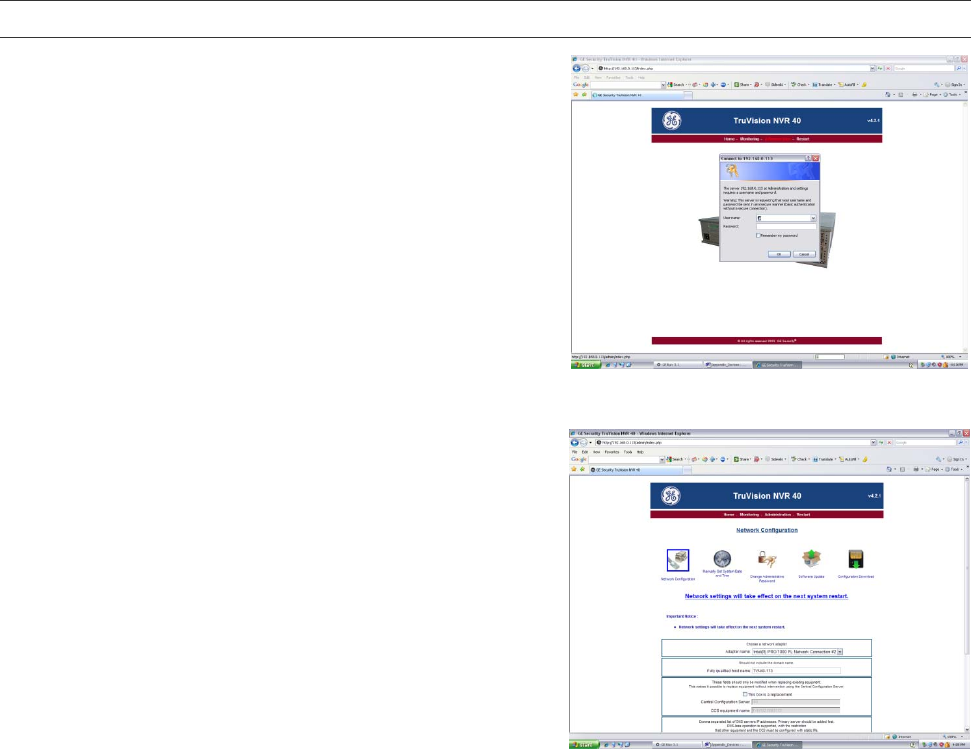
Appendix A: Device Settings
160 TruVision Navigator 5.0 Service Pack 3 User Manual
Feature Support Notes
How to assign the
TVN40 an IP
Address
The TruVision NVR 40 is designed for
configuration and installation through an
Ethernet network.
Follow these steps to change the
TVN40's default IP Address for use on
your network.
Launch your web browser and connect
to the TVN40 via its default IP Address
of 192.168.1.2.
Access the device configuration window,
by selecting Administration from the
main menu. Enter username: admin and
Password: admin on the login screen.
Select the Network Configuration icon.
Enter the appropriate network
configurations.
Click the Apply button at the bottom of
the window, to confirm the configuration.
Restart the NVR 40 unit by clicking
Restart on the Web server main menu.
Allow 3-5 minutes for the restart to
complete.
Verify that you can connect to the Web
server using the new settings.
Your TVN40 is now ready to be added
to TruVision Navigator.

Appendix A: Device Details
TruVision Navigator 5.0 Service Pack 3 User Manual 161
Feature Support Notes
How to add the
TVN40 to TruVision
Navigator
TruVision Navigator requires the TVN40
and its associated IP Cameras to be
synched to a common time. If the
devices have disparate times, problems
will occur during playback and disk
analysis.
To maintain time synchronization,
TruVision Navigator features an internal
NTP Service that should be enabled
before you add the TVN40/IP Cameras.
Please ensure the TruVision Navigator
NTP Service is enabled via the Services
dialog in TruVision Navigator.
The TruVision Navigator NTP Service
can also synch with an external
Reference Time Server to maintain the
accuracy of the entire TruVision
Navigator environment. When no
external Reference Time Server is used,
the TruVision Navigator time may drift
by a several seconds over a given year.
To avoid the drift, the TruVision
Navigator Server can be connected to
an external Reference Time Server such
as time.windows.com or time.nist.gov.
Login to TruVision Navigator. If you are
logging in for the first time, use the
default credentials of Username = admin
and Password = admin
To add the TVN40, click on the Add
Device button in the Navigator. Fill out
the Add Device form as required.
You should now see the TVN40
populated in the Navigator with NO
cameras underneath it. Only after you
configure the TVN40 and add the IP
Cameras to the TVN40, will you see
cameras underneath the device.

Appendix A: Device Settings
162 TruVision Navigator 5.0 Service Pack 3 User Manual
Feature Support Notes
How to configure
the TVN40 To configure the TVN40 right-click on
the device in the Navigator panel and
select Configure Device.
The TVN40 Configuration dialog will
open.
There are 4 tabs on this Configuration
Form: Network, Recording, Alarm, and
System.
The dialog will store your changes as
you toggle from one tab to another.
Please make all of your configurations
on the tabs first and then click Save
once. This will save you time by sending
all of the changes at one time to the unit.
The Network Tab IP Address - This field is un-editable and
represents the IP Address of the TVN40
itself. If this IP Address needs to be
changed, please delete the TVN40
(right-click and select Delete Device)
and re- add it in TruVision Navigator
with the new IP address.
NTP Server Address - THIS IS A
MANDATORY FIELD! After you have
activated the TruVision Navigator
Server’s NTP Service, enter the IP
Address of the TruVision Navigator
Server here. See the TruVision
Navigator User Manual on NTP for more
information.
MTU Size - This is the Maximum
Transmission Unit setting which defines
the data size of the packets pushed over
the network. Check with your IT
Department to see if they have network
limitations on packet size and adjust
accordingly.
Tunnel Port - This is the sole port used
for communication, command and
control, and video transmission between
TruVision Navigator and the TVN40.
3000 is the default but it can be edited
here.
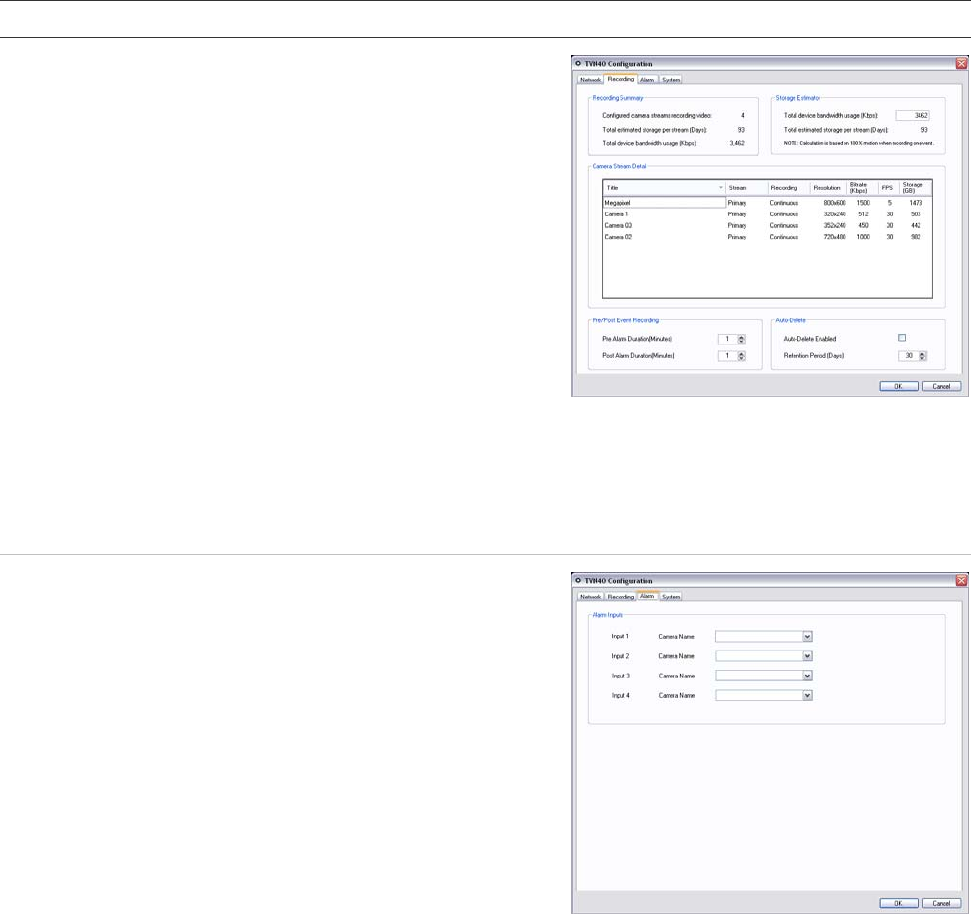
Appendix A: Device Details
TruVision Navigator 5.0 Service Pack 3 User Manual 163
Feature Support Notes
The Recording Tab Recording Summary – provides the user
an overall recording summary for the
device based upon what has been
configured.
Storage Estimator – allows the user to
simulate number of days of storage
based upon total device bandwidth
usage.
Camera Stream Detail – provides the
user a summary by stream of the
configuration details. This is not
editable. Users must right-click on the
camera in the Navigator and select
Configure Camera to change these
settings.
Pre and Post Event Recording - select
the minutes here for pre and post event
recording.
Auto Delete- set the retention period for
recorded video for the TVN40.
The Alarm Tab There are four alarm inputs on the
TVN40 that can be configured to trigger
the associated IP Cameras for Event
recording.
These fields will not be initially
populated as designated IP Cameras
must be configured to record on Event
before these menus will be populated.
Once this has been completed, the
appropriate IP Cameras will appear as
values in the dropdown box next to each
input. They can then be associated to
inputs.
Remember to come back to this form
after you setup your IP Cameras to
associate the inputs.
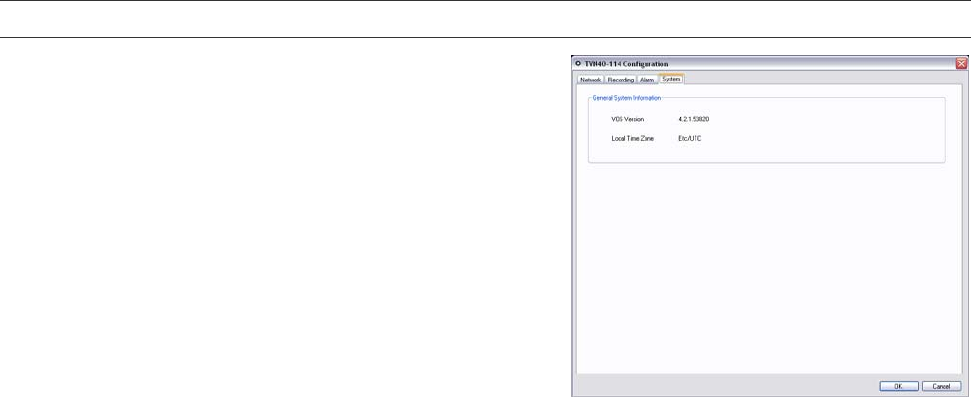
Appendix A: Device Settings
164 TruVision Navigator 5.0 Service Pack 3 User Manual
Feature Support Notes
The System Tab The System tab contains un-editable,
firmware version information for the
TVN40.
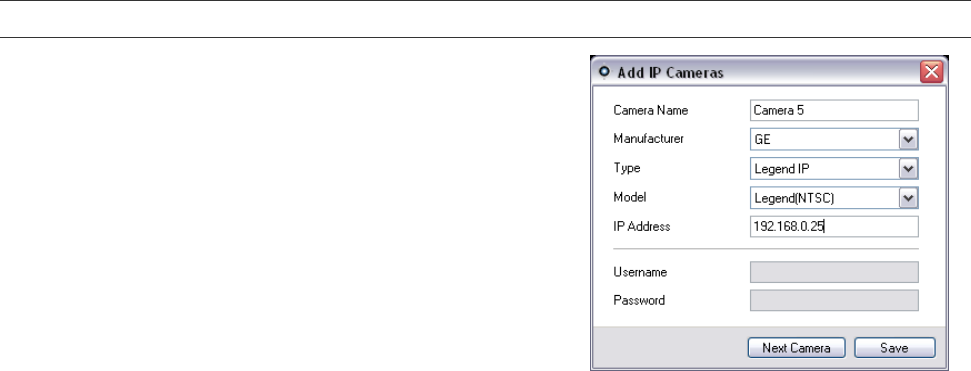
Appendix A: Device Details
TruVision Navigator 5.0 Service Pack 3 User Manual 165
Feature Support Notes
How to add IP
Cameras on the
TVN40
Once you have successfully configured
the TVN40, right-click on the TVN40 and
select Add Cameras. The Add Cameras
dialog will appear. This form is
designed to quickly add IP Cameras to
the system WITHOUT having to do deep
configuration of the IP Camera upon
time of addition. We have selected
default configurations for each IP
Camera that keep the bit rates low
enough to allow for video viewing on
most networks. Users can go back after
the cameras have been added and
viewed to make changes to those
default settings as required. This design
allows for users to quickly get up and
running and view video - IP Camera
configuration tweaks can be made after
that.
The following fields are available:
Camera Name - user-defined alpha-
numeric field
Manufacturer - select option
Type - select option
Model - select option
IP Address - enter the Static IP Address
as it is configured on the IP Camera
Username / Password - This is the
username and password for the IP
camera itself. If you have changed the
username or password for the IP
Camera, use the appropriate credentials
per your changes.
Next Camera Button - If you are adding
multiple cameras to the TVN40, simply
click this button after you fill out the
information for the first camera. Upon
clicking the button, you will see the
camera populate under the TVN40 in
the Navigator, but the Add Camera form
will remain up, so you can rapidly enter
the next camera, and so on. Repeat as
many times as you have cameras.
There is a 12 or 24 channel limit on the
device.
Save - upon finishing the data entry for
ALL IP Cameras, click the Save button.
This will send the IP Camera
configuration data for ALL cameras to
the TVN40.

Appendix A: Device Settings
166 TruVision Navigator 5.0 Service Pack 3 User Manual
Feature Support Notes
How to change the
default
configurations of
the IP Cameras on
the TVN40
If you would like to tweak the default
configurations of the IP Cameras after
they have been added, right-click on the
camera and select Configure Camera.
The Camera Configuration Form will
open in a dialog with 2 tabs - Camera
and Video.
The Camera Tab Edit any of the fields that you previously
entered on the Add Camera form.
Motion Detection - enable motion
detection for the camera with this
checkbox. This is "all or nothing" motion
detection for the cameras field of view.
There is no grid selection to detect
motion for specific areas of the field of
view at this time.
PTZ Control – if this is a PTZ camera,
make the appropriate PTZ settings here.
Ok button - when you are satisfied with
your edits on both the Camera and
Video Tabs, click the OK button to send
the changes to the TVN40.
Cancel button - should you wish to
abandon your changes simply click the
Cancel button.
The form will store your changes as you
toggle from one tab to another. Please
make all of your configurations on the
tabs first and then click OK once. This
will save you time in sending all of the
changes at one time to the unit.
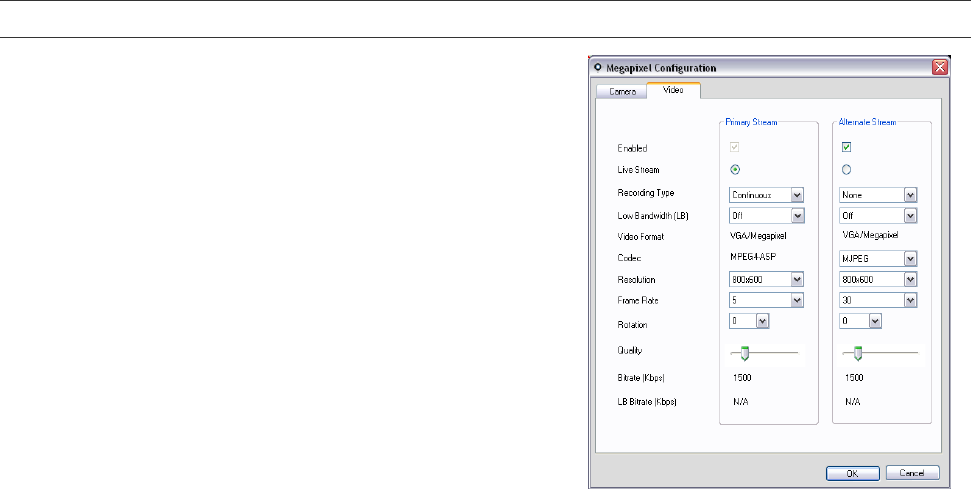
Appendix A: Device Details
TruVision Navigator 5.0 Service Pack 3 User Manual 167
Feature Support Notes
The Video Tab Enabled - For applicable cameras, you
will have the ability to enable an
Alternate Stream.
Live Stream - if there is an Alternate
Stream, you will have the ability to
designate, which one you would like to
use for Live Video.
Recording Type - Continuous, Event, or
None.
Low Bandwidth – enable the primary or
alternate stream for low bandwidth
functions including Live, Live+Recorded,
or Off.
Video Format, Codec, Resolution,
Frame Rate, and Quality are all
configurations that will affect the bit rate
of the streams. Keep in mind the
bandwidth impacts of the bit rates.
OK button - when you are satisfied with
your edits on both the Camera and
Video Tabs, click the OK button to send
the changes to the TVN40.
Cancel button - should you wish to
abandon your changes simply click the
Cancel button.

Appendix A: Device Settings
168 TruVision Navigator 5.0 Service Pack 3 User Manual
Feature Support Notes
What are the
options in the
TVN40 context
menu
When you right-click on a device or
node in the Navigator, you see a context
menu with functional choices for that
device. This purpose of this section is to
explain each of the choices with respect
to the TVN40 context menu.
Run Health Diagnostics - this option
captures the health diagnostics from the
device.
Run Disk Analysis – this option captures
a snapshot of the recorded video on the
device that is eligible for playback.
Add IP Cameras - this launches the Add
Camera form where you can bind your
IP Cameras to that particular TVN40.
Delete IP Cameras- this deletes all of
the cameras that were previously bound
to the TVN40. It also deletes all related
recorded video for those cameras on the
TVN40.
Configure Device - this launches the
TVN40 Configuration form where you
can set things such as NTP Address,
MTU Size, etc…
Upload Firmware – this allows for
firmware uploads to the device.
Reboot Device - this option reboots the
TVN40 remotely.
ReSync from Device - this option is only
available to users in Standalone or
Direct Database Connection (DDbC)
Installations. It allows the user to sync
his/her local TruVision Navigator
database with the device's current
configuration. This configuration may
have been changed by users of other
standalone TruVision Navigator systems
so this option is required to keep
multiple different standalone systems in
sync. For ultimate control over this
situation, we recommend the Tradition
Client/Server architecture where this can
be governed as needed by the
Administrator. This stands for the DVRs
as well.
Repair Device - Should, for any reason, your
TVN40's configuration become corrupted,
there are 2 options to restore it to use. When
selecting this option, you will be prompted to
select 1 of the 2 options as per below:
Last Known Configuration (Recommended):
this option takes the last known configuration
that was saved to the TVN40 out of the
TruVision Navigator Database and pushes it
again to the device. All IP Camera
configurations and recorded video storage
remain in tact with this option. -OR-
Factory Default Settings: this option restores
factory defaults on the device, except for its
IP Address - that remains the same.
However, all IP Camera configurations are
removed along with any recorded video
storage. This option also reboots the unit
upon completion of the factory default.
Delete Device - this option deletes the TVN40
from the Navigator. It does NOT delete any
configurations, IP Cameras, or storage from
the device itself.
Rename Device - this allows the user to
rename the TVN40.
Properties – this shows the Connection,
Details, Capabilities, and IP Camera
information associated with the device.
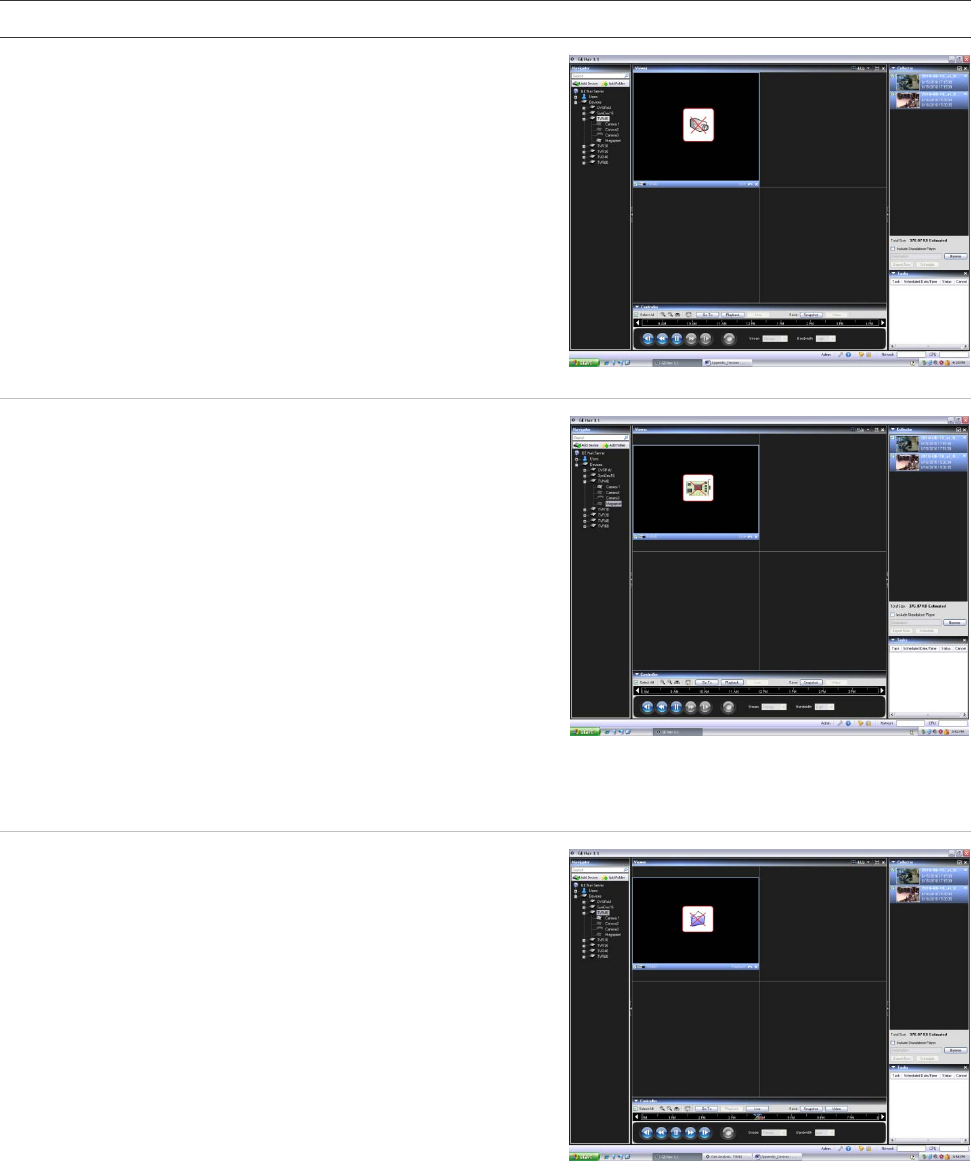
Appendix A: Device Details
TruVision Navigator 5.0 Service Pack 3 User Manual 169
Feature Support Notes
Troubleshooting –
Video Loss This means there is no video streaming
from the IP Camera itself.
Things to consider:
Ping the IP Camera for Ethernet
connectivity.
Potential IP Address conflicts on the
network.
The bit rate for the stream exceeds
bandwidth availability.
A single IP Camera has been added to
multiple TVN40s.
Check the IP Camera Browser to see if
video is loading there
Troubleshooting –
No Board This means the TVN40 could not
establish a connection with the IP
Camera.
Things to consider:
Ping the IP Camera for Ethernet
connectivity.
Potential IP Address conflicts on the
network.
The username and password for the
camera may be incorrect on the camera
configuration form.
NTSC or PAL configuration may be
incorrect.
Try restoring the default configuration of
the camera via the Restore button on
the camera configuration form.
Troubleshooting –
No Folder This means there is no recorded video
for the IP Camera per the specific
date/time.
Things to consider:
Check the record settings on the camera
to see if it is recording.
The time sync may be incorrect between
TruVision Navigator, the TVN40, and the
IP camera.
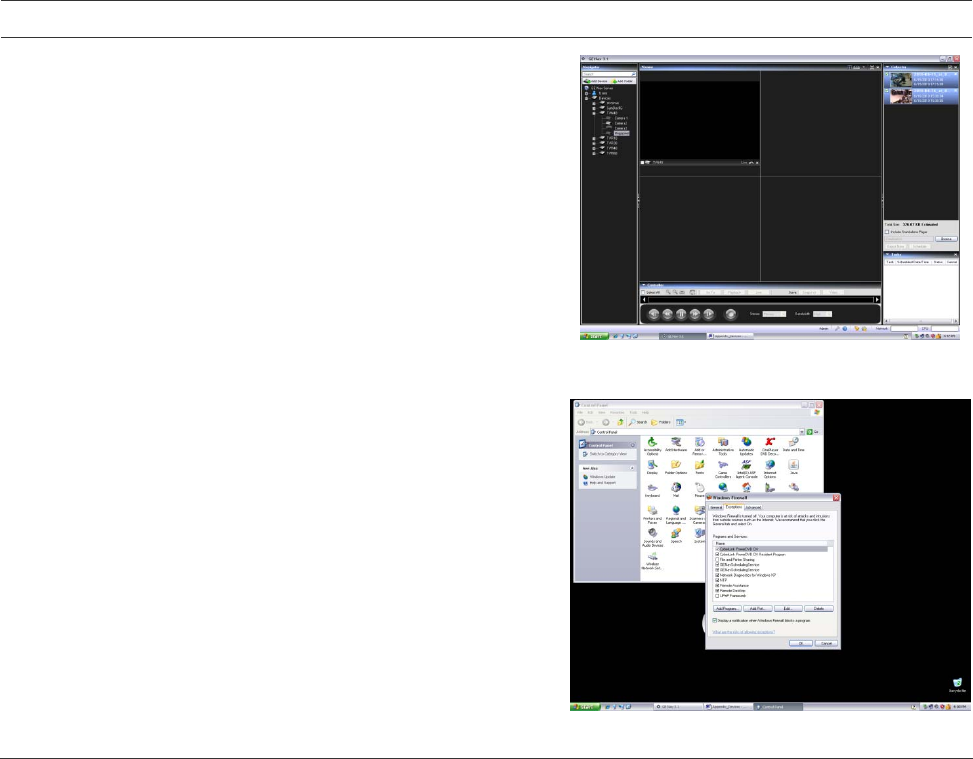
Appendix A: Device Settings
170 TruVision Navigator 5.0 Service Pack 3 User Manual
Feature Support Notes
Troubleshooting –
Black Video Tile This means something is blocking the
video stream from displaying.
Things to consider:
The 3000 port or the port you changed it
to is blocked on the network.
Anti-Virus or Windows Firewall is
blocking the video (You may need to
add TruVision Navigator to the
Application Exception List as per the
screen shot below)
Network bandwidth is too low to support
the current cameras video stream. This
is typical when configuring one or more
streams on a mega pixel camera.

Appendix A: Device Details
TruVision Navigator 5.0 Service Pack 3 User Manual 171
TruVision Software Video Recorder (SVR)
Feature Support Notes
Default Ports Video = 554 (default RTP)
Command and Control =554
(default RTP - editable)
Default Username
/ Password N/A Controlled by Windows user accounts on SVR
server
Compression H.264
Connection Types RTP
Streaming Limits Unlimited (Limits set by hardware's
configuration)
Stream Overlay Configured on IP Camera
High / Low
Bandwidth No
Dual Streaming No
Playback Controls Switch to Live
Switch to Playback
Play
Pause
Frame Advance
Fast Forward (2x, 4x, 8x)
Digital Zoom Yes Live & Playback
Snapshot Yes
Local Record Yes Pause during local record is not supported.
Instant Replay Yes
Disk Analysis Alarm
Motion
Recorded
Untagged
Video Export Yes
TruVision
Navigator Player Yes svr.video - Interlogix proprietary format
PTZ Control Yes
Focus, Iris Control Yes
Presets Yes

Appendix A: Device Settings
172 TruVision Navigator 5.0 Service Pack 3 User Manual
Feature Support Notes
Tours Yes
Camera Search Alarm
Event
Motion
Motion Yes
Audio Yes
Bi-directional
Audio No
Notifications Alarm
Video Loss
Motion
Disk Full
Disk Failure
Health Diagnostics IP Address
Firmware Version
Device Date/Time
Total Device Health
Recording Location
Recording Capacity Left(TB)
Recording Capacity Protected (TB)
Recording Retension Period
Firmware Upload No Updates must be done on host PC
Bulk Firmware
Upload No
Device
Configuration Yes
Bulk Configuration Yes
Remote Reboot No
IP Cameras See “SVR Supported Cameras List” at
www.interlogix.com for updated information.
Platform Out of Box Experience (OOBE)
TruVision Navigator provides the user a single, normalized core video user experience
across several different video platforms. Just as the user experience is normalized, the
OOBE also needs to be normalized to ensure installers and end-users have a consistent
experience in setting up a working TruVision Navigator system comprised of multiple

Appendix A: Device Details
TruVision Navigator 5.0 Service Pack 3 User Manual 173
different platforms. TruVision Navigator now supports analog DVRs, hybrid DVRs (both
analog and IP), NVRs, and TruVision SVR for COTS servers. The table below outlines
the 3 OOBEs and the differences between them.
DVR HYBRID DVR NVR
Analog cameras only Analog and IP cameras IP cameras only
DSR
DVSE
StoreSafe
DVMRe
SymDec
SymSafe
DVSRXu
TruVision TVR10
TruVision TVR11
TruVision TVR12
TruVision TVR30
TruVision TVR40
TruVision TVR42
TruVision TVR60 TruVision TVN10
TruVision TVN21
TruVision TVN50
TruVision TVN40
TruVision TVN20
TruVision SVR
STEP 1 – INSTALL DEVICE
Install device on network
Apply IP address
Make other device-level
configurations from on-screen-
display (OSD)(optional)
Install device on network
Apply IP address
Make other device-level
configurations from on-screen-
display (OSD)(optional)
Install device on network, or,
Install SVR software to a
COTS server, and place on
network
Apply IP address
STEP 2 – INSTALL CAMERAS
Install analog cameras
Physically connect cameras to
device
Make camera configurations
from device OSD (optional)
Analog Cameras
Install analog cameras
Physically connect cameras to
device
Make analog camera
configurations from device OSD
(optional)

Appendix A: Device Settings
174 TruVision Navigator 5.0 Service Pack 3 User Manual
DVR HYBRID DVR NVR
IP Cameras
Install IP cameras on network
Apply IP address
Configure IP camera via the
native browser of that IP
camera
Add IP camera to the device via
the device OSD (optional)
Install IP cameras on network
Apply IP address
UltraView, or TruVision
Encoders and IP Cameras
Install UltraView, or TruVision
Encoders and IP cameras on
network
Apply IP address
Apply NTSC or PAL
configuration (optional)
Add UltraView Encoders and IP
cameras to the device via the
device OSD (optional)
Install UltraView, TruVision
Encoders and IP cameras on
network
Apply IP address
STEP 3 – INSTALL
TRUVISION NAVIGATOR
Install TruVision Navigator
Standalone or
Traditional Client/Server
Install TruVision Navigator
Standalone or
Traditional Client/Server
Install TruVision Navigator
Standalone or
Traditional Client/Server
Enable TruVision Navigator’s
Network Time Protocol (NTP)
Service
STEP 4 – ADD DEVICE IN
TRUVISION NAVIGATOR
Add device via “Add Device”
Form (Manually or via
Discovery List)
Configure device remotely via
TruVision Navigator with the
right-click configuration feature
(optional)
Add device via “Add Device”
Form(Manually or via Discovery
List)
Configure device remotely via
TruVision Navigator with the
right-click configuration feature
(optional)
Add device via “Add Device”
Form (Manually or via
Discovery List)
After adding an SVR for the
first time, install SVR client
components by following the
instructions given by the
related dialog box
Configure device remotely via
TruVision Navigator with the
right-click configuration
feature (NTP Configuration
required)

Appendix A: Device Details
TruVision Navigator 5.0 Service Pack 3 User Manual 175
DVR HYBRID DVR NVR
STEP 5 – LICENSING (SVR
ONLY)
Add purchased SVR server
and camera licenses via
Licensing Tool located in Help
menu.
STEP 6 – BIND IP CAMERAS
TO DEVICE
Not applicable (analog
cameras are physically
connected to the device in Step
2)
Analog Cameras
Not applicable (analog cameras
are physically connected to the
device in Step 2)
They will automatically show up
under the device in the
Navigator upon addition to
TruVision Navigator
IP Cameras
IP cameras that were added via
the device OSD in Step 2 will
automatically show up under
the device in the Navigator
upon addition to TruVision
Navigator
IP cameras that were not added
via the device OSD can be
added via TruVision Navigator’s
“Add IP Camera” Form
(Manually or via Discovery Tool)
Add IP cameras to the device
via TruVision Navigator’s
“Add IP Camera” Form
(Manually or via Discovery
Tool)

Appendix A: Device Settings
176 TruVision Navigator 5.0 Service Pack 3 User Manual
DVR HYBRID DVR NVR
UltraView or TruVision
Encoders and IP Cameras
UltraView or TruVision
Encoders and IP cameras that
were added via the device OSD
in Step 2 will automatically
show up under the device in the
Navigator upon addition to
TruVision Navigator
TruVision Navigator will pull the
camera configuration, check for
valid settings based upon
TVR60 limitations, and after the
compare, either push a default
(NTSC or PAL) configuration to
the UltraView Encoders and IP
cameras or use the existing
validated configuration
UltraView or TruVision
Encoders and IP cameras that
are not added via the device
OSD can be added via
TruVision Navigator’s “Add IP
Camera” Form (Manually or via
Discovery Tool)
Add UltraView or TruVision
Encoders and IP cameras to
the device via TruVision
Navigator’s “Add IP Camera”
Form (Manually or via
Discovery Tool)
STEP 7 – ADDITIONAL
CONFIGURATION
Make additional device
configurations remotely via
TruVision Navigator’s
“Configuration” Form as
needed
Make additional device
configurations remotely via
TruVision Navigator’s
“Configuration” Form as needed
Make additional device
configurations remotely via
TruVision Navigator’s
“Configuration” Form as
needed
Make additional analog camera
configurations remotely via
TruVision Navigator’s
“Configuration” Form as
needed
Analog cameras
Make additional analog camera
configurations remotely via
TruVision Navigator’s
“Configuration” Form as needed
IP cameras
Make additional IP camera
configurations remotely via the
IP camera’s web browser as
needed (IP camera browser can
be launched from within
TruVision Navigator’s
“Configuration” Form)
Make IP camera
configurations remotely via
TruVision Navigator’s
“Configuration” Form as
needed

Appendix A: Device Details
TruVision Navigator 5.0 Service Pack 3 User Manual 177
DVR HYBRID DVR NVR
UltraView Encoders and IP
Cameras
Make additional UltraView
Encoder and IP camera
configurations remotely via
TruVision Navigator’s
“Configuration” Form as needed
Make additional UltraView
Encoder and IP camera
configurations remotely via
TruVision Navigator’s
“Configuration” Form as
needed
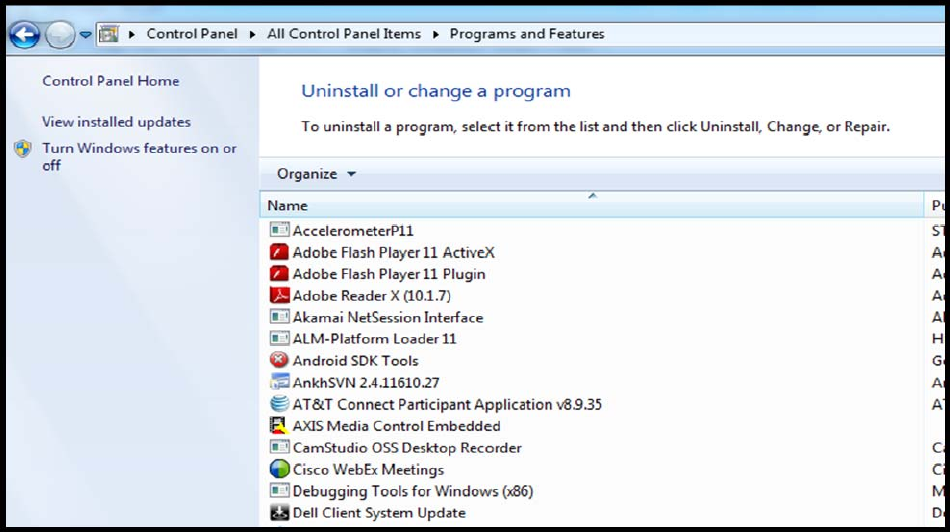
Appendix B: Microsoft IIS Setup
178 TruVision Navigator 5.0 Service Pack 3 User Manual
Appendix B
Microsoft IIS Setup
Microsoft IIS Setup
TruVision Navigator client server model requires IIS and ASP.NET to be installed in
order to operate correctly. When setting up IIS please use the following instructions.
Step 1:
Click Start Control PanelUninstall a Program OR Program & Features.
Step 2: Click on Turn Windows Features on or off on left side panel. To enable the
IIS, select the Internet Information Services option:

Appendix B: Microsoft IIS Setup
TruVision Navigator 5.0 Service Pack 3 User Manual 179
Step 3: Expand the “Internet Information Services” and then expand the “World Wide
Web Services” and “Application Development Features”. Check the check Box
ASP.NET. All other check boxes should already be checked automatically as shown in
the figure below.

Appendix B: Microsoft IIS Setup
180 TruVision Navigator 5.0 Service Pack 3 User Manual
Note: Windows 8 has slightly different options for ASP.NET. Please select ASP.NET 4.5
as shown in the following figure.
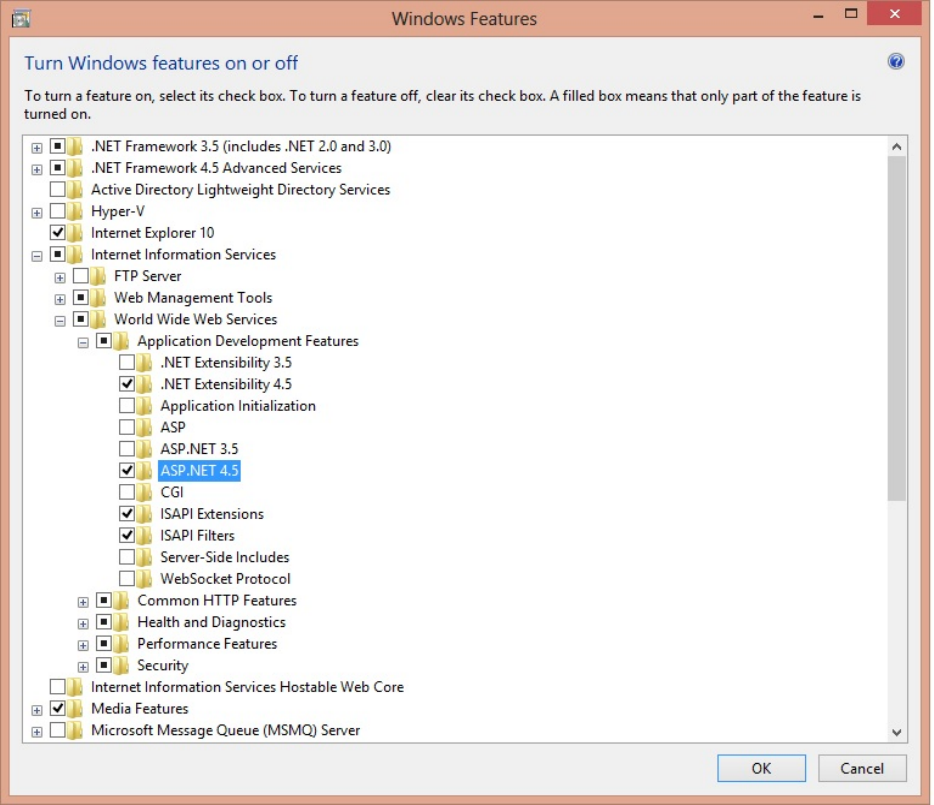
Appendix B: Microsoft IIS Setup
TruVision Navigator 5.0 Service Pack 3 User Manual 181
Step: 4. Click the OK button and then wait until the IIS is installed with all the ASP.Net
features.
Note: If IIS is already enabled but not configured for ASP.NET, repeat the steps 3 and 4
to enable the ASP.Net feature